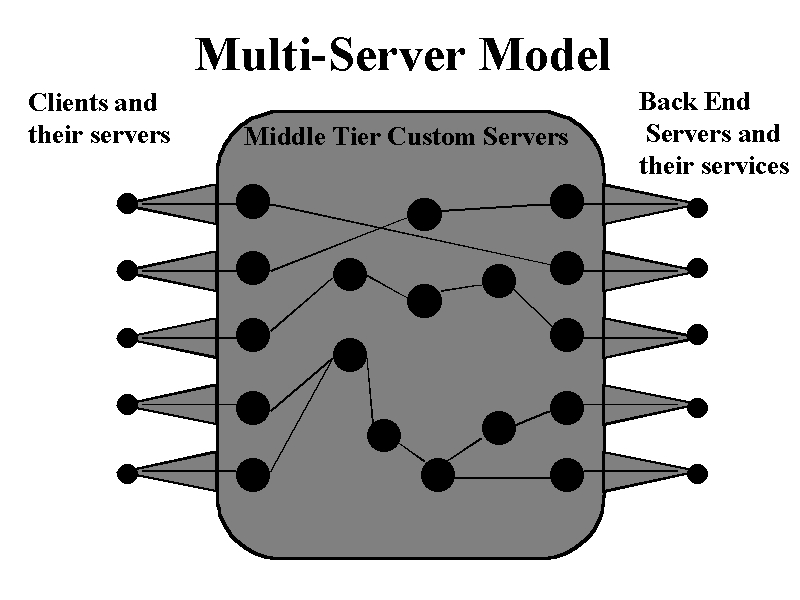
New Systems Technologies and Software Products for HPCC:
Volume III - High Performance Commodity Computing on the Pragmatic Object Web
Geoffrey C. Fox, Wojtek Furmanski, Hasan T. Ozdemir and Shrideep Pallickara
Northeast Parallel Architectures Center, Syracuse University
111 College Place, Syracuse University, Syracuse NY 13244-4100
{gcf, furm, timucin, shrideep} @ npac.syr.edu
Technology Assessment Report for RCI, Ltd., October 1998
Abstract
In this paper, we describe an approach to high performance computing which makes extensive use of commodity technologies. In particular, we exploit new Web technolgies such as XML, CORBA and COM based distributed objects and Java. The use of commodity hardware (workstation and PC based MPP's) and operating systems (UNIX, Linux and Windows NT) is relatively well established. We propose extending this strategy to the programming and runtime environments supporting developers and users of both parallel computers and large scale distributed systems. We suggest that this will allow one to build systems that combine the functionality and attractive user environments of modern enterprise systems with delivery of high performance in those application components that need it. Critical to our strategy is the observation that HPCC applications are very complex but typically only require high performance in parts of the problem. These parts are dominant when measured in terms of compute cycles or data-points but often a modest part of the problem if measured in terms of lines of code or other measures of implementation effort. Thus rather than building such systems heroically from scratch, we suggest starting with a modest performance but user friendly system and then selectively enhancing performance when needed. In particular, we view the emergent generation of distributed object and component technologies as crucial for encapsulating performance critical software in the form of reusable plug-and play modules. We review here commodity approaches to distributed objects by four major stakeholders: Java by Sun Microsystems, CORBA by Object Management Group, COM by Microsoft and XML by the World-Wide Web Consortium. Next, we formulate our suggested integration framework called Pragmatic Object Web in which we try to mix-and-match the best of Java, CORBA, COM and XML and to build a practical commodity based middleware and front-ends for today’s high performance computing backends. Finally, we illustrate our approach on a few selected application domains such as WebHLA for Modeling and Simulation and Java Grande for Scientific and Engineering Computing.
1. Introduction *
2. Pragmatic Object Web and Commodity Systems
2.1 DcciS: Distributed commodity computing and information System
*2.2 Commodity Technologies for HPcc
*2.3 From Three- to Multi-Tier HPcc
*2.4 Commodity Services for HPcc
*2.4.1 Distributed Collaboration Mechanisms
*2.4.2 Object Web and Distributed Simulation
*2.4.3 Visual Metacomputing
*3. Hybrid High Performance Systems
*3.1 Multidisciplinary Application
*3.2 Publish / Subscribe Model for HPcc
*3.3 Example: WebFlow over Globus for Nanmomaterials Monte Carlo Simulation
*4. Pragmatic Object Web – Stakeholders
*4.1 Java
*4.1.1 Java Beans
*4.1.2 Java RMI
*4.1.3 JINI
*4.2 CORBA by OMG
*4.2.1 Object Request Broker
*4.2.2 IIOP - Internet Inter-ORB Protocol
*4.2.3 The Object Management Architecture Model
*4.2.4 Interface Definition Language
*4.2.5. CORBA 3.0
*4.3 COM by Microsoft
*4.4 XML based WOM by W3C
*5. Pragmatic Object Web – Integration Concepts and Prototypes
*5.1 JWORB based Middleware
*5.2 RTI vs IIOP Performance Analysis
*5.2.1 Image Processing
*5.2.2 Benchmarking Callbacks
*5.3 Wrapping Legacy Codes
*5.4 Web Linked Databases
*5.5 Universal Persistence Models
*5.6 Visual HPcc Componentware
*5.7 WebFlow – Current Prototype
*5.8 WebFlow meets CORBA and Beans
*5.9 WebFlow – Next Steps Towards Visual POW
*6. Example of POW Application Domain - WebHLA
*6.1 Introduction to WebHLA
*6.2 WebHLA Components
*6.2.1 Object Web RTI
*6.2.2 Visual Authoring Tools for HLA Simulations
*6.2.3 Parallel ports of selected M&S modules
*6.2.4 Database and data mining back-ends
*6.2.5 Realtime multiplayer gaming front-ends
*6.3 Emergent WebHLA Applications
*6.3.1 Distance Training
*6.3.2 Metacomomputing FMS
*6.3.4 High Performance RTI
*6.3.5 IMPORT / PANDA Training
*6.3.6 Commodity Cluster Management
*6.3.7 Simulation Based Acquisition
*6.4 Towards POW VM
*6.4.1 Commodity Clusters
*6.4.2 DirectPlay meets RTI
*6.4.3 XML Scripting and Agents
*6.4.4 POW VM Architecture
*6.5 Summary
*7. Java Grande and High Performance Java
*7.1 Roles of Java in Technical Computing
*7.2 Why Explore Java as a Technical Computing Language?
*7.3 Java Grande
*7.4 Java Seamless Computing Framework or CORBA Facility for Computation
*7.5 Parallelism in Java
*7.6 HPspmd and HPJava: Pragmatic Data Parallelism
*7.7 Java links to MPI
*8. HPcc and Parallel Computing
*9. Conclusions: A Multi Tier Grande Computing System
*10. Acknowledgements
*11. References
*12 Glossary
*
In this paper, we describe an approach to high performance computing which makes extensive use of commodity technologies. In particular, we exploit Web technology, distributed objects and Java. The use of commodity hardware (workstation and PC based MPP's) and operating systems (UNIX, Linux and Windows NT) is relatively well established. We propose extending this strategy to the programming and runtime environments supporting developers and users of both parallel computers and large scale distributed systems. We suggest that this will allow one to build systems that combine the functionality and attractive user environments of modern enterprise systems with delivery of high performance in those application components that need it. Critical to our strategy is the observation that HPCC applications are very complex but typically only require high performance in parts of the problem. These parts are dominant when measured in terms of compute cycles or data-points but often a modest part of the problem if measured in terms of lines of code or other measures of implementation effort. Thus rather than building such systems heroically from scratch, we suggest starting with a modest performance but user friendly system and then selectively enhancing performance when needed.
In section 2, we describe key relevant concepts that are emerging in the innovative technology cauldron induced by the merger of multiple approaches to distributed objects and Web system technologies. This cauldron is largely fueled by development of corporate Intranets and broad based Internet applications including electronic commerce and multimedia. We define the "Pragmatic Object Web" approach which recognizes that there is not a single "best" approach but several co-existing technology bundles within an object based web. In particular, CORBA (Corporate Coalition), COM (Microsoft), JavaBeans/RMI (100% pure Java), and XML/WOM/DOM (from World Wide Web Consortium) have different tradeoffs. One can crudely characterize them as the most general, the highest performance, the most elegant and simplest distributed object models respectively. This merger of web and distributed object capabilities is creating remarkably powerful distributed systems architecture.


However the multiple standards -- each with critical capabilities -- implies that one cannot choose a single approach but rather must pragmatically pick and choose from diverse inter-operating systems. Another key community concept is that of a multi-tier enterprise system where one no longer expects a simple client server system. Rather clients interact with a distributed system of servers, from which information is created by the interactions of modular services, such as the access to and filtering of data from a database. In the Intranet of a modern corporation, these multiple servers reflected both the diverse functionality and geographical distribution of the components of the business information ecosystem.
It has been estimated that typical Intranets support around 50 distinct applications whose integration is an area of great current interest. This middle tier of distributed linked servers and services gives new Operating System challenges and is current realization of the WebWindows concept we described in an earlier RCI article [43]. Note that Java is often the language of choice for building this tier but the object model and communication protocols can reflected any of the different standards CORBA, COM, Java or WOM. The linked continuum of servers shown in Figure 1.1, reflects the powerful distributed information integration capabilities of the Pragmatic Object Web.
In Section 3, we present our basic approach to achieving high performance within the pragmatic object web (POW) multi-tier model. We make the simple observation that high performance is not always needed but rather that one needs hybrid systems combining modest performance high functionality components of the commodity Intranet with selected high performance enhancements. We suggest a multi-tier approach exploiting the separation between invocation and implementation of a data transfer that is in fact natural in modern publish-subscribe messaging models. We illustrate this HPcc -- High Performance commodity computing -- approach with a Quantum Monte Carlo application integrating NPAC's WebFlow client and middle tier technology with Globus as the back end high performance subsystem.
In the following Sections, we refine these basic ideas. In Section 4, we present the four major players on the Pragmatic Object Web scene – Java, CORBA, COM and WOM. This is followed in section 5 by the discussion of POW integration concepts and prototypes. We describe there the natural POW building block JWORB -- a server written in Java which supports all 4-object models. In particular JWORB builds its Web Services in terms of basic CORBA capabilities. We present performance measurements which emphasis the need to enhance the commodity tier when high performance messaging is needed. We discuss how JWORB allows us to develop HPCC componentware by using the JavaBean visual-computing model on top of this infrastructure. We describe application integration and multidisciplinary problems in this framework.
In section 6, we discuss the new DMSO (Defense Modeling and Simulation Office) HLA (High Level Architecture) and RTI (Run Time Infrastructure) standards. These can naturally be incorporated into HPcc, giving the WebRTI runtime and WebHLA distributed object model. These concepts suggest a novel approach to general metacomputing, built in terms of a coarse grain event based runtime to federate, manage and schedule resources. This defines a HPcc "virtual machine" which is used to define the coarse grain distributed structure of applications.
We return to the HPCC mainstream in Section 7, where we present Java Grande - an application of Web technologies to the finer grain aspects of scientific computing - including the use of the Java language to express sequential and parallel scientific kernels.
Section 8 discusses parallel computing in the HPcc framework and Section 9 summarizes general implications for the architecture of a Grande computing environment.
We recommend a recent book [60] covering high performance distributed computing for a coverage that focuses more on the HPCC as opposed commodity software issues but with a similar vision for ubiquitous access to computing resources.
We note that we conclude with an extensive glossary as there are surely a lot of acronyms in this complicated field!
2. Pragmatic Object Web and Commodity Systems
2.1 DcciS: Distributed commodity computing and information System
We believe that industry and the loosely organized worldwide collection of (freeware) programmers is developing a remarkable new software environment of unprecedented quality and functionality. We call this DcciS - Distributed commodity computing and information System. We believe that this can benefit HPCC in several ways and allow the development of both more powerful parallel programming environments and new distributed metacomputing systems. In Section 2.2, we define what we mean by commodity technologies and explain the different ways that they can be used in HPCC. In Section 2.3, we define an emerging architecture of DcciS in terms of a conventional 3 tier commercial computing model, augmented by distributed object and component technologies of Java, CORBA, COM and the Web. This is followed in Sections 2.4 and 2.5 by more detailed discussion of the HPcc core technologies and high-level services.
In this and related papers [7][8][10][11][12][19], we discuss several examples to address the following critical research issue: can high performance systems - called HPcc or High Performance Commodity Computing - be built on top of DcciS. Examples include integration of collaboration into HPcc; the natural synergy of distribution simulation and the HLA standard with our architecture; and the step from object to visual component based programming in high performance distributed computing. Our claim, based on early experiments and prototypes is that HPcc is feasible but we need to exploit fully the synergies between several currently competing commodity technologies. We present here our approach at NPAC within the general context of DcciS which is based on integrating several popular distributed object frameworks. We call it Pragmatic Object Web and we describe a specific integration methodology based on multi-protocol middleware server, JWORB - Java Web Object Request Broker.
2.2 Commodity Technologies for HPcc
The last three years have seen an unprecedented level of innovation and progress in commodity technologies driven largely by the new capabilities and business opportunities of the evolving worldwide network. The Web is not just a document access system supported by the somewhat limited HTTP protocol. Rather it is the distributed object technology which can build general multi-tiered enterprise Intranet and Internet applications. CORBA is turning from a sleepy heavyweight standards initiative to a major competitive development activity that battles with COM, JavaBeans and new W3C object initiatives to be the core distributed object technology.
There are many driving forces and many aspects to DcciS but we suggest that the three critical technology areas are the Web, distributed objects and databases. These are being linked and we see them subsumed in the next generation of "object-web" [2] technologies, which is illustrated by the recent Netscape and Microsoft version 4 browsers. Databases are older technologies but their linkage to the web and distributed objects, is transforming their use and making them more widely applicable.
In each commodity technology area, we have impressive and rapidly improving software artifacts. As examples, we have at the lower level the collection of standards and tools such as HTML, HTTP, MIME, IIOP, CGI, Java, JavaScript, JavaBeans, CORBA, COM, ActiveX, VRML, new powerful object brokers (ORB's), dynamic Java clients and servers including applets and servlets, and new W3C technologies towards the Web Object Model (WOM) such as XML, DOM and RDF.
At a higher level collaboration, security, commerce, multimedia and other applications/services are rapidly developing using standard interfaces or frameworks and facilities. This emphasizes that equally and perhaps more importantly than raw technologies, we have a set of open interfaces enabling distributed modular software development. These interfaces are at both low and high levels and the latter generate a very powerful software environment in which large preexisting components can be quickly integrated into new applications. We believe that there are significant incentives to build HPCC environments in a way that naturally inherits all the commodity capabilities so that HPCC applications can also benefit from the impressive productivity of commodity systems. NPAC's HPcc activity is designed to demonstrate that this is possible and useful so that one can achieve simultaneously both high performance and the functionality of commodity systems.
Note that commodity technologies can be used in several ways. This article concentrates on exploiting the natural architecture of commodity systems but more simply, one could just use a few of them as "point solutions". This we can term a "tactical implication" of the set of the emerging commodity technologies and illustrate below with some examples :
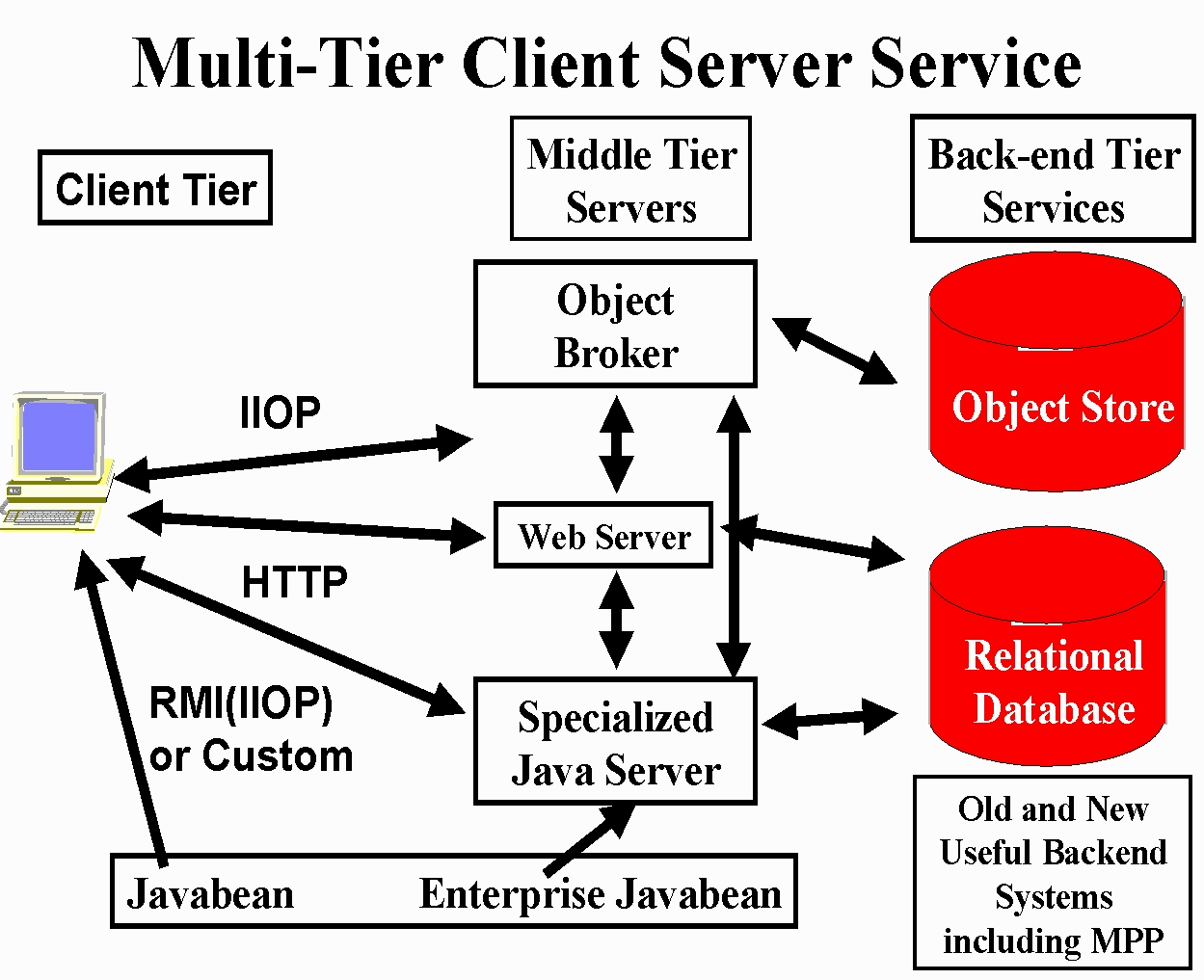
Figure 2.1:
Industry 3-tier view of enterprise Computing
However probably more important is the strategic impact of DcciS which implies certain critical characteristics of the overall architecture for a high performance parallel or distributed computing system. First we note that we have seen over the last 30 years many other major broad-based hardware and software developments -- such as IBM business systems, UNIX, Macintosh/PC desktops, video games -- but these have not had profound impact on HPCC software. However we suggest the DcciS is different for it gives us a world-wide/enterprise-wide distributing computing environment. Previous software revolutions could help individual components of a HPCC software system but DcciS can in principle be the backbone of a complete HPCC software system -- whether it be for some global distributed application, an enterprise cluster or a tightly coupled large scale parallel computer.
In a nutshell, we suggest that "all we need to do" is to add "high performance" (as measured by bandwidth and latency) to the emerging commercial concurrent DcciS systems. This "all we need to do" may be very hard but by using DcciS as a basis we inherit a multi-billion dollar investment and what in many respects is the most powerful productive software environment ever built. Thus we should look carefully into the design of any HPCC system to see how it can leverage this commercial environment.
2.3 From Three- to Multi-Tier HPcc
We start with a common modern industry view of commodity computing with the three tiers shown in Figure 2.1. Here we have customizable client and middle tier systems accessing "traditional" back end services such as relational and object databases. A set of standard interfaces allows a rich set of custom applications to be built with appropriate client and middleware software. As indicated on figure, both these two layers can use web technology such as Java and JavaBeans, distributed objects with CORBA and standard interfaces such as JDBC (Java Database Connectivity). There are of course no rigid solutions and one can get "traditional" client server solutions by collapsing two of the layers together. For instance with database access, one gets a two tier solution by either incorporating custom code into the "thick" client or in analogy to Oracle's PL/SQL, compile the customized database access code for better performance and incorporate the compiled code with the back end server. The latter like the general 3-tier solution, supports "thin" clients such as the currently
popular network computer. Actually the "thin client" is favored in consumer markets due to cost and in corporations due to the greater ease of managing (centralized) server compared to (chaotic distributed) client systems.
The commercial architecture is evolving rapidly and is exploring several approaches which co-exist in today's (and any realistic future) distributed information system. The most powerful solutions involve distributed objects. Currently, we are observing three important commercial object systems
- CORBA, COM and JavaBeans, as well as the ongoing efforts by the W3C, referred by some as WOM (Web Object Model), to define pure Web object/component standards. These have similar approaches and it is not clear if the future holds a single such approach or a set of interoperable standards.
CORBA[34] is a distributed object standard managed by the OMG (Object Management Group) comprised of 700 companies. COM is Microsoft's distributed object technology initially aimed at Window machines. JavaBeans (augmented with RMI and other Java 1.1 features) is the "pure Java" solution - cross platform but unlike CORBA, not cross-language! Finally, WOM is an emergent Web model that uses new standards such as XML, RDF and DOM to specify respectively the dynamic Web object instances, classes and methods.
Legion [18] is an example of a major HPCC focused distributed object approach; currently it is not built on top of one of the four major commercial standards discussed above. The HLA/RTI [9] standard for distributed simulations in the forces modeling community is another important domain specific distributed object system. It appears to be moving to integration with CORBA standards.
Although a distributed object approach is attractive, most network services today are provided in a more ad-hoc fashion. In particular today's web uses a "distributed service" architecture with HTTP middle tier servers invoking via the CGI mechanism, C and Perl programs linking to databases, simulations or other custom services. There is a trend toward the use of Java servers with the servlet mechanism for the services. This is certainly object based but does not necessarily implement the standards implied by CORBA, COM or JavaBeans. However, this illustrates an important evolution as the web absorbs object technology with the evolution from low- to high-level network standards:
As an example consider the evolution of networked databases. Originally these were client-server with a proprietary network access protocol. In the next step, Web linked databases produce a three tier distributed service model with an HTTP server using a CGI program ( running Perl for instance) to access the database at the backend. Today we can build databases as distributed objects with a middle tier JavaBean using JDBC to access the backend database. Thus a conventional database is naturally evolving to the concept of managed persistent objects.
Today as shown in Figure 2.2, we see a mixture of distributed service and distributed object architectures. CORBA, COM, JavaBean, HTTP Server + CGI, Java Server and servlets, databases with specialized network accesses, and other services co-exist in the heterogeneous environment with common themes but disparate implementations. We believe that there will be significant convergence as a more uniform architecture is in everyone's best interest.
We also believe that the resultant architecture will be integrated with the web so that the latter will exhibit distributed object architecture shown in Figure 2.3.
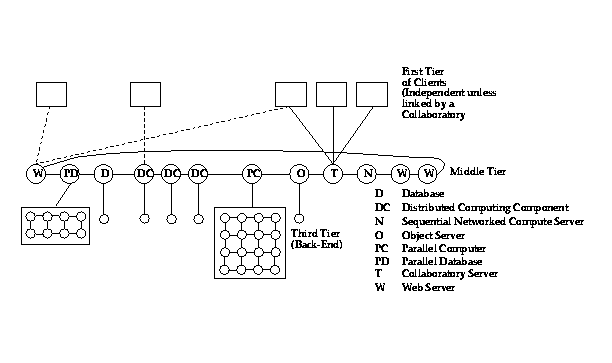
Figure 2.2:
Today's Heterogeneous Interoperating Hybrid Server Architecture. HPcc involves adding to this system, high performance in the third tier.
More generally the emergence of IIOP (Internet Inter-ORB Protocol), CORBA2-->CORBA3, rapid advances with the Microsoft's COM, DCOM, and COM+, and the realization that both CORBA and COM are naturally synergistic with Java is starting a new wave of "Object Web" developments that could have profound importance.
Java is not only a good language to build brokers but also Java objects are the natural inhabitants of object databases. The resultant architecture in Figure 2.3 shows a small object broker (a so-called ORBlet) in each browser as in Netscape's current systems. Most of our remarks are valid for all browser models and for various approaches to a distributed set of services. Our ideas are however easiest to understand if one assumes an underlying architecture which is a CORBA or JavaBean distributed object model integrated with the Web. We wish to use this service/object evolving 3-tier commodity architecture as the basis of our HPcc environment.
We need to naturally incorporate (essentially) all services of the commodity web and to use its protocols and standards wherever possible. We insist on adopting the architecture of commodity distribution systems as complex HPCC problems require the rich range of services offered by the broader community systems. Perhaps we could "port" commodity services to a custom HPCC system but this would require continued upkeep with each new upgrade of the commodity service.
By adopting the architecture of the commodity systems, we make it easier to track their rapid evolution and expect it will give high functionality HPCC systems, which will naturally track the evolving Web/distributed object worlds. This requires us to enhance certain services to get higher performance and to incorporate new capabilities such as high-end visualization (e.g. CAVE's) or massively parallel systems where needed. This is the essential research challenge for HPcc for we must not only enhance performance where needed but do it in a way that is preserved as we evolve the basic commodity systems.
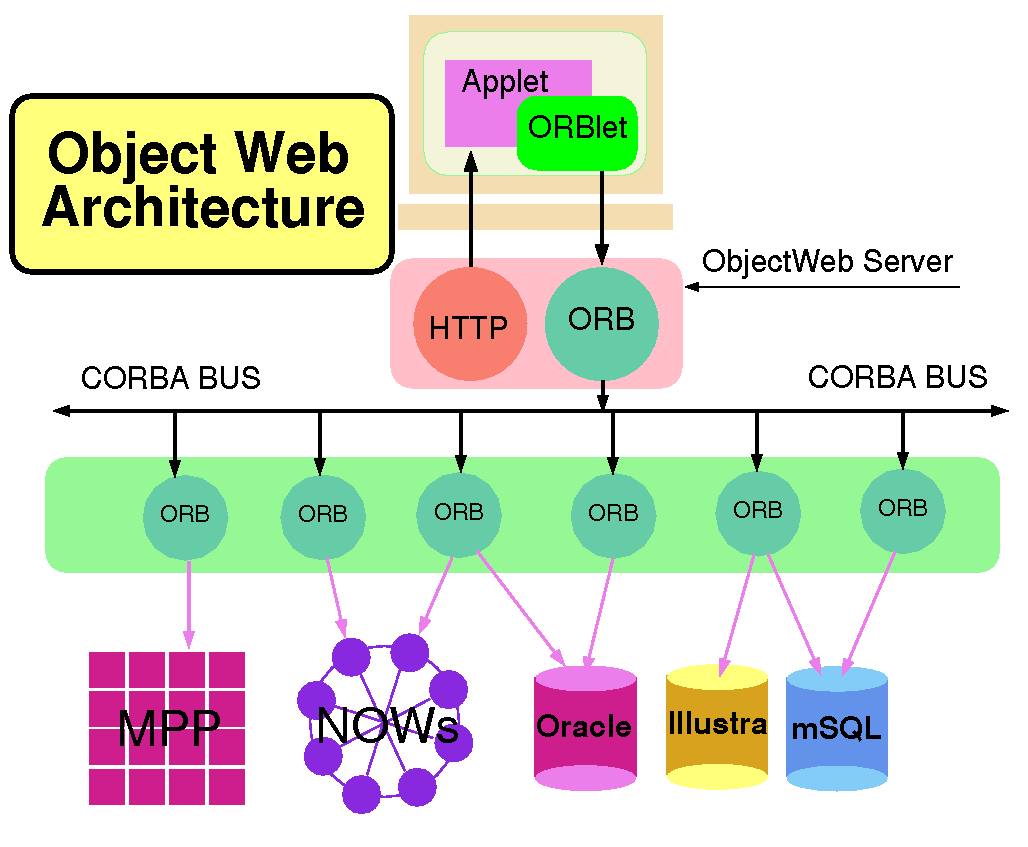
Figure 2.3:
Integration of Object Technologies (CORBA) and the Web
Thus we exploit the three-tier structure and keep HPCC enhancements in the third tier, which is inevitably the home of specialized services in the object-web architecture. This strategy isolates HPCC issues from the control or interface issues in the middle layer. If successful we will build an HPcc environment that offers the evolving functionality of commodity systems without significant re-engineering as advances in hardware and software lead to new and better commodity products.
Returning to Figure 2.2, we see that it elaborates Figure 2.1 in two natural ways. Firstly the middle tier is promoted to a distributed network of servers; in the "purest" model these are CORBA/ COM/ JavaBean object-web servers as in Figure 2.3, but obviously any protocol compatible server is possible.
This middle tier layer includes not only networked servers with many different capabilities (increasing functionality) but also multiple servers to increase performance on an given service.
2.4 Commodity Services for HPcc
We have already stressed that a key feature of HPcc is its support of the natural inclusion into the environment of commodity services such as databases, web servers and object brokers. Here we give some further examples of commodity services that illustrate the power of the HPcc approach.
2.4.1 Distributed Collaboration Mechanisms
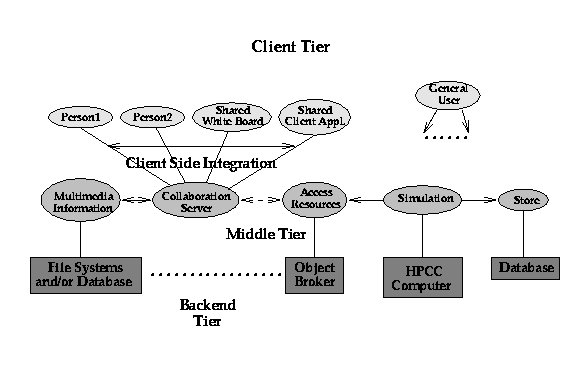
Figure 2.4:
Collaboration in today's Java Web Server implementation of the 3 tier computing model. Typical clients (on top right) are independent but Java collaboration systems link multiple clients through object (service) sharing
The current Java Server model for the middle tier naturally allows one to integrate collaboration into the computing model and our approach allows one to "re-use" collaboration systems built for the general Web market. Thus one can without any special HPCC development, address areas such as computational steering and collaborative design, which require people to be integrated with the computational infrastructure. In Figure 2.4, we define collaborative systems as integrating client side capabilities together. In steering, these are people with analysis and visualization software. In engineering design, one would also link design (such as CATIA or AutoCAD) and planning tools. In both cases, one would need the base collaboration tools such as white-boards, chat rooms and audio-video. If we are correct in viewing collaboration (see Tango [16] and Habanero [17]) as sharing of services between clients, the 3-tier model naturally separates HPCC and collaboration. This allows us to integrate into the HPCC environment, the very best commodity technology which is likely to come from larger fields such as business or (distance) education. Currently commodity collaboration systems are built on top of the Web and although emerging CORBA facilities such as workflow imply approaches to collaboration, they are not yet defined from a general CORBA point of view. We assume that collaboration is sufficiently important that it will emerge as a CORBA capability to manage the sharing and replication of objects. Note CORBA is a server-server model and "clients" are viewed as servers (i.e. run Orb's) by outside systems. This makes the object-sharing view of collaboration natural whether application runs on "client" (e.g. shared Microsoft Word document) or on back-end tier as in case of a shared parallel computer simulation.
In Section 5.2.2 we illustrate one of POW approaches to collaboration on the example of our JDCE prototype that integrates CORBA and Java/RMI based techniques for sharing remote objects. In Section 6.2.5, we also point out that the HLA/RTI framework for Modeling and Simulation can be naturally adapted for collaboratory applications such as distance training, conducted in a multiplayer real-time interactive gaming framework.
2.4.2 Object Web and Distributed Simulation
The integration of HPCC with distributed objects provides an opportunity to link the classic HPCC ideas with those of DoD's distributed simulation DIS or Forces Modeling FMS community. The latter do not make extensive use of the Web these days but they have a longer term commitment to CORBA with their HLA (High Level Architecture) and RTI (Runtime Infrastructure) initiatives. Distributed simulation is traditionally built with distributed event driven simulators managing C++ or equivalent objects. We suggest that the Object Web (and parallel and distributed ComponentWare described in sec. 5.3) is a natural convergence point for HPCC and DIS/FMS. This would provide a common framework for time stepped, real time and event driven simulations. Further it will allow one to more easily build systems that integrate these concepts as is needed in many major DoD projects -- as exemplified by the FMS and IMT DoD computational activities which are part of the DoD HPC Modernization program.
We believe that the integration of Web, Enterprise, Desktop and Defense standards proposed by our Pragmatic Object Web methodology will lead to powerful new generation systems capable to address in affordable way the new computational challenges faced by the DoD such as Virtual Prototyping for Simulation Based Acquisiton.
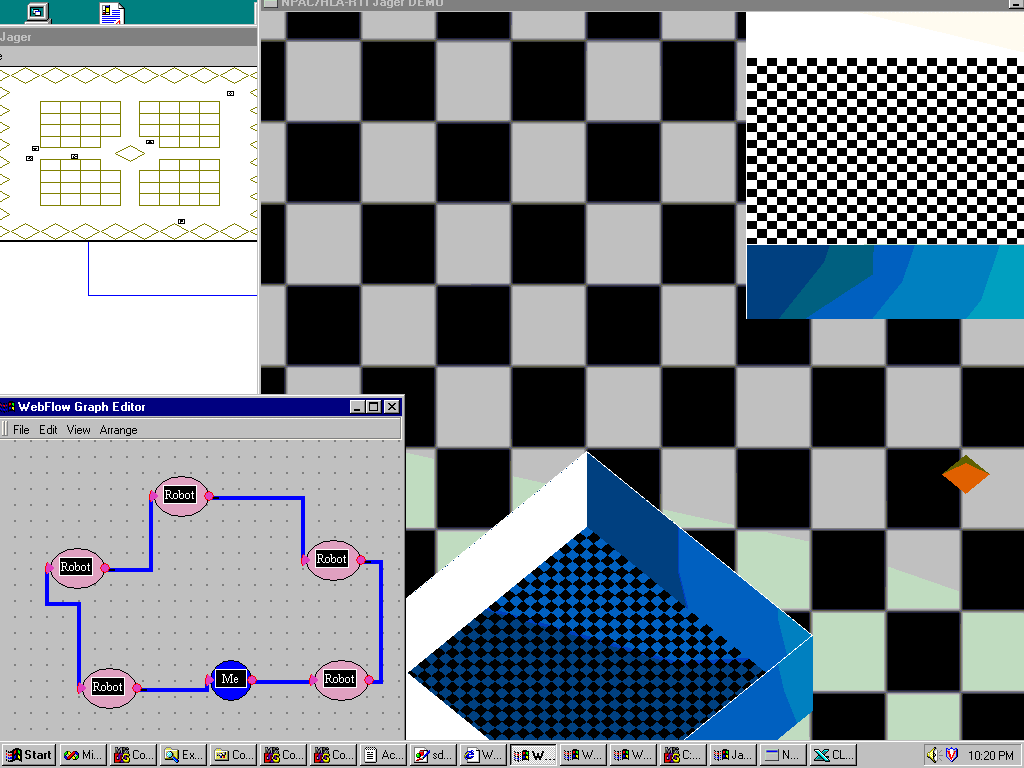
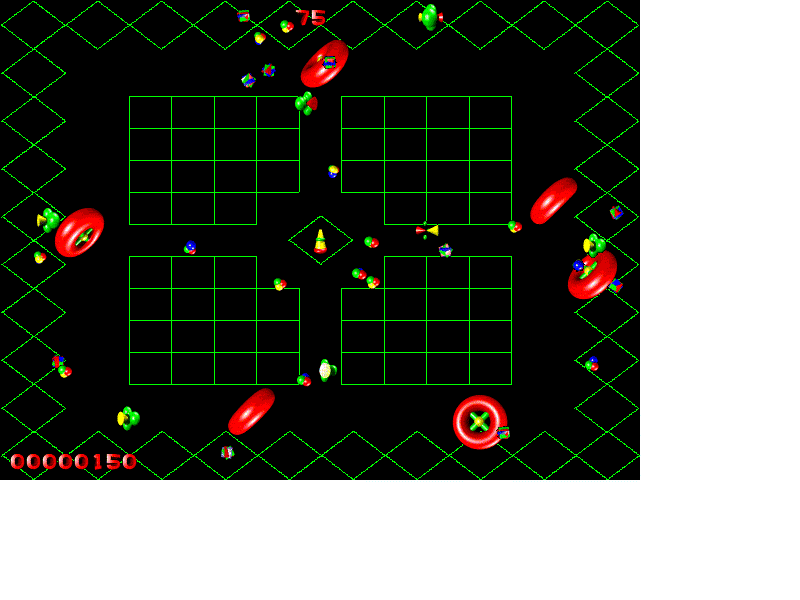
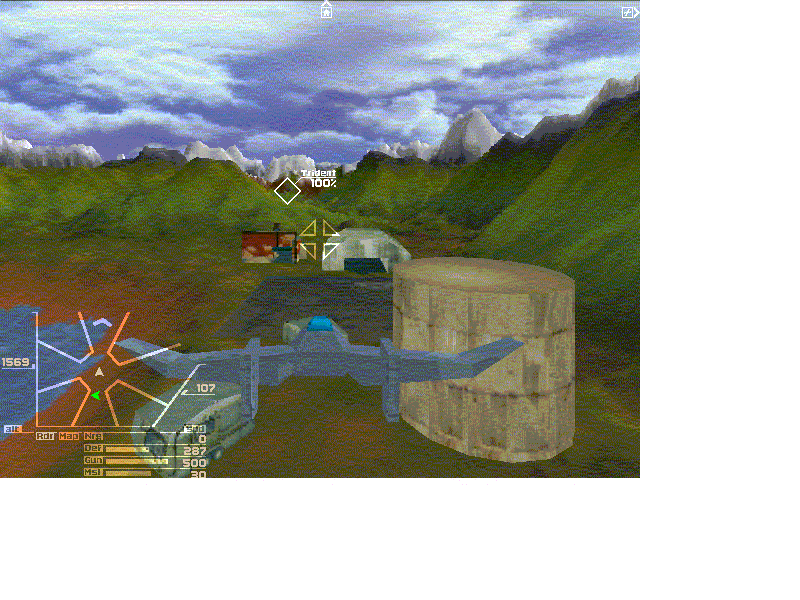
Figure 2.5:
Sample screendumps from the POW based visual authoring (upper frame) and multimedia runtime (lower frames) environment for Jager game – a standard Modeling and Simulation application distriburted by DMSO as part of the RTI release.
Fig 2.5 illustrates the current snapshot of our work in this area discussed in Section 6. The figure also includes an HLA/RTI application (DMSO Jager) running on top of POW middleware (OWRTI) and integrated first with our WebFlow visual authoring front-end (upper screen) and then with the DirectX multimedia front-ends from Microsoft (lower screens).
The growing heterogeneous collection of components, developed by the Web / Commodity computing community, offers already now a powerful and continuously growing computational infrastructure of what we called DcciS – Distributed commodity computing and information System. However, due to the vast volume and multi-language multi-platform heterogeneity of such a repository, it is also becoming increasingly difficult to make the full use of the available power of this software. In our POW approach, we provide an efficient integration framework for several major software trends but the programmatic access at the POW middleware is still complex as it requires programming skills in several languages (C++, Java, XML) and distributed computing models (CORBA, RMI, DCOM). For the end users, integrators and rapid prototype developers, a more efficient approach can be offered via the visual programming techniques. Visual authoring frameworks such as Visual Basic for Windows GUI development, AVS/Khoros for scientific visualization, or UML based Rational Rose for Object Oriented Analysis and Design are successfully tested and enjoy growing popularity in the respective developer communities. Several visual authoring products appeared also recently on the Java developers market including Visual Studio, Visual Age for Java, JBuilder or J++.
HPC community has also explored visual programming in terms of custom prototypes such as HeNCE or CODE, or adaptation of commodity systems such as AVS. At NPAC, we are developing a Web based visual programming environment called WebFlow. Our current prototype summarized below and discussed in detail in Section 5.7 follows the 100% Java model and is currently being extended towards other POW components (CORBA, COM, WOM) as discussed in Sections 5.8 and 5.9.
WebFlow[1][38], illustrated in Figure 2.6, is a Java based 3-tier visual data flow programming environment. Front-end (tier-1) is given by a Java applet, which offers interactive graphical tools for composing computational graphs by selecting, dragging and linking graph nodes represented by visual icons. Each such node corresponds to a computational module in the back-end (tier 3), instantiated and managed by the WebFlow middleware (tier 2). WebFlow middleware is implemented as a group of management servlets, hosted by individual Java Web Servers and including Session Manager, Module Manager and Connection Manager.
WebFlow modules are represented as simple Java interfaces that implement methods such as initialize, run and destroy. Each module has some specified number of input and output ports. Data flows between connected modules from input to output ports. Each new data input activates internal computation of a module and results in generating some new data on the module output ports. This way a computational graph, once setup by the user via the visual authoring tools, can realize and sustain an arbitrary coarse grain distributed computation.
Dataflow model for coarse grain distributed computing has been successfully tested by the current generation systems such as AVS or Khoros, specialized for scientific visualization tasks and offering rich libraries of image processing filters and other visualization modules.
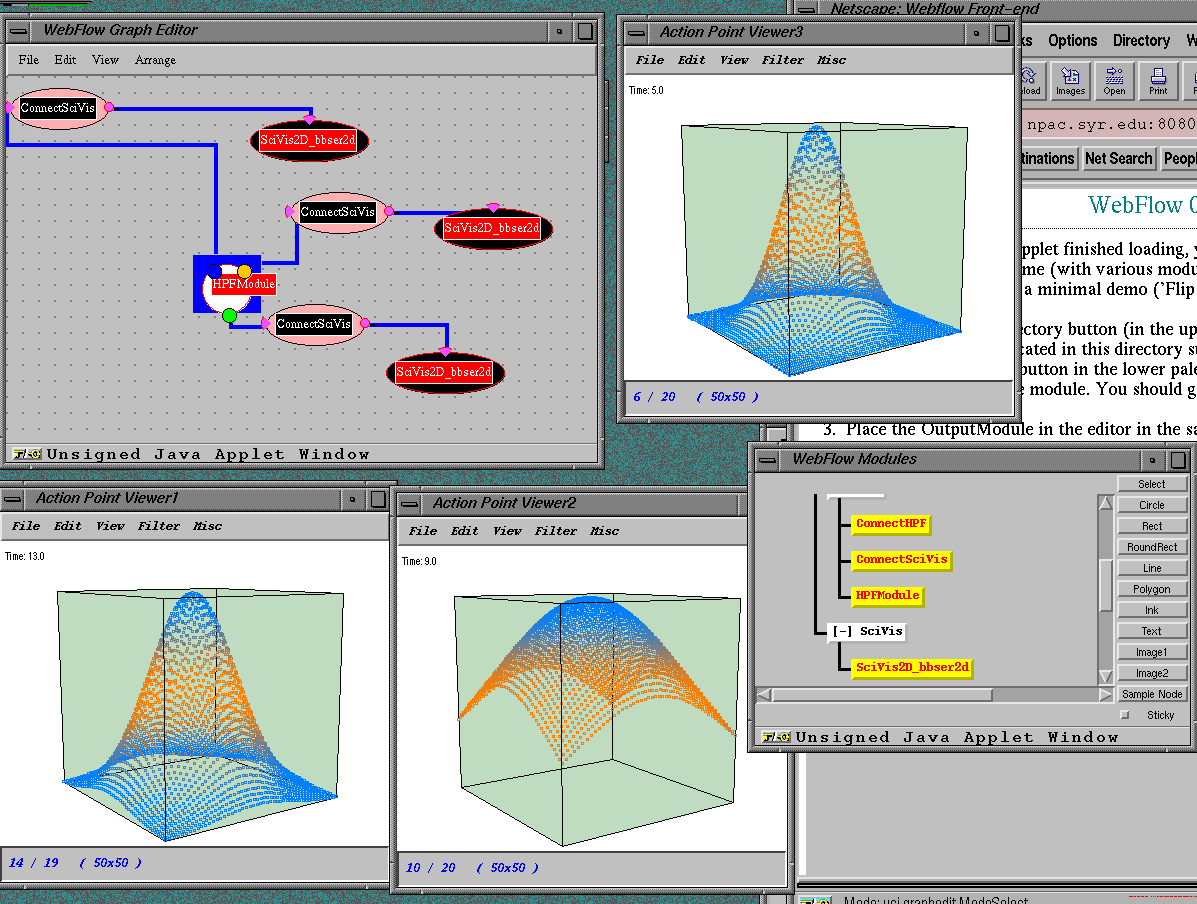
Figure 2.6:
Sample screendump from the WebFlow demo presented at Supercomputing ’97: a set of real-time visualization modules is attached to the HPC simulation module (Binary Black Holes) using WebFlow visual dataflow editor (upper left frame).
The distinctive feature of WebFlow is that it is constructed as a mesh of Web servers and hence it can be viewed as a natural computational extension of the Web information model. In the Web information model, individual developers publish information pages (located on different Web servers) and the user navigates visually such distributed information space by clicking hyperlinks. In the WebFlow computation model, individual developers publish computational modules (located on different Web servers), and the user connects them visually in terms of a computational graph to create a distributed dataflow computation.
3. Hybrid High Performance Systems
The use of high functionality but modest performance communication protocols and interfaces at the middle tier limits the performance levels that can be reached in this fashion. However this first step gives a modest performance scaling, parallel (implemented if necessary, in terms of multiple servers) HPcc system which includes all commodity services such as databases, object services, transaction processing and collaboratories.
The next step is only applied to those services with insufficient performance. Naively we "just" replace an existing back end (third tier) implementation of a commodity service by its natural HPCC high performance version. Sequential or socket based messaging distributed simulations are replaced by MPI (or equivalent) implementations on low latency high bandwidth dedicated parallel machines. These could be specialized architectures or "just" clusters of workstations.
Note that with the right high performance software and network connectivity, workstations can be used at tier three just as the popular "LAN" consolidation" use of parallel machines like the IBM SP-2, corresponds to using parallel computers in the middle tier. Further a "middle tier" compute or database server could of course deliver its services using the same or different machine from the server. These caveats illustrate that, as with many concepts, there will be times when the relatively clean architecture of Figure 2.2 will become confused. In particular the physical realization does not necessarily reflect the logical architecture shown in Figures 2.1 and 2.3.
3.1 Multidisciplinary Application
We can illustrate the commodity technology strategy with a simple multidisciplinary application involving the linkage of two modules A and B -- say CFD and structures applications respectively.
Let us assume both are individually parallel but we need to link them. One could view the linkage sequentially as in Figure 3.1, but often one needs higher performance and one would "escape" totally into a layer which linked decomposed components of A and B with high performance MPI (or PVMPI).
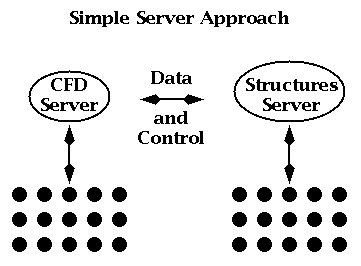
Figure 3.1: Simple sequential server approach to LinkingTwo Modules
Here we view MPI as the "machine language" of the higher-level commodity communication model given by approaches such as WebFlow from NPAC.
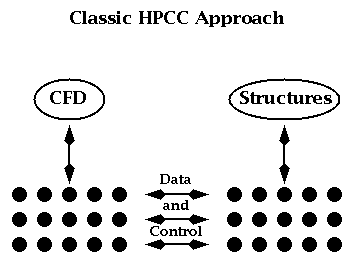
Figure 3.2: Full HPCC approach to Linking Two Modules
There is the "pure" HPCC approach of Figure 3.2, which replaces all commodity web communication with HPCC technology. However there is a middle ground between the implementations of Figures 3.1 and 3.2 where one keeps control (initialization etc.) at the server level and "only" invokes the high performance back end for the actual data transmission. This is shown in Figure 3.3 and appears to obtain the advantages of both commodity and HPCC approaches for we have the functionality of the Web and where necessary the performance of HPCC software. As we wish to preserve the commodity architecture as the baseline, this strategy implies that one can confine HPCC software development to providing high performance data transmission with all of the complex control and service provision capability inherited naturally from the Web.
Figure 3.3:
Hybrid approach to Linking Two Modules
3.2 Publish / Subscribe Model for HPcc
We note that JavaBeans (which are one natural basis of implementing program modules in the HPcc approach) provide a rich communication mechanism, which supports the separation of control (handshake) and implementation. As shown below in Figure 3.4, JavaBeans use the JDK 1.1 AWT event model with listener objects and a registration/call-back mechanism.
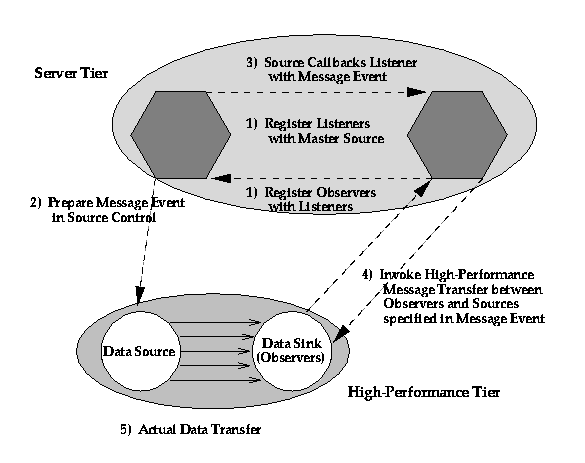
Figure 3.4:
JDK 1.1 Event Model used by (inter alia) JavaBeans
JavaBeans communicate indirectly with one or more "listener objects" acting as a bridge between the source and sink of data. In the model described above, this allows a neat implementation of separated control and explicit communication with listeners (a.k.a. sink control) and source control objects residing in middle tier. These control objects decide if high performance is necessary or possible and invoke the specialized HPCC layer. This approach can be used to advantage in "run-time compilation" and resource management with execution schedules and control logic in the middle tier and libraries such as MPI, PCRC and CHAOS implementing the determined data movement in the high performance (third) tier. Parallel I/O and "high-performance" CORBA can also use this architecture. In general, this listener model of communication provides a virtualization of communication that allows a separation of control and data transfer that is largely hidden from the user and the rest of the system. Note that current Internet security systems (such as SSL and SET) use high functionality public keys in the control level but the higher performance secret key cryptography in bulk data transfer. This is another illustration of the proposed hybrid multi-tier communication mechanism.
3.3 Example: WebFlow over Globus for Nanmomaterials Monte Carlo Simulation
We illustrate here our concepts of hybrid communication approach discussed above on example of the WebFlow system at NPAC introduced in section 2.4.3. A more detailed presentation of WebFlow can be found in Section 5.7. In a nutshell, WebFlow can be viewed as an evolving prototype and testbed of our High Performance Commodity Computing and Pragmatic Object Web concepts and it is therefore referenced from various perspectives in several places in this document. Here we summarize the architecture and we expose the middleware and/or backend communication aspects of the system.
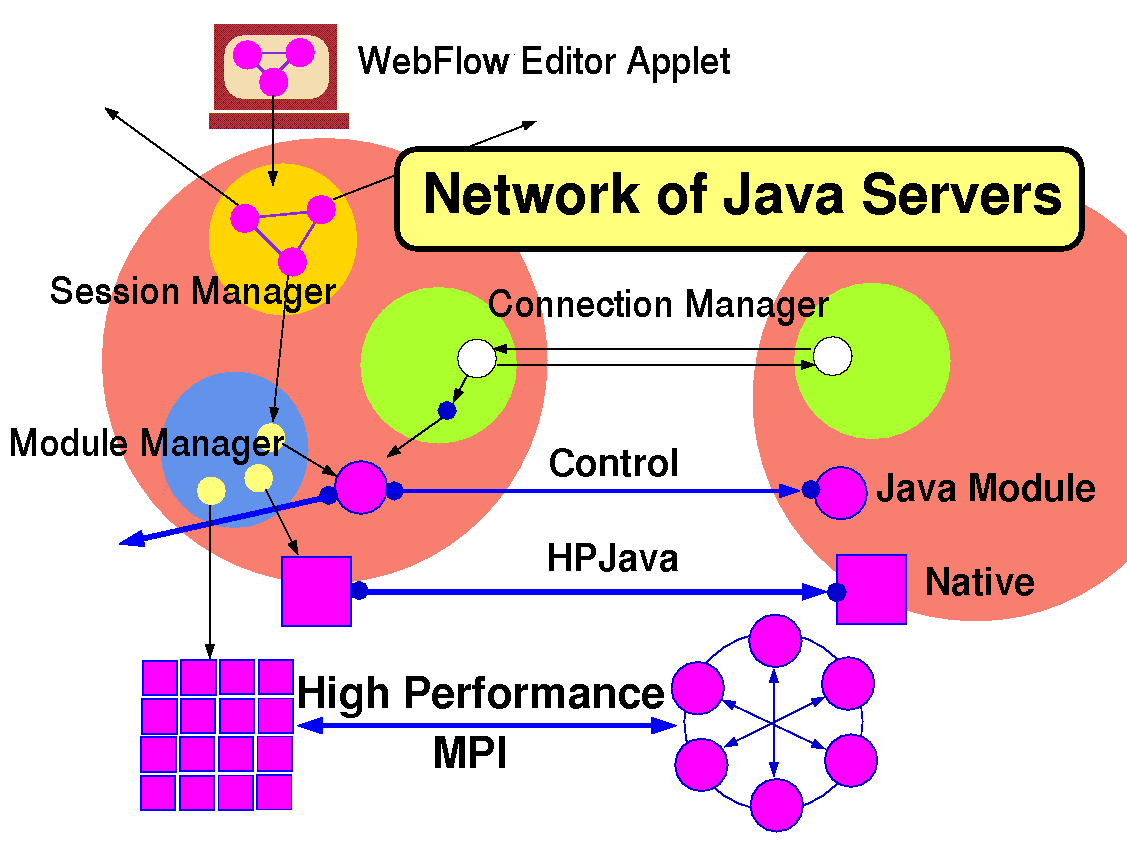
Figure 3.5:
Overall Architecture of the 3-tier WebFlow model with the visual editor applet in tier-1, a mesh of Java Web Serversin tier 2 (including WebFlow Session Manager, Module Manager and Connection Manager servlets), and (high performance) computational modules in tier-3.
WebFlow is a distributed, Web based visual dataflow authoring environment, based on a mesh of middleware Java servers that manage distributed computational graphs of interconnected back-end modules, specified interactively by users in terms of the front-end graph editing applets. Figure 3.5 illustrates two natural communication layers in WebFlow: high functionality low performance pure Java middleware control and high performance MPI based data transfer in the backend. The possible HPJava layer (discussed in Section 7.6) can be viewed as interpolating between these two modes.
In the early WebFlow prototype, demonstrated as in Figure 2.6 at SC’97, we used Java sockets to connect between module wrappers in the middleware and the actual HPC codes in the backend. The new version of WebFlow under development based on JWORB middleware servers (see Section 5) will offer more powerful CORBA wrapper techniques for binding middleware control written in Java with multi-language backend codes (typically written in C, C++ or FORTRAN). CORBA wrapping technology offered by WebFlow, enables visual Web based interfaces for the current generation pure HPCC and Metacomputing systems such as Globus or Legion. We are currently experimenting with WebFlow-over-Globus interfaces (see Figure 3.6) in the context of some selected large scale applications described below.
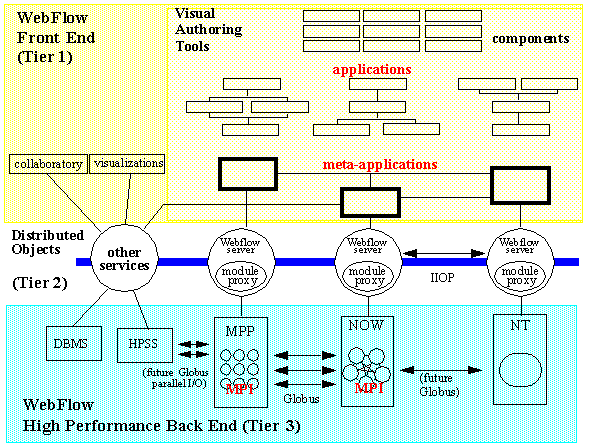
Figure 3.6:
Top level view of the WebFlow environment with JWORB middleware over Globus metacomputing or NT cluster backend
Within the NPAC participation in the NCSA Alliance, we are working with Lubos Mitas in the Condensed Matter Physics Laboratory at NCSA on adapting WebFlow for Quantum Monte Carlo simulation’s [19]. This application is illustrated in Figures 3.7 and 3.8 and it can be characterized as follows. A chain of high performance applications (both commercial packages such as GAUSSIAN or GAMESS or custom developed) is run repeatedly for different data sets. Each application can be run on several different (multiprocessor) platforms, and consequently, input and output files must be moved between machines.
Output files are visually inspected by the researcher; if necessary applications are rerun with modified input parameters. The output file of one application in the chain is the input of the next one, after a suitable format conversion.
The high performance part of the backend tier in implemented using the GLOBUS toolkit [20]. In particular, we use MDS (metacomputing directory services) to identify resources, GRAM (globus resource allocation manager) to allocate resources including mutual, SSL based authentication, and GASS (global access to secondary storage) for a high performance data transfer.
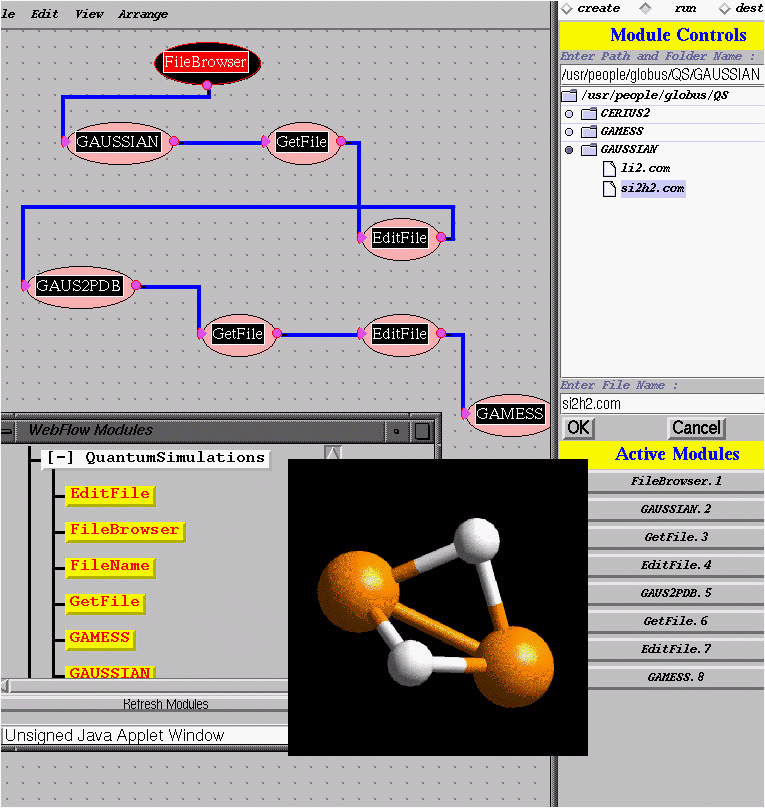
Figure 3.7:
Screendump of an example WebFlow session: running Quantum Simulations on a virtual metacomputer. Module GAUSSIANis executed on Convex Exemplar at NCSA, module GAMESS is executed on SGI Origin2000, data format conversion module is executed on Sun SuperSparc workstation at NPAC, Syracuse, and file manipulation modules (FileBrowser, EditFile, GetFile) are run on the researcher's desktop.
The high performance part of the backend is augmented with a commodity DBMS (servicing Permanent Object Manager) and LDAP-based custom directory service to maintain geographically distributed data files generated by the Quantum Simulation project. The diagram illustrating the WebFlow implementation of the Quantum Simulation is shown in Figure 3.8.

Figure 3.8:
WebFlow-over-Globus implementation of the Quantum Simulations
4. Pragmatic Object Web – Stakeholders
We discuss now in more detail the four major players in the area of Object Web computing: Java, CORBA, COM and WOM. Each of these models offers an attractive and poweful enough framework, capable of addressing most of the relevant challenges in modern distributed computing programming. In consequence, each of these models claims completeness and tries to dominate and / or monopolize the market. Most notably, Java appeared during the last few years as the leading language candidate for distributed systems engineering due to its elegant integrated support for networking, multithreading and portable graphical user interfaces.
While the "Java Platform" or "100% Pure Java" philosophy is being advocated by Sun Microsystems, industry consortium led by the OMG pursues a multi-language approach built around the CORBA model. It has been recently observed that Java and CORBA technologies form a perfect match as two complementary enabling technologies for distributed system engineering. In such a hybrid approach, referred to as Object Web [2], CORBA is offering the base language-independent model for distributed objects and Java offers a language-specific implementation engine for the CORBA brokers and servers.
Meanwhile, other total solution candidates for distributed objects/components are emerging such as DCOM by Microsoft or WOM (Web Object Model) by the World-Wide Web Consortium. However, standards in this area and interoperability patterns between various approaches are still in the early formation stage. For example, recent OMG/DARPA workshop on compositional software architectures [33] illustrated very well both the growing momentum and the multitude of options and the uncertainty of the overall direction in the field. A closer inspection of the distributed object/component standard candidates indicates that, while each of the approaches claims to offer the complete solution, each of them in fact excels only in specific selected aspects of the required master framework. Indeed, it seems that WOM is the easiest, DCOM the fastest, pure Java the most elegant and CORBA the most realistic complete solution.
In our Pragmatic Object Web [3] approach at NPAC we adopt an integrative methodology i.e. we setup a multiple-standards based framework in which the best assets of various approaches accumulate and cooperate rather than competing. We start the design from the middleware which, offers a core or a `bus' of modern 3-tier systems and we adopt Java as the most efficient implementation language for the complex control required by the multi-server middleware. We adopt CORBA as the base distributed object model at the Intranet level, and the (evolving) Web as the world-wide distributed (object) model. System scalability requires fuzzy, transparent boundaries between Intranet and Internet domain’s which therefore translates into the request of integrating the CORBA and Web technologies. We implement it by building a Java server (JWORB [13]) which handles multiple network protocols and includes support both for HTTP and IIOP. On top of such Pragmatic Object Web software bus, we implement specific computational and collaboration services.
We discuss our POW concepts and prototypes in more detail in the next section. Here, we summarize first the four major technologies that enable the POW infrastructure: Java, CORBA, COM and WOM.
Java is a new attractive programming language based on architecture-neutral byte code interpretation paradigm that took the Web / Commodity community by storm in 1995 when the language and the associated software: Java Virtual Machine and Java Development Kit were published for the Internet community. The Java programming language though closely aligned to the C++ syntax, avoids C++ language features that lead to programming errors, obfuscated code, or procedural programming. Java can be looked upon as an isotope of C++ minus the pointers and accompanying pointer arithmetic, operator overloading, struct and union. The automatic memory management, instead of requiring applications to manage its heap-allocated memory thus minimizing memory leaks and erroneous memory references, and Operating System abstractions contributes to making it an intriguingly productive environment. However Java’s platform independence and the write-once-run-anywhere promise is not without its baggage of drawbacks, thanks to its assumption of the lowest possible denominator of operating system resources.
Nevertheless, building on top of the rapid success of Java as a programming language, and exploiting the natural platform-independence of Java byte codes, Sun is developing Java as a complete computing platform itself. They do this by offering an already extensive and continuously growing suite of object libraries, packages as frameworks for broad computational domains such as Media, Security, Management, Enterprise, Database, Commerce, Componentware, Remote Objects, or Distributed Computing services.
Hence, from the Sun Microsystems perspective, Java is more than a language - its a framework that comprises many components. It includes PicoJava, a hardware implementation of the Virtual Machine; the JavaOS, an operating system implementation, and application programming interfaces to facilitate development of a broad range of applications, ranging from databases (JDBC) and distributed computing (RMI) to online commerce (JavaCard) and consumer electronics (Personal Java).
In our approach, Java plays a dual role. Like the rest of the computing community, we embrace Java as a programming language, ideal for middleware programing in our POW framework. In particular, our JWORB server that forms the core of the POW middleware is written in 100% pure Java. As such, however, it is heavily used to facilitate interfaces to codes in languages other than Java such as C/C++ back-ends, XML middleware or VBA, HTML or JavaScript front-ends.
Another role played by Java in our POW framework is as one of the four major competing Object Web technologies. Java model for distributed computing includes JavaBeans based componentware, RMI based remote objects and JINI based distributed services. In the following, we review these components of Java, promoted by Sun and opposed by Microsoft and viewed in Redmond as competing with and inferior to ActiveX, DCOM and Millenium, respectively (discussed in turn in Section 4.3).
JavaBeans formalizes the component reuse process by providing mechanisms to define components in Java and specify interactions amongst them. Java Beans components provide support wherein component assemblers discover properties about components. One of the other interesting aspects of JavaBeans is that they also accommodate other component architectures such as OpenDoc, ActiveX and LiveConnect. So by writing to JavaBeans the developer is assured that the components can be used in these and other component architectures.
GUI Beans
Since it's a "component architecture" for Java, Beans can be used in graphical programming environments, such as Borland's JBuilder, or IBM's VisualAge for Java. This means that someone can use a graphical tool to connect a lot of beans together and make an application, without actually writing any Java code -- in fact, without doing any programming at all. Graphical development environments let you configure components by specifying aspects of their visual appearance (like the color or label of a button) in addition to the interactions between components (what happens when you click on a button or select a menu item).Enterprise Beans One important aspect of Java Beans is that components don't have to be visible. This sounds like a minor distinction, but it's very important: the invisible parts of an application are the parts that do the work. So, for example, in addition to manipulating graphical widgets, like checkboxes and menus, Beans allows you to develop and manipulate components that do database access, perform computations, and so on. You can build entire applications by connecting pre-built components, without writing any code. Such middleware Beans come with their own management model, specified recently by the Enterprise JavaBeans (EJB) interfaces, now being implemented and tested by various vendors in several domains of enterprise computing.
A "Bean" is just a Java class with additional descriptive information. The descriptive information is similar to the concept of an OLE type library, though a bean is usually self-describing. Any Java class with public methods can be considered to be a Bean, but a Bean typically has properties and events as well as methods.
Because of Java's late binding features, a Java.class file contains the class's symbol information and method signatures, and can be scanned by a development tool to gather information about the bean. This is commonly referred to as "introspection" and is usually done by applying heuristics to the names of public methods in a Java class. The Beans specification refers to these heuristics of introspection as "design patterns".
Properties
The property metaphor in Java essentially standardizes what is common practice both in Java and other object-oriented languages. Properties are set of methods that follow special naming conventions. In the case of read/write properties, the convention is that if the property name is XYZ, then the class has the methods setXYZ and getXYZ respectively. The return type of the getter method must match the single argument to the setter method. Read-only or write-only properties have only one of these methods. In addition to single and multi-value properties, JavaBeans defines bound and constrained property types. Bound properties use Java events to notify other components of a property value change; constrained properties let these components veto a change. Constrained properties provide a uniform language-based approach to basic validation of business rules.For those who are queasy about the idea of enforced naming conventions, JavaBeans provides an alternate approach. Explicit information about a class can be provided using the BeanInfo class. The programmer sets individual properties, events, methods using a Bean Info class and several descriptor class types (viz. Property Descriptor, for specifying properties or the Method Descriptor for specifying methods). To some extent, naming conventions do come into play here as well, as when defining the a BeanInfo class. When an RAD Tool wants to find out about a JavaBean, it asks with the Introspector class by name, and if the matching BeanInfo is found the tool uses the names of the properties, events and methods defined inside that pre-packages class. If not the default is to use the reflection process to investigate what methods exist inside a particular JavaBean class.
A software event is a piece of data sent from an object, notifying the recipient object of a possibly interesting occurrence. This occurrence could be a mouse move used in windowing systems, or it could also be the notification for a datagram packet arriving from a network. Basically any occurrence can be modeled as an event and the relevant information regarding the event can be encapsulated within the event. To put it simply an event is self describing, viz. the mouse click event would include the time the click occurred. It might also include such information as where on the screen the mouse was clicked, the state of the SHIFT and ALT buttons, and an indication of which mouse button was clicked. The object sending the event is said to be firing the event, while the object receiving the event is said to be the recipient. Software systems are usually modeled in terms of the event-flow in the system. This allows for clear separation of the components firing events and components responsive to those events. For example, if the right-mouse button is pressed within a Frame, then a popup menu is being thrown; or if a datagram packet just arrived, some relevant is being processed. Firing and responsive handling of events are one of two ways that objects communicate with each other, besides invoking methods on each other.
Java 1.1 Event Model In Java1.0.2 and earlier versions, events were passed to all components that could possibly have an interest in them. Events traversed upward the whole component/container hierarchy until they either found an interested component, or they reached the top frame without anyone’s interest and they were then discarded. Java1.1 introduced a new event API, based on the delegation model, and now extensively used by Beans. In this model, events are distributed only to objects that have registered an interest in event reception. Event delegation improves performance and allows for clearer separation of event-handling code.
The delegation model implements the Observer-Observable design pattern with events. The flexible nature of the current event model allows classes that produce events to interact with other classes that don't. Instead of defining event-processing methods that client subclasses must override, the new model defines interfaces that any class may implement if it wants to receive a particular message type. This is better because an interface defines a "role" that any class may choose to play by implementing the set of operations that the interface defines. Instead of searching for components that are interested in an event - the handleEvent() mechanism, the new model requires objects to be registered to receive events, only then are the objects notified about the occurrence of that particular event. To receive an event, the objects are registered with event source via a call to the addListener method of the source. Event listeners provide a general way for objects to communicate without being related by inheritance. As such, they're an excellent communication mechanism for a component technology -- namely, JavaBeans which allows for interaction between Java and other platforms like OpenDoc or ActiveX.
Java Remote Method Invocation (RMI) is a set of APIs designed to support remote method invocations on objects across Java virtual machines. RMI directly integrates a distributed object model into the Java language such that it allows developers to build distributed applications in Java. More technically speaking, with RMI, a Java program can make calls on a remote object once it obtains a reference to the remote object. This can be done either by looking up the remote object in the bootstrap naming service provided by RMI or by receiving the reference as an argument or a return value.
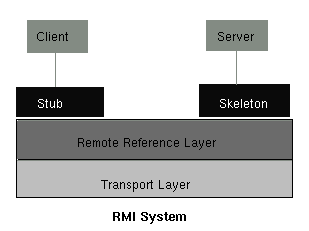
One of the key design requirements in the Distributed Object environment is to create nuggets of behavior which can be shipped from place to place. Oddly enough, classes provide a nice encapsulation boundary for defining what one of these nuggets are. Java with its mobile code facility (the ability to transfer executable binaries to wherever they need to be executed) handles inter-object communications within its native environment. The Java RMI and Java Serialization interfaces allow Java-Objects to migrate around the network, heedless of what hardware platform they land on, and then control each other remotely. Currently, Java RMI uses a combination of Java Object Serialization and the Java Remote Method Protocol (JRMP) to convert normal-looking method calls into remote method calls. Java RMI supports its own transport protocol today (JRMP) and plans to support other industry standard protocols in the near future, including IIOP. In order to support IIOP as it is today, JavaSoft will define a restricted subset of features of Java RMI that will work with IIOP. Developers writing their applications to this restricted subset will be able to use IIOP as their transport protocol.
4.1.3 JINI
Beans and RMI can be viewed as infrastructure elements, enabling various specific 100% pure Java based distributed computing environments. JINI is new Sun’s effort towards a more complete distributed system, aimed at the emerging market of networked consumer electronic devices. A Jini system is based on the idea of federating groups of users and the resources required by those users. The overall goal is to turn the network into a flexible, easily administered tool on which human or computational clients can find resources efficiently. Examples include a JINI enabled printer that installs and configures itself automatically when plugged into the office LAN; or a JINI-capable appliance that can be activated on the home JINI network in a true plug-and-play mode.
JINI Service is an entity that can be used by a person, a program, or another service. Service Protocol defines the interface of the service. Services are found and resolved by a lookup service.
Lookup service is a major component in the system, used to establish connection between users and services. Objects in lookup service may include other lookup services so that hierarchical lookup can be provided with no cost. Some services can have user interface(GUI) so that the service can be controlled by the user in real time. Objects which are related to a particular service builds the object group and they live in a single address space together. Each object group lives in different virtual machine so that a certain location and security-based requirements can be supplied. Lookup process includes the following steps described below.
Lookup occurs when a client or user needs to locate and invoke service described by its type ( its java interface) and possibly, other attributes. If user can not find a lookup service, then it can send out the same identification message, which the lookup service uses, to request service providers to register. Then, user can pick the service from the incoming registration requests. User downloads the proxy object for the service from lookup service and uses this object to access to the required service.
User interacts with the service through this proxy object which provides a well-defined interface for this service. A proxy object may use its proprietary communication protocol with the actual server. If a service has an user interface, then user gets a proxy object in Applet type and this object can be displayed by browsers or other user-interface tools.
When services join or leave a lookup service, events are signaled, and objects that have registered interest in such events get notifications.
Discovery process indicates that the service is discovered by Jini system. In other words, service is registered to the lookup service. Discovery occurs when a new service joins (a device is plugged in) to the Jini system and it includes the steps listed below.
The service provider locates a lookup service by broadcasting a presence announcement.
A proxy containing the interface and other descriptive attributes for the service is loaded into the lookup service.
RMI provides the communication protocol between services.
Security is defined with two concepts: principal and access control list (ACL). Services in the system are accessed on behalf of some entity (principal) which generally leads to a particular user in the system. ACL controls the access rights for the particular object (service).
Lease denotes that user has an access permission to the service over a time period. Lease expires at the end of the given time and user of the service loses its privilege to use the service unless user gets another lease before the expiration of the pervious one. Lease concept brings the time factor as a new ingradient to the validity of the object reference.
Leases can be exclusive or non-exlusive. Meaning that user can be the only user of a service or it can share the service with others.
Transaction interface provides a service protocol needed to coordinate a two-phase commit. The correct implementation of the desired transaction semantics is up to the implementers of the particular objects that are involved in the transaction.
Distributed Events This technology allows an object in one Java virtual machine to register interest in the occurence of some event occurring in an object in some other Java virtual machine.
Distributed Event API allows to introduce third party objects between event generators and consumers so that it is possible to off-load the objects from excessive notifications, to implement various delivery guarantees, storing of notifications until needed or desired by a recipient, and the filtering and rerouting of notifications.
Remote Event has the following fields: a) event kind; b) a reference to the object in which this event is occurred; c) a sequence number of the event; d) an object supplied by the remote event listener at the registration phase.
An object, which wants to receive a notification of an event from some other object, should support RemoteEventListener interface. An object registers itself to the generator object, which supports EventGenerator interface. In the registration, listener provides the event kind, a reference to listener object, how long it wants to stay in the listener mode(lease concept), and a marshalled object which will be handed back to the listener at notification. Registration method (register()) returns an EventRegistration object which contains the kind of event an object is registered for listening, the current sequence number of those events and a Lease object.
An object, which wants to receive a notification of an event from some other object, should support RemoteEventListener interface and registers itself to the generator.
Whenever an event arrives, notify() method of the object will be invoked. This method is invoked with an instance of RemoteEvent object. The RemoteEvent object contains a reference to the object in which this event is occurred, the kind of event, a sequence number of the event(event id), and a marshalled object provided during registration process.
|
FEATURE |
JavaOM (RMI+JINI) |
DCOM |
CORBA |
|
Multiple Inheritance |
Java objects can implement multiple interfaces.
|
An object can support multiple interfaces. |
IDL definition allows to define an interface which can inherit from multiple interfaces. |
|
Registering Object |
Lookup Service
|
Registry. |
Implementation Repository. |
|
Wire Protocol |
Java Remote Method Protocol (JRMP).
|
Object Remote Procedure Call(ORPC) – Microsoft extension of DCE RPC |
General Inter-ORB Protocol(GIOP) |
|
Data Marshaling/Unmarshaling Format |
Object Serialization
|
Network Data Representation(NDR) |
Common Data Representation(CDR) |
|
Dynamic Invocation |
Java's reflection support allows user to obtain the necessary operation information about an object.
|
Type Library and IDispatch interface or |
Interface Repository. |
|
Exceptions |
Java provides necessary exceptions as an object. User can define additional exceptions.
|
A 32-bit error code called an HRESULT should be returned from each method. |
Predefined exceptions and allows user to define his/her own exceptions in IDL. |
Figure 4.2:
Comparison of some major design, implementational and programmatic features in the distributed object / component models of JINI, COM and CORBA.
JavaSpaces
technology acts as a lightweight infrastructure de-coupling the providers and the requestors of network services, by delivering a unified environment for sharing, communicating, and coordinating. Developed before JINI and initially driven by the Linda concepts, JavaSpaces are now being repackaged as an example of JINI Networking Service.
Using Javaspaces, one can write systems that use flow of data to implement distributed alogorithms while implementing distributed persistence implicitly. This is different from the approach towards Distributed computing which involves creation of remote method invocation-style protocol. The JavaSpaces' "flow of objects" paradigm is based on the movements of objects into and out of JavaSpaces implementations. JavaSpaces uses the following programming language API's to achieve this end - Java RMI, Object Serialization, Distributed events and Transactions.
A Space holds entries, which are a typed group of objects, expressed by a class that implements the interface space.entry. There are four primary kinds of operations that you can invoke on a space. Each operation has parameters that are entries and templates, a special kind of entry that have some or all of its fields set to specified values that must be matched exactly. The operations are: a) write a given entry into the space; b) read an entry that matches the given template from the space; c) take an entry that matches the given template from this space, thereby removing it from the space; and d) notify a specified object when entries that match the given template are written into the space.
All operations that modify the JavaSpaces server are performed in a transactionally secure manner with
respect to that space. The JavaSpaces architecture supports a simple transaction mechanism that allows multi-operation and/or multi-space updates to
complete atomically using the two-phase commit model under default transaction semantics.
All operations are invoked on a local smart proxy for the space. The actual implementation could reside on either the same machine or a remote machine. The server for the application that uses JavaSpaces technology will be completely implemented once the entries are designed. This obviates the need to for implementing a remote object for a specified remote interface or using rmic to generate client stubs and implementation skeletons.
In contrast, a customized system needs to implement the server. The designer of this server need to deal with concurrency issues and atomicity of operations. Also, someone must design and implement a reliable storage strategy that guarantees the entries written to the server are not lost in an unrecoverable or undetectable way. If multiple bids need to be made atomically, a distributed transaction system has to be implemented. JavaSpaces technology solves these problems, the developer does not have to worry about them. The spaces handle concurrent access. They store and retrieve entries atomically and provide implementation of the distributed transaction mechanism.
CORBA (Common Object Request Broker Architecture) defines a set of specifications formalizing the ways software objects cooperate in a distributed environment across boundaries such as networks, programming languages, and operating systems. Supported by the Object Management Group (OMG), the largest software industry consortium of some 700+ companies, CORBA is the most ambitious ongoing effort in the area of distributed object computing. CORBA supports the design and bottom-up development of new enterprise systems and could also be utilized for the integration of legacy systems and sub-systems.
An implementation of the CORBA standard defines a language and platform-independent object bus called an ORB (Object Request Broker), which can translate between different data formats (big-endian or little-endian) besides other attributes. The ORB, thus lets objects transparently inter-operate, and discover each other, across address spaces, networks, operating systems and languages. Distributed objects cooperate by sending messages over a communication networks. Each implementation of the CORBA standard, the object bus, is able to communicate with any other implementation of the standard., the protocol used to achieve this end is the Internet Inter-ORB Protocol (IIOP).
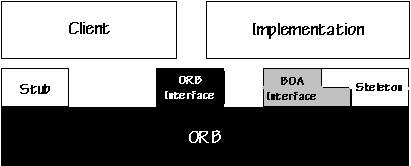
Figure 4.2:
The Object Request Broker
A client application needn't know the location details of the object it needs to use. The only information that is required on the client side is the object's name and details on how to use the remote objects interface. Details pertaining to object location, request routing, invocation and returning of the result are transparently handled by the ORB. Using IIOP its possible to use the Internet itself as a backbone ORB through which other ORB's can merge. CORBA is widely implemented in many languages (though they vary in degree of CORBA-compliance, portability and avaiability of additional features), besides supporting the mixing of languages within a single distributed application.
4.2.2 IIOP - Internet Inter-ORB Protocol
The General Inter-ORB Protocol (GIOP) defines a set of message formats and data formatting rules, for communication between ORB's. GIOP's primary goal is to facilitate ORB-to-ORB communications, besides operating directly over any connection oriented protocol. The Common Data Representation (CDR), which is tailored to the data types supported in the CORBA Interface Definition Language (IDL), handles inter-platform issues such as byte ordering. Using the CDR data formatting rules, the GIOP specification also defines a set of message formats that support all of the ORB request/reply semantics defined in the CORBA core specification. GIOP also defines a format for Interoperable Object References (IOR). ORB’s create IOR’s whenever an object reference needs to be passed across ORBs. IORs associate a collection of tagged profiles with object references, which provide information on contacting the object using the particular ORB's mechanism.
GIOP messages can be sent over virtually any data transport protocol, such as TCP/IP, Novell SPX, SNA protocols, etc. To ensure "out-of-the-box" interoperability between ORB products, the IIOP specification requires that ORBs send GIOP messages over TCP/IP connections. TCP/IP is the standard connection-oriented transport protocol for the Internet. To be CORBA 2.0 compatible, an ORB must support GIOP over TCP/IP, hence IIOP now has become synonymous with CORBA. Using IIOP any CORBA client can speak to any other CORBA Object. The architecture states that CORBA objects are location transparent. The implementation, therefore, may be in the same process as the client, in a different process or on a totally different machine. Also it should be noted that has built in mechanisms for implicitly transmitting context data associated with transactions and security services.
4.2.3 The Object Management Architecture Model
The Object Management Architecture (OMA) is composed of an Object Model and a Reference Model. Object Model defines how objects are distributed across a heterogeneous environment. The Reference Model defines interactions between those objects. The OMA essentially, is the high level design of a distributed system provided by the OMG.
OMA Object Model. The OMG Object Model defines common object semantics for specifying the externally visible characteristics of objects in a standard and implementation-independent way. In this model clients request services from objects (which will also be called servers) through a well-defined interface. This interface is specified in OMG IDL (Interface Definition Language). A client accesses an object by issuing a request to the object. The request is an event, and it carries information including an operation, the object reference of the service provider, and actual parameters (if any).
OMA Reference Model The OMA Reference Model consists of the following components: a) Object Request Broker; b) Object Services; c) Common Facilities; d) Domain Interfaces; e) Application Interfaces. We discuss these components in more detail in the following Sections.
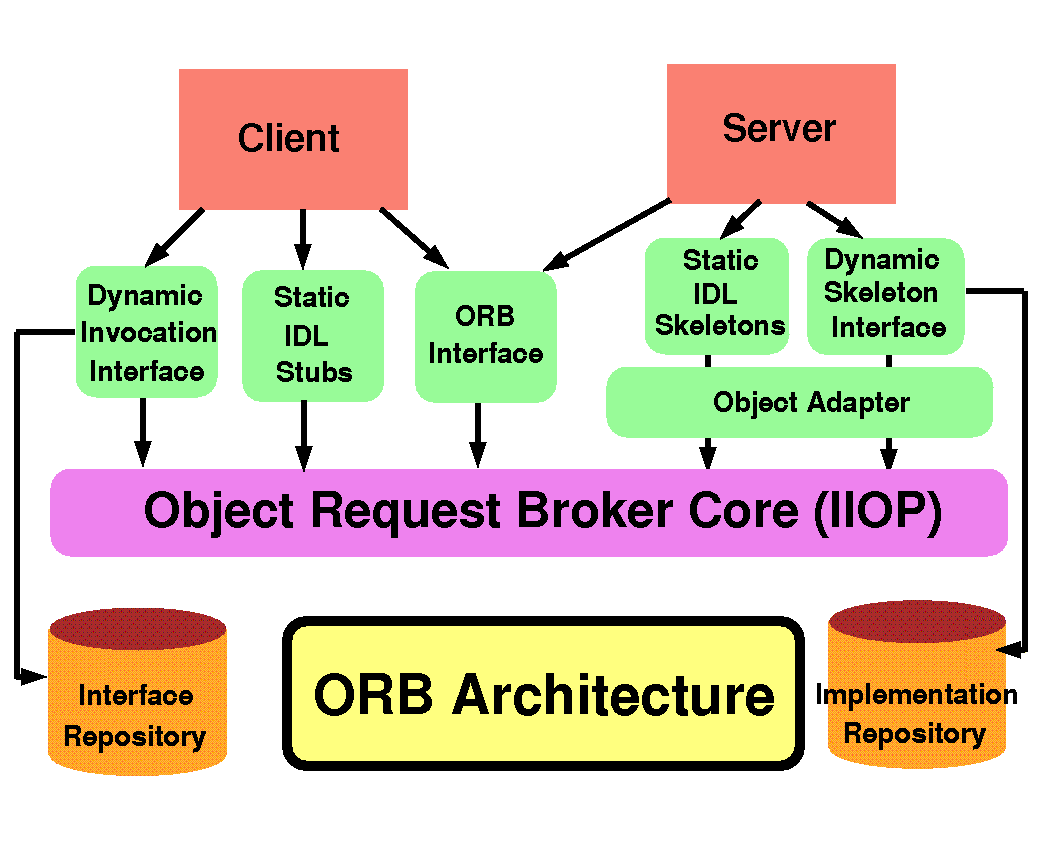
Figure 4.3:
CORBA Architecture, including client and server communication terminals, IIOP transport and persitent repository components, all participating in the remote method invocation process.
Object Request Broker : CORBA (Common Object Request Broker Architecture) specification defines Interface Description Language (IDL) language and platform-independent object bus called ORB (Object request Broker), which lets objects transparently make requests to, and receive responses from, other objects located locally or remotely. It takes care of locating and activating servers, marshaling requests and responses, handling concurrency, and handling exception conditions. Hence, ORB technology offers a useful approach for deploying open, distributed, heterogeneous computing solutions. IIOP (Internet Inter ORB Protocol) is an ORB transport protocol, defined as part of the CORBA 2.0 specification, which enables network objects from multiple CORBA-compliant ORBs to inter-operate transparently over TCP/IP.
Object Services : Collection of services, that support basic functions for using and implementing objects. These services standardize the life-cycle management of objects by providing interfaces to create objects, to control access to objects, to keep track of relocated objects, and to control the relationship between styles of objects (class management).These services are independent of application domains and do not enforce implementation details on the application. Current services are listed below.
Concurrency Control Service protects the integrity of an object's data when multiple requests to the object are processed concurrently.
Event Notification Service notifies interested parties when program-defined events occur.
Externalization Service supports the conversion of object state to a form that can be transmitted between systems.
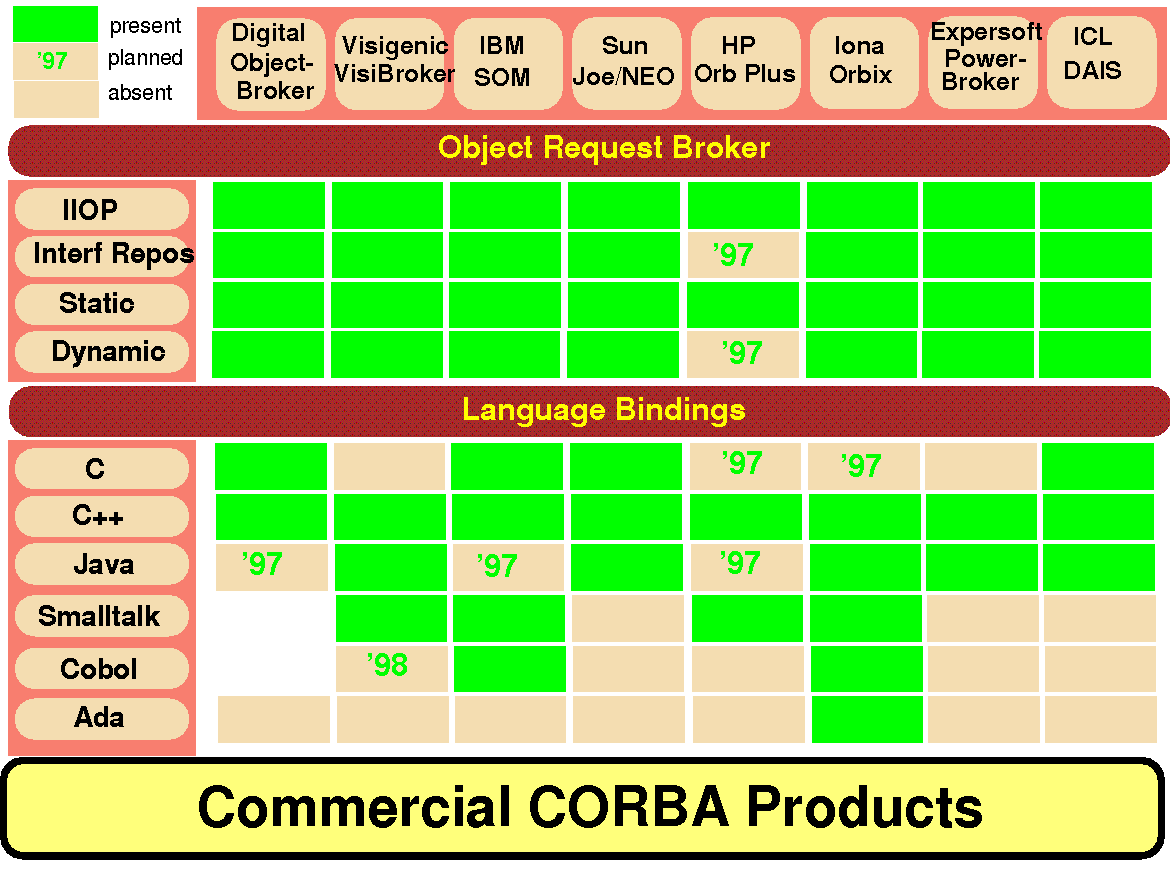
Figure 4.4:
Status of multi-language support in CORBA by major ORB vendors.
Licensing Service control and manage remuneration of suppliers for services rendered.
Naming Service provides name binding.
Object Lifecycle Service supports creation, copying, moving, and destruction of objects.
Persistent Object Service supports the persistence of an object's state when the object is not active in memory and between application executions.
Property Service support the association of arbitrary named values (the dynamic equivalent of attributes) with an object.
Query Service supports operations on sets and collections of objects that have a predicate-based, declarative specification and may result in sets or collections of objects.
Relationship Service supports creation, deletion, navigation, and management of relationships between objects.
Security Service supports integrity, authentication, authorization and privacy to degrees, and using mechanisms, that are yet to be determined.
Time Service provides synchronized clocks to all objects, regardless of their locations.
Transaction Service ensures that a computation consisting of one or more operations on one or more objects satisfies the requirements of atomicity, isolation and durability.
Trader Service provides a matchmaking service between clients seeking services and objects offering services.
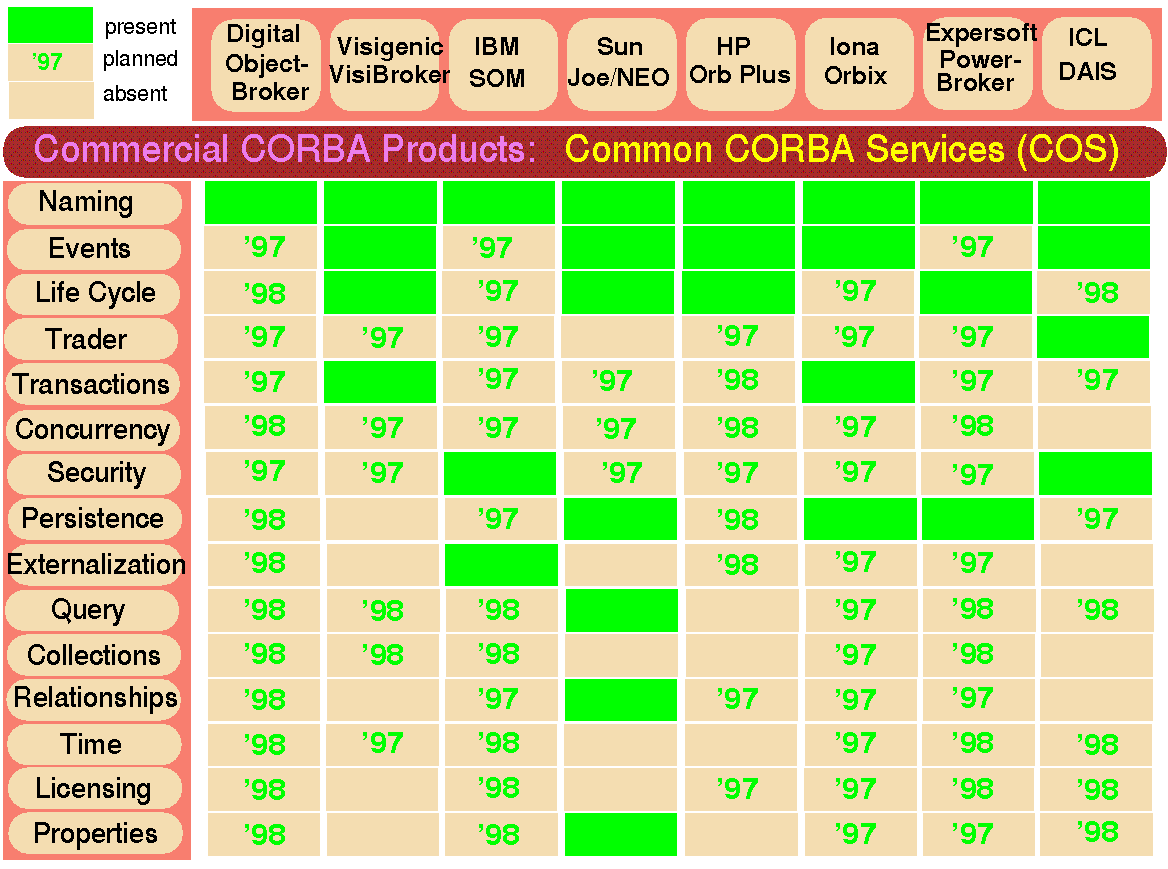
Figure 4.5:
Status of Common Services support in CORBA by major vendors.
Common Facilities commercially known as CORBAfacilities provide a set of generic application functions that can be configured to the specific requirements of a particular configuration. These services however, aren't as fundamental as object Services. Examples include WorkFlow, Mobile Agents or Business Objects.
Domain Interfaces represent vertical areas that provide functionality of direct interest to end-users in particular application domains. These could combine some common facilities and object services. Examples of active vertical domains in the OMG include: Manufacturing, Telemedicine, Telecommunication, Enterprise Computing, Modeling and Simulation etc.
Application Interfaces are CORBA interfaces developed specifically for a given application. Because they are application-specific, and because the OMG does not develop applications, these interfaces are not standardized.
These components cater to the three main segments of the software industry viz. Application Oriented, System Oriented and Vertical Market Oriented. For handling the Application-Oriented systems, the OMA characterizes Interfaces and Common Facilities as solution-specific components that rest closest to the user. The ORB's and object Services help in defining System and Infrastructure aspects of distributed object computing and management. The Vertical Market segment is handled by Domain Interfaces, which are vertical applications or domain-specific interfaces.
4.2.4 Interface Definition Language
IDL is a specialized language for defining interfaces, and this is what facilitates the notion of interacting objects, so central to CORBA. The IDL is the means by which objects tell their potential clients what operations are available and how they should be invoked. The IDL definition defines types of objects, their attributes, the methods they export and the method parameters. From the IDL definitions, it is possible to map CORBA objects into particular programming languages or object systems.
A particular mapping of OMG IDL to a programming language should be the same for all ORB implementations. Language mapping includes definition of the language-specific data types and procedure interfaces to access objects through the ORB. It includes the structure of the client stub interface (not required for object-oriented languages), the dynamic invocation interface, the implementation skeleton, the object adapters, and the direct ORB interface. A language mapping also defines the interaction between object invocations and the threads of control in the client or implementation
As a large open consortium, OMG proceeds slower, with the development and adoption of new standards, than the less constrained single vendor approaches of Java or COM. However the rapid onset of Web technologies has coincided with the invigoration and acceleration of OMG activities and we are witnessing a broad spectrum of new standard efforts. Some of these projects, to be released as part of the coming CORBA 3.0 specification are currently at various stages of RFP, proposals review, voting or standard adoptions, include
Multiple Services and Versioning: The former allows an object to support different interfaces, while the latter allows a composite object to support different versions of the same interface. This gives rise to a composite structure that is in a position to host interfaces which are not only in distinct in nature, but also have the capabilities of multiple versions instantiated by the client.
Sessions: Provide means for an object to maintain per-client context akin to a database/network server managing sessions of connection from the client. This it achieves by having multiple instances of a service within an object implementation.
COM support: Provide better support for the COM object model. COM allows a client application to query for one interface at a time. For CORBA to inter operate with the navigation code, of a client application, written for a specific COM infrastructure, the same code should be respected.
Messaging Service: OMG proposes messaging to be a service in its own right. The proposal requires the presence of interfaces that would,
a) Allow clients to make requests on an object without blocking the client execution thread b) Enable a client to make requests that may not complete during the lifetime of the client execution environment c) Allow object servers to control the order of processing incoming requests.
Object Pass-by-value : As of now CORBA supports passing of objects by reference only, thus if the receiver intends to access data or operations within the object it does so using the reference passed to it. Needless to say this adds to the wire traffic. The objects pass by value RFP addresses this issue. However there are some issues that need to be dealt with in the pass-by-value situation. For e.g. if an object is associated with different kinds of resources, and the same resources aren’t available at the receiver’s end then the consequent incompatibilities must be handled separately.
Component Model: Requirements specified by the OMG in the RFP for the CORBA component model are a) Definition of the concept of component type, and the structure of the component typing system b) Lifecycle of components and interfaces, and mechanisms for managing components c)Relationship between the component event mechanism and the existing event service d) specify a mapping of the proposed component model to the Java Beans component model.
Portable Object Adapter (POA): Takes into consideration all the design constraint the Basic Object Adapter (BOA) had, and makes it solvable. POA is far more scalable and portable than its predecessor. Features include a) Support for objects with persistent identities b) Support for the transparent object activation model. c) POA supports two types of threading model ORB controlled and single threaded behavior.
CORBA Scripting: The RFP requirements include specifying a scripting language that fits naturally into the CORBA object and (proposed) component models. Responses must also specify a)how scripts can invoke operations on CORBA objects b)relationship between the CORBA component model’s event mechanism and scripting languages c)how the scripting language exposes and manages the proposed component model properties.
COM (Component Object Model) allows an object to expose its functionality to other components and applications through its interface. It defines both how the object exposes itself and how this exposure work across processes and across networks. Interface based approach allows to ensure dynamic interoperability of binary objects written in different programming languages. Object lifecycle support in COM loads the server objects on demand if they are not loaded already and releases them whenever it finds out there is no user for this object.
COM supports Interface based programming framework where object exposes its functionality through interface. An object can support multiple interfaces. An interface is a pointer to a block of memory in which the first word is a pointer to a table of function addresses (virtual function table or v-table) as in C++ virtual function table. A client uses the interface only through its v-table since the object may actually be nothing more than a proxy which forwards the method calls to actual object.
All COM components provide IUnknown base interface which has the following methods in the first three entries of the v-table.: a) QueryInterface returns pointer of given interface (via IID or Interface Identifier) if the object supports this interface; b) AddRef increments the object's reference count; and c) Release decrements the object's reference count, freeing the object if the count becomes zero.
AddRef and Release methods are directly related to object lifecycle support of COM. Whenever client gets the interface pointer of the server object, the client counter for object is incremented so that system can track down the number of concurrent users of this particular object. Clients invoke Release method on interface pointers when they do not need it anymore. It has the same functionality as in destructor method of an object in C++. Invoking Release method on the interface decrements the client counter for this object in the COM internals and COM removes this object from runtime as soon this count drops zero (no client). When object supports multiple interfaces, client needs to get the interface pointer which, is requred. QueryInterface method provides the neccessary navigational functionality to obtain the required interface.
Any given function is identified with three elements:
a) The object's class identification number (CLSID); b) The interface type (Interface Identification Number-IID) through which the client will call member functions; and c) The offset of the particular member function in the interface.
CLSID and IID are unique 16-byte values and are generated by Globally Unique Identifier generators (such as GUIDGEN). These generators use the current time and the IP address of the machine to generate the number. This technique is defined in OSF's specifications as Universally Unique Identifier (UUID).
An instance of an COM object is created with CoCreateInstance method by providing CLSID. COM keeps a registry for each CLSID and returns the necessary object's pointer. It starts the object if the object (library-EXE or DLL) is not loaded already. If the server object implemented in DLL format, then this object will be defined in the client processe's memory (LoadLibrary). If the server object implemented in EXE format, then this object will run in different process (CreateProcess).
If the server object is in another machine (its registery entry in the COM registry tells this), then COM starts a proxy server and this talks to Service Control Manager(SCM) of the other machine and starts the necessary object on the remote machine and returns the pointer of the object on the remote machine. Client's process receives the pointer of the proxy object running on the local machine.
COM supports Location Transparency so that an object can be in the client's address space, or in another container. The later case, proxy/stub pair will do the marshaling/unmarshaling so that the same server object can be shared by multiple clients. COM places its own remote procedure call(RPC) infrastructure code into the vtable and then packages each method call into a standard buffer representation, which it sends to the component's side, unpacks it, and reissues the original method call on a server object.
Versioning in COM is provided by defining additional interfaces for the new server object. Clients has to take care of controlling (QueryInterface()) whether server supports particular interfaces or not. Objects can support multiple interfaces.
Microsoft recomments developers to use aggregation for components which are quite substiantial and composed of a lot of interfaces. An object can contain another object responsible for the specific interface and when this interface is asked it will return the pointer of this object so that client continues to think that it is dealing with the old object. This has several advantages. For example, if the server object has a lot of services, it can be divided into sub-interfaces and each interface can be handled by different object. Wrapper object contains all of them, and when COM starts the object, only the wrapper starts and it takes less time and less memory. Whenever one interface is asked, the related object is being brought to memory not all of them. It is also possible to put different sub-components to different machines.
COM supports persistent object stores for the components which provides IPersistStorage interface which allows to store the object.
DCOM (Distributed Component Model) is a protocol that enables software components to communicate directly over a network in a reliable, secure, and efficient manner. Microsoft's Distributed Component Object Model is currently avaialble for two operating systems: Window95 and Windows NT4.0. DCOM ports to the UNIX environment are under way by the third party vendors. DCOM is language-independent, and its objects are described via interfaces using Microsoft's Object Description Language(ODL). DCOM retains full COM functionality and adds core distributed computing services summarized below.
Distributed Object Reference Counting (Pinging Protocool) is implemented by client machines sending periodic messages to their servers. DCOM considers a connection as broken if more then three ping periods pass without the component receiving a ping message. If the connection is broken, DCOM decrements the reference count and it releases the component if the count becomes zero.
Transport Protocol DCOM's preferred transport protocol is the connectionless UDP. DCOM takes advantage of connectionless protocol and merges many low level acknowledgement messages with actual data and pinging messages. Proxies that handle client requests can cache and then bundle several calls to the server, thereby optimizing the network traffic. The actual protocol used by DCOM is Microsoft's RPC (Remote Procedure Call) protocol, based on extended DCE RPC developed by the Open Software Foundation.
Distributed Security Services Each component can have an ACL (Access Control List). When a client calls a method or creates an instance of a component, DCOM obtains the client's current username associated with the current process. Windows NT authenticates this information. On the server object, DCOM validates this information by looking at component's ACL. Application developers can use the same security services to define finer security restrictions on the object such as interface based or method based security.
COM+ COM+ will provide a framework that will allow developers to build transaction-based distributed applications from COM components, managed from a single point of administration. COM+ will include: a) MTS transactions; b) Security administration and infrastructure services; c) Queued Request so that invocations on COM components can be done through Microsoft's message-queuing server (MSMQ); d) Publish-and-subscribe Event service; d) Load balancing service to allow transaction requests to be dynamically spread across multiple servers.
Unlike COM requires a low level programming style, COM+ offers higher level, more user-friendly API in which COM+ classes are handled in a similar way as the regular (local) C++ classes and the whole formalism shares several design features with the Java language model. A coclass keyword indicates that a particular C++ class should be exposed as a COM+ class. This informs C++ compiler to produce metadata about class. Aon the other hand, all (Microsoft) Java classes become automatically COM+ classes. The coclass specification defines the public view of an object and its private implementation.
Unlike COM, COM+ defines a data type set so that various languages can exchange data through method calls. Coclass variables include: a) Fields i.e. linternal variables that follow the low level memory layout and are accessed from within the class; b) Properties which are implemented as accessor functions which can be intercepted by the COM+ system services or user provided callbacks.
Method overloading follows the same rules as in Java i.e. it is allowed as long as signatures of various calls of the same method are different. COM+ allows also to define exceptions that might be generated by a method. Necessary conversions are taken care of by the COM+ execution environment whenever language boundaries are crossed.
COM+ instance creation and destruction is also similar as in C++, i.e. COM+ can recognize constructor and destructor special methods. It calls constructor whenever it creates a new instance of the object class and it calls destructor before it destroys the object instance.
COM+ interfaces are specified by the cointerface keyword. It is a recommended practice to use interface to define the public behavior and state of coclasses. Method and property definitions can be done in cointerface except that everything must be public and abstract. cointerface supports multiple inheritance.
COM+ supports several types of event mechanisms:
COM+ supports both interface inheritance and implementation inheritance. In a similar way as in Java, coclass indicates with implements keyword that it will implement the particular cointerface. coclass can inherit both interface and implementation from another coclass. COM+ does not permit multiple inheritance of coclasses.
Interception is a new key concept in COM+. Whenever a method or property call is being executed, compiler/interpreter transfer control to the COM+ object runtime service instead of performing direct method call on an object. The type of interception related to services can be defined with attribute of coclass, cointerface and their methods therefore
Closely related COM+ classes can be packaged in two ways: a) logical – using namespace as a collector of classes and possibly other namespaces, with each class belonging to only one namespace; b) physical or module based with COM+ module such DLL or EXE acting as a single deployable unit of code.
Millenium COM+ is yet to be released and we are already getting first insights in the next step after-COM+ technologies and systems being constructed by Microsoft under the collective name Millenium. Millenium is is an ambitious effort by Microsoft Research towards a new high level user-friendly distributed operating system. So far, only the general set of requirements or goals and the associated broad design principles were published but one can naturally expect Millenium systems to layer on top of COM+ infrastructure in a similar way as JINI is building its services on top of Java. Further, given obvious affinity between COM+ and Java and the generally similar goals of the currently competing global software systems, we could expect Millenium and JINI to share in fact many common design features.
Some general features and goals of Millenium include: a) seamless distribution; b) worldwide scalability; c) fault-tolerance; d) self-tuning; e) self-configuration; f) multi-level security; g) flexible resource controls. Main design principles, identified to accomplish these goals, include: a) aggressive abstraction; b) storage-irrelevance; c) location-irrelevance; d) just-in-time-binding; e) introspection.
Networking vision of Millenium and JINI is similar. Any new computing or consumer electronic device, when plugged into Millenium network, publishes its characteristics, looks up and retrieves the information about the available capabilities, and it configures itself automatically and optimally in a given environment. Hardware failures are detected and corrected automatically via build-in heartbeat and code mobility services. Transient network congestion problems e.g. in case of Internet traffic peaks are resolved in the global Millenium mode by predictive replication of the to-be-hot servers, followed by the cache cleanup and service shrinkage after the hit wave is over.
Some Millenium prototype subsystems under development include: a) Borg – a distributed Java VM with single system image across many computers; b) Coign – an Authomatically Distributed Partitioning System (ADPS) for COM+ based applications; and c) Continuum which offers Single System Image (SSI) support for multi-language distributed Windows applications.
The evolution of distributed object technologies was dramatically accelerated in mid ‘90s by the Web phenomenon. Proprietary technologies such as OAK->Java or OLE->COM got published, and open standard activities such as CORBA got significantly accelerated after the rapid world-wide adoption of the Web paradigm. In turn, the World-Wide Consortium is bringing now the next suite of standards based on XML technology such as RDF, DOM or XSL which, when taken collectively, can be viewed as yet another, new dynamic framework for what is sometimes referred to as the Web Object Model (WOM). The current XML technology landscape is rapidly evolving, multi-faceted and complex to monitor and evaluate. At the time of this writing (Aug/Sept 98), the core WOM technologies such as XML, DOM, RDF or XSL are at the level of 1.0 releases. The WOM –like approaches are still in the formation stage and represented by models such as WIDL, XML RPC, WebBroker and Microsoft SOAP. In the following, we summarize briefly the stabilizing core technologies and review the emergent WOM candidates.
XML is a subset of SGML, which retains most of the SGML functionality, while removing some of the SGML complexity and adapting the model for the Web needs. Hence XML offers an ASCII framework for building structured documents based on custom markup defined by users in terms of dedicated tags. A set of tags forming a particular document type is naturally grouped in the DTD (Document Type Definition) files. RDF (Resource Definition Framework) is an XML based formalism for specifying metadata information about the Web resources. Several early XML applications, i.e. little languages for specialized domains based on XML meta-syntax were recently constructed, for example CML (Chemical Markup Language), MathML for mathematical notation, CDF (Channel Definition Format) to support push technology for Web pages, SMIL (Simple Multimedia Integration Language) or OSD (Open Software Description).
The power of the XML approach stems from the growing family of freely available tools. For example, each of the XML-compliant languages listed above and all other that are under construction can be parsed by a general purpose parser and there is already some 20+ free XML parsers available on the Web. These parsers generate intermediate representations in one of the several standard formats at various levels of abstraction, ranging from low level ESIS (Element Structure Information Set) which emits events corresponding to the XML tokens detected by the scanner, to callback based SAX (Simple API for XML) model, to object-oriented DOM (Document Object Model) to rule based XSL (XML Style Languague).
Current main focus of the XML standard development effort is on more ogranized and formalized middleware support for handling complex documents, their databases, metadata, transformations, agent based autonomous filters etc. In parallel with these activites, several early attempts towards WOM are already emerging such as WebBroker or RIO server by DataChannel, XML RPC and B2B (Business-to-Business) Integration Server by WebMethods, or SOAP (Simple Object Access Protocol) by Microsoft. In the following, we review some of these models.
Microsoft SOAP stands for Simple Object Access Protocol and it enables Remote Procedure Calls (RPC) to be sent as XML wrapped scripts across the Web using HTTP protocol. As of summer/fall ’98, SOAP is still a work in progress, pursued by Microsoft, UserLand Software and DevelopMentor. At present, SOAP enables distributed Web based interoperability between COM and DCOM applications across Win9X and WinNT platforms. Microsoft encourages also other platform (Java, CORBA) developers to use SOAP as the common denominator fully interoperable protocol for Web computing.
SOAP details are still unknown but the protocol is developed jointly with UserLand Software who previously released similar specification for RPC XML. It is therefore plausible that SOAP will share some features with this model which we describe in the following topic. Dave Wiener of UserLand Software developed Frontier – a scripting language for PC and Macintosh which is now often compared with Perl – the leading Web scripting technology under UNIX. Meanwhile, Larry Wall, the creator of Perl announced recently that he is working hard to make Perl the language of choice for XML scripting. Apparently, Perl and Frontier address the two extreme domains of Web hackers and end-users, and hence both technologies will likely coexist within the emergent WOM models for remote scripting.
XML RPC by UserLand Software, Inc. defines a simple RPC framework based on HTTP POST mechanism. Methods are developed in Frontier scripting language and servers have the necessary interpreter to execute them. A version of XML-RPC has been used in WebMethods B2B Integration Server. Combining this technology with Python (or other OO scripting language) with a suitable directory service (Naming) might make it a good alternative for programming platform on heterogenous machines based on a very simple API.
An XML-RPC message is an HTTP-POST request. The body of request contains the RPC in XML format. Client should put /RPC2 in the URI field of header so that the server can reroute this request to the RPC2 responder. If the server is only processing XML-RPC calls, then, client does not need to send /RPC2 in the URI field of header at all. Once body arrives to the RPC2 responder, it extracts the request body from XML format, processes the message( executing a script, accessing a database for a record, etc..) and sends the response back to the client within the body of HTTP Reply message with 200 OK status unless there is a lower-level error.
XML-RPC defines a serialization format for method calls and return values in XML. Each parameter / return value is tagged with <value> and its type can be one of the followings:
|
Data Type Tag |
Explanation |
|
<i4> |
four-byte signed integer |
|
<int> |
four-byte signed integer |
|
<boolean> |
0(false) or 1(true) |
|
<double> |
double precision signed floating point number |
|
<dateTime.iso8601> |
Date/Time in ISO 8601 |
|
<struct> |
contains <members> tag and each member contains <name> and <value> tag |
|
<array> |
Contains <data> elements which contains multiple <value> elements |
Note that <array> and <struct> tags allow nested definitions.
Method call message is defined with <methodCall> structure which contains name of the method with <methodName> tag and parameters of the method with <params> tag (where each parameter is tagged with <param> containing <value> tag). Response is defined with <methodResponse> tag and response can be one of the following formats: a) if the call succeeds, response may contain only one return value ( only one <params> field with only one <param> field with only one <value>); b) if there is a failure, response contains <fault> tag which in turn contains <faultCode> and <faultString> items in its <struct> data type.
Web Interface Definition Language (WIDL) The purpose of the Web Interface Definition Language (WIDL) by webMethods, Inc. is to enable automation of all interactions with HTML/XML documents and forms, to provide a general method of representing request/response interactions over standard Web protocols, and to allow the Web to be utilized as a universal integration platform. WIDL provides a programmatic interfaces which can allow to define and manage data (HTML,XML,text,etc.) and services (CGI, servlet, etc.).
Interface Definition Languages (IDLs) are used for defining services offered by applications in an abstract but highly usable fashion in all DOT technologies such CORBA, DCOM, and COM+. WIDL describes and automates interactions with services hosted by Web servers so that it transforms the Web into a standard integration platform and provides a universal API for all Web enabled systems. WIDL provides a metadata that describes the behavior of services hosted by Web servers. A service defined by WIDL is equivalent to a function call in standard programming languages. At the highest level, WIDL files describe: a) locations (URLs) of services; b) input parameters to be submitted (via GET and POST methods) to each service; c) conditions for successful/failed processing; and d) output parameters to be returned by each service.
Web based solution bypasses the firewall problems while providing strong security support. WIDL maps existing Web content into program variables allowing the resource of the Web to be made available, without modification, in formats well-suited to integration with diverse business systems. The use of
XML to deliver metadata about existing Web resources can provide sufficient information to empower non-browser applications to automate interactions with Web servers so that they do not need to parse(or at least try) some unstructured HTML documents to find out the information they are looking for.Defining interfaces to Web-enabled applications with XML metadata can provide the basis for a common API across lagacy systems, databases, and middleware infrastructures, effecively transforming the Web from an access medium into an integration platform.
The goal of Web Computing exemplified by efforts such as WebBroker is to develop sytems that are less complicated than the current middleware technologies such as DCOM, DCE, CORBA, COM+,..etc. and more powerful than HTML forms and CGI scripts. In particular, the current HTML form POSTing system lacks a foundation for application specific security, scalability, and object interoperability.
WebBroker by DataChannel, Inc. is based on HTML, XML, and URIs, and it tries tries to address the following issues: a) the communication between software components on the Web; and b) the description of software components available on the Web. Therefore, XML is used by WebBroker for a) Wire Protocol i.e. the format of serialized method calls between software components; and b) Interface i.e. the format of documents which characterize the objects and the messages which can pass between them.
The style of inter-component communication is based on interfaces. An interface based distributed object communication enables a software object on one machine to make location-transparent method calls on a software object located on another machine. Advantages of WebBroker architecture can be enumerated as follows: a) Unified Framework. It unifies the Web browsing and distributed object computing. There is no need to ship additional protocols with browsers. b) Thin clients. Client side software needs to deal with only one protocol instead of supporting several protocols. This leads to a light client software architecture. C) Better Security. Using HTTP POSTs to enable communication between objects provide better framework for secured firewalls than POSTed HTML forms since posted document can be filtered more securely. (Processing binary data versus structured XML data)
In WebBroker, CORBA IDL files and COM TypeLibs can both be expressed as XML documents. Web native inter-ORB protocol (Web-IOP) can be defined as a common denominator between COM+, CORBA and Java based on HTTP, XML and URIs so that the interoperability can be provided. Notification is handled with small HTTP deamon on the client side. Using INVOKE method instead of GET and POST allows firewalls and proxies to let GET/POST messages go without controlling data while scrutinizing distributed object communications. Note that HTTP protocol still stays stateless with the INVOKE method.
Several main DTDs defined in WebBroker architecture can be summarized as follows: a) PrimitiveDataTypeNotations: primitive data type notations; b) AnonymousData: defines how to data-type XML elements; c) ObjectMethodMessages: defines document types (in XML) which are serialized method calls and returns between objects. d) InterfaceDef: defines software component interfaces and the messages which can pass between them. This document can be used to generate proxy and skeleton implementation code.
5. Pragmatic Object Web – Integration Concepts and Prototypes
Enterprise JavaBeans that control, mediate and optimize HPcc communication need to be maintained and managed in a suitable middleware container. Within our integrative approach of Pragmatic Object Web, a CORBA based environonment for the middleware management with IIOP based control protocol provides us with the best encapsulation model for EJB components. Such middleware ORBs need to be further integrated with the Web server based middleware to assure smooth Web browser interfaces and backward compatibility with CGI and servlet models. This leads us to the concept of JWORB (Java Web Object Request Broker) [13] - a multi-protocol Java network server that integrates several core services within a single uniform middleware management framework.
JWORB is a multi-protocol network server written in Java. Currently, JWORB supports HTTP and IIOP protocols, i.e. it can act as a Web server and as a CORBA broker or server. In the early prototyping stage is the support for the DCE RPC protocol which will also provide COM server capabilities. Base architecture of JWORB can be represented as a protocol detector plus a collection of dedicated servers for the individual protocols. Message packets in IIOP, HTTP and DCE RPC protocols all have distinctive anchors or magic numbers that allow for easy and unique identification of their protocols: IIOP packets always starts with the "GIOP" string, HTTP packages start with one of the protocol methods such as "POST", "GET" etc., and DCE RPC packets start with a numerical value (protocol version number). After the protocol is detected, the appropriate protocol handler code is dynamically loaded and the request handling thread is spawned for further processing.
JWORB is a useful middleware technology for building multi-server multi-vendor distributed object systems and bridges between competing disteributed object technologies of CORBA, Java, COM and the Web. For a user or system integrator who wants to support more then one such model in a given environment, JWORB offers a single server single vendor middleware solution. For server developers, JWORB offers an attractive economy model in which commonalities between server internals for various protocols can be naturally identified and the corresponding system services can be maximally reused when building the multi-protocol server. For example, CORBA services of JWORB can be naturally reused when building the new Web server extensions e.g. related to XML generation, parsing or flitering.
An early JWORB prototype has been recently developed at NPAC. The base server has HTTP and IIOP protocol support as illustrated in Figures 5.1 and 5.5. It can serve documents as an HTTP Server and it handles the IIOP connections as an Object Request Broker. As an HTTP server, JWORB supports base Web page services, Servlet (Java Servlet API) and CGI 1.1 mechanisms. In its CORBA capacity, JWORB is currently offering the base remote method invocation services via CDR (Common Data Representation) based IIOP and we are now implementing higher level support such as the Interface Repository, Portable Object Adapter and selected Common Object Services.

Figure 5.1:
Overall architecture of the JWORB based Pragmatic ObjectWeb middleware
During the startup/bootstrap phase, the core JWORB server checks its configuration files to detect which protocols are supported and it loads the necessary protocol classes (Definition, Tester, Mediator, Configuration) for each protocol. Definition Interface provides the necessaryTester, Configuration and Mediator objects. Tester object inpects the currentnetwork package and it decides how to interpret this particular message format. Configuration object is responsible for the configuration parameters of a particular protocol. Mediator objectserves the connection. New protocols can be added simply by implementing the four classes described above and by registering a new protocol with the JWORB server.
After JWORB accepts a connection, it asks each protocol handler object whether it can recognize this protocol or not. If JWORB finds a handler which can serve the connection, is delegates further processing
of the connection stream to this protocol handler. Current algorithm looks at each protocol according to their order in the configuration file. This process can be optimized with randomized or prediction based
algorithm. At present, only HTTP and IIOP messaging is supported and the current protocol is simply detected based on the magic anchor string value (GIOP for IIOP and POST, GET, HEAD etc. for HTTP). We are currently working on further extending JWORB by DCE RPC protocol and XML co-processor so that it can also act as DCOM and WOM/WebBroker server.
We tested the performance of the IIOP channel by echoing an array of integers and structures that contains only one integer value. We performed 100 trials for each array size and we got an average of these measurements. In these tests, client and server objects were running on two different machines. Since we only finished the server side support, we used JacORB [35] on the client side to conduct the necessary tests for the current JWORB. See the Internet Server Performance workshop for related papers [67].
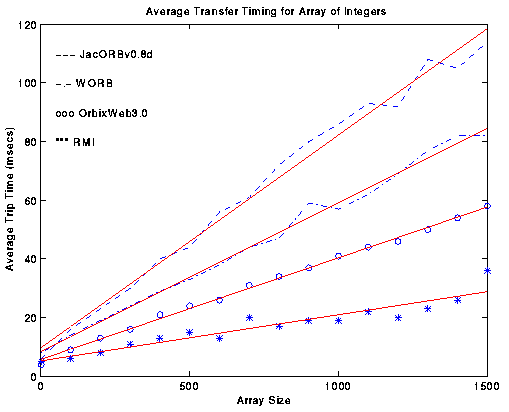
Figure 5.2:
IIOP communication performance for variable size integer array transfer by four Java ORBs: JacORB, JWORB, OrbixWeb and RMI. As seen, initial JWORB performance is reasonable and further optimizations are under way. RMI appears to be faster here than all IIOP based models.
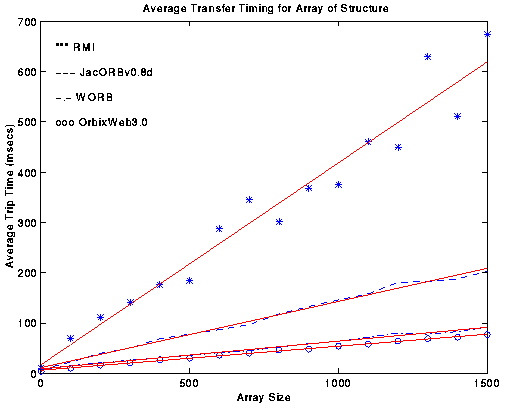
Figure 5.3:
IIOP communication performance for transferring a variable size array of structures by four Java ORBs: JacORB, JWORB, OrbixWeb and RMI. Poor RMI performance is due to the object serializationoverhead, absent in the IIOP/CDR protocol.

Figure 5.4:
Initial performance comparison of a C++ ORB (omniORB )[36] with the fastest (for integer arrays) Java ORB (RMI). As seen, C++ outperforms Java when passing data between distributed objects by a factor of 20.
The timing results presented in Figures 5.2-4 indicate that that JWORB performance is reasonable when compared with other ORBs even though we haven't invested yet much time into optimizing the IIOP communication channel. The ping value for various ORBs is the range of 3-5 msecs which is consistent with the timing values reported in the Orfali and Harkey book [2]. However, more study is needed to understand detailed differences between the slopes for various ORBs. One reason for the differences is related to the use of Java object serialization by RMI. In consequence, each structure transfer is associated with creating a separate object and RMI currently performs poorly for arrays of structures. JacORB uses object serialization also for arrays of primitive types and hence its performance is poor on both figures.
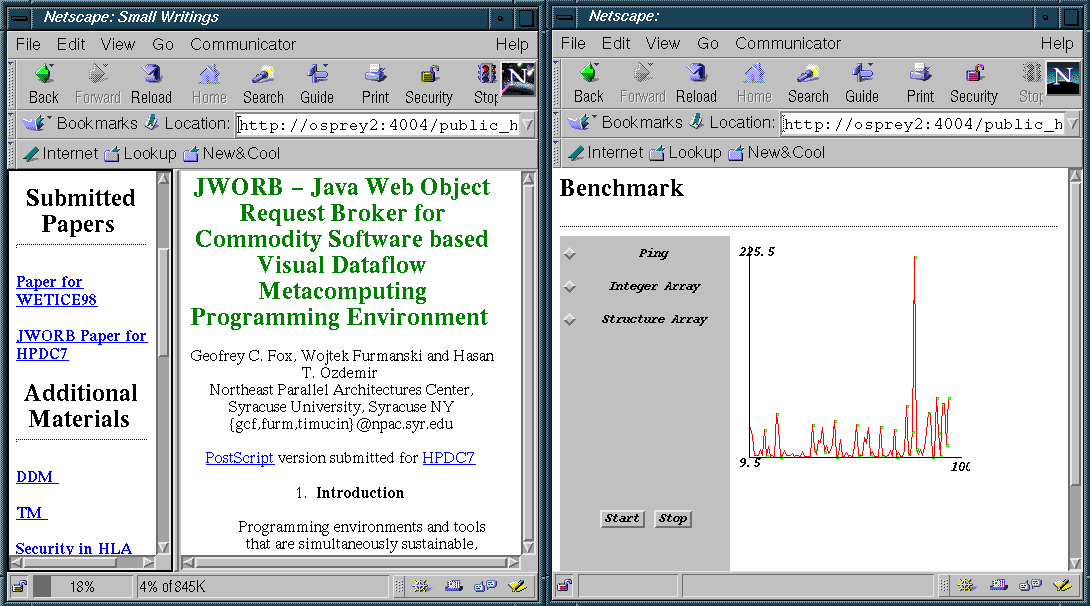
Figure 5.5:
A simple demo that illustrates interplay between HTTP and IIOP protocols in JWORB. A Netscape4 applet connets as ORBlet to JWORB and it displays real-time ping performance (right frame). During this benchmark, client connects to JWORB also via the HTTP channel by downloading a page (left frame) – this results in a transient performance loss in the IIOP channel, visible as a spike in the time-per-ping real-time plot in the right frame.
We are currently doing a more detailed performance analysis of various ORBs, including C/C++ ORBs such as omniORB2 or TAO that is performance optimized for real time applications. We will also compare the communication channels of various ORBs with the true high performance channels of PVM, MPI and Nexus. It should be noted that our WebFlow metacomputing is based on Globus/Nexus [19][20] backend (see next Section) and the associated high performance remote I/O communication channels wrappedin terms of C/C++ ORBs (such as omniORB2[36]). However the middleware Java based ORB channels will be used mainly for control, steering, coordination, synchronization, load balancing and other distributed system services. This control layer does not require high bandwidth and it will benefit from the high functionality and quality of service offered by the CORBA model.
Initial performance comparison of a C++ ORB (omniORB2) and a Java ORB (RMI) indicates that C++ outperforms Java by a factor of 20 in the IIOP protocol handling software. The important point here is that both high functionality Java ORB such as JWORB and high performance C++ ORB such as omniORB2 conform to the common IIOP standard and they can naturally cooperate when building large scale 3-tier metacomputing applications.
So far, we have got the base IIOP engine of the JWORB server operational and we are now working on implementing the client side support, Interface Repository, Naming Service, Event Service and Portable Object Adapter.
5.2 RTI vs IIOP Performance Analysis
Further the discussion on comparison of RMI and IIOP, we proceed to choose a non-trivial application domain – Image Processing. Using the Java API for Image Processing, Image objects can be created from raw data. The raw data of an existing Image Object can then be examined, and filters created to have modified versions. These Image Objects can be used in exactly the same way as Image objects created by the Java run-time system, they can be drawn to a display surface, or the result of a filtering operation can be used as input for further image processing. Image data is used by objects, which implement the Image Consumer Interface. The Image Consumer & Image Producer are the basis for Image Processing using the AWT.
We implemented [44] the BathGlass Filter, which is normally employed to hide the identity of a person in television documentaries. The filter performing this transformation has been implemented both as a CORBA and RMI remote object implementation. We then proceed to compare the results we obtain in each case. The various issues compared are the initialization times, reference latencies, method invocation latencies with variable pixel arrays to the remote object implementation.
|
Same Machine |
Different Machines |
|
|
Time to initialize the Object Request Broker |
393 ms |
475 ms |
|
Time to bind to the Bathglass Filter Object Implementation |
40 ms |
180 ms |
|
Time to invoke and complete remote operation |
1.263 s |
1.743 s |
Figures 5.6 and 5.7 summarize the initialization and method invocation times when the object implementation resides on the same and different machines.
|
|
Same Machine |
Different Machines |
|
Bind to the Bathglass Filter Object implementation |
200 ms |
614 ms |
|
Time to invoke and complete Remote operation |
246 ms |
744 ms |
Figure 5.7:
RMI Imaging results’ summary
Figure 5.8 provides a comparison of the average time to complete the remote operation, for a given number of (successive) remote method calls. As can be seen clearlythe RMI operation is approximately 50% faster.
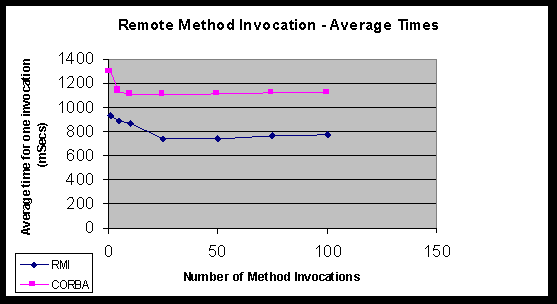
Figure 5.9 demonstrates the average time for completion of remote operation for increasing image sizes, which translates to increasing sizes of the pixel array being sent as an argument in the method invocation. The graph is plotted for 3 different cases Local operation, RMI invocations and CORBA based invocation. As can be seen from the figure, as the size of the array increases RMI operations are approximately 50% faster than CORBA based operations.
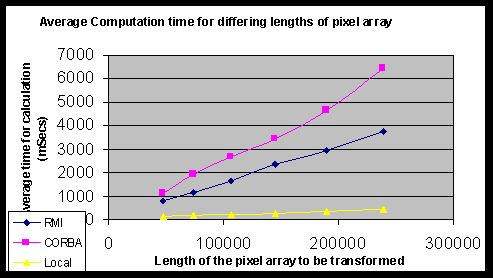
So far all the measurements we have performed have been based on method invocations initiated by a client on the remote object implementation. However, the concept of callbacks is also a very powerful concept employed in distributed systems. Server callbacks are based on the notion that the server can notify the client about certain occurrences, instead of the client polling the server to check for the occurrence of the aforementioned event. This eliminates busy waiting and lends itself for use in asynchronous systems. The only pre-requisite for this operation is for the server to possess a remote reference to the client.
The callback model is prevalent in E-commerce solutions for profiling, personalization, promotions (instant rebates could be offered to a client, if there seems to be an indecision on his part) among others. In the cases mentioned above it’s the business logic, which performs the callbacks on the client’s profile (which is essentially a remote reference, as far as the server is concerned). The logic residing in the client performs the appropriate notification on the client’s windowing system. The callback model also lends itself very naturally to building conferencing infrastructures, where a set of clients could register their remote reference with a central server, and any occurrence on one of the clients is reported to the others by a succession of callbacks by the server. In Java Distributed Collaborative Environment (JDCE) the answer we are looking for is callback performance for the RMI & CORBA case and important clues to their differences in behavior (if there is one). JDCE prototyped at NPAC [44] is an attempt to explore these concepts and to evaluate the feasibility (quantified in terms of high availability, scalability and fault tolerance) of such systems
Performance Analysis Figure 5.10 details the response times when CORBA & RMI clients are in collaboration mode. RMI (2,2) and CORBA (2,2) corresponds to the case where there are 2 so-called data Bahns, with one CORBA and one RMI client registered to each Bahn. RMI (2, 8) and CORBA (2,8) corresponds to the case where there are two data Bahns with each Bahn comprising of 4 RMI and 4 CORBA clients.
The graph indicates the fact that when the CORBA and RMI clients are in collaboration mode, with the respective worker threads being scheduled by the same thread scheduler, the RMI client receives the whole set of broadcast messages even though it was a CORBA client which initiated the broadcast. The graph also demonstrates that as the number of clients increases, as also the messages, the RMI based clients’ response times are almost 200% faster than that of the CORBA clients.
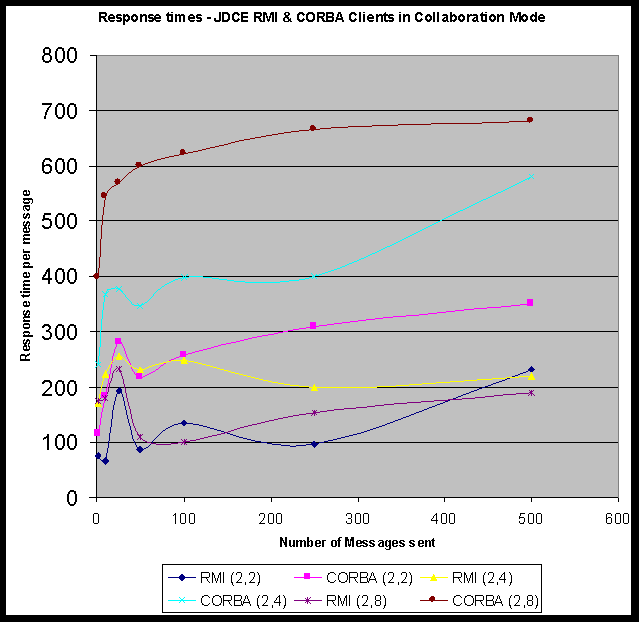
So far, we discussed JWORB as our POW middleware server and JDCE as an example of a POW collaboratory service. In Section 6, we discuss another POW service – Object Web RTI (OWRTI) – that supports multi-player interactive gaming ranging from entertainment to military modeling and simulation applications. These three software entities: JWORB, OWRTI and JDCE were written by us from scratch using Java and following the specifications of the open standards of CORBA, HTTP and HLA. However, the full strength of the POW approach gets fully unleashed only after we activate the powerful capabilities of wrapping the multi-language legacy codes, available in POW via the CORBA bindings for the individual programming languages.
This process of wrapping, interfacing and including the external codes will typically involve other ORBs that cooperate with JWORB and support required languages and capabilities such as e.g. security, quality of service etc. As a simple example of such procedure, we already performed CORBA wrapping for the Jager video game, distributed by DMSO as part of the RTI release. DMSO Jager is written in C++ and it uses DMSO RTI (also written in C++) for its multi-player communication support. We repackaged the game so that it uses our Java based OWRTI communication. The C++/Java bridge was provided by JWORB from the Java side and omniORB2 public domain ORB by Oracle/Olivetti from the C++ side. A more detailed description of this C++ CORBA wrapping can be found in Section 6.2.1.
We currently start exploring the use of JWORB and the CORBA wrapping techniques for selected large scale application domains including the multidisciplinary Landscape Modeling and Simulation (LMS) at CEWES or Quantum Monte Carlo simulation for the Nanomaterials Grand Challenge at NCSA (see Section 3.3).
In Section 5.8, we also discuss our ongoing work on providing WebFlow based visual authoring support for CORBA modules. The end result will be a powerful ‘Visual CORBA’ enviroment that allows to import codes in any of the CORBA supported languages, to package them as WebFlow modules and to use visual composition tools to build distributed object applications in a user-friendly visual interactive mode.
One legacy domain where the Web / Commodity computing community already developed and explored a broad range of Web wrapping techniques is the area of databases. Of particular interest here are commercial RDBMS systems, so far operated in terms of proprietary, vendor-specific form interfaces and now enjoying the open Web browser based GUIs. However, HTML as the topmost and SQL as the bottommost scripting languages is often the only common feature of today’s Web linked database technologies exploiting a range of middleware techniques such as PL/SQL, JDBC, LiveWire, ASP, ColdFusion, Perl etc.
We were recently involved in several Web linked database projects, conducted using various techniques for various communities and customers. Specific practical solutions and design decisions appear often as a result of compromise between several factors such as price vs. functionality tradeoffs for various technologies, project specific requirements, customer preferences etc. We indicate these tradeoffs when discussing the application examples below and then we summarize in the next section the lessons learned so far and our approach towards more uniform and universal, transparently persistent data-stores.
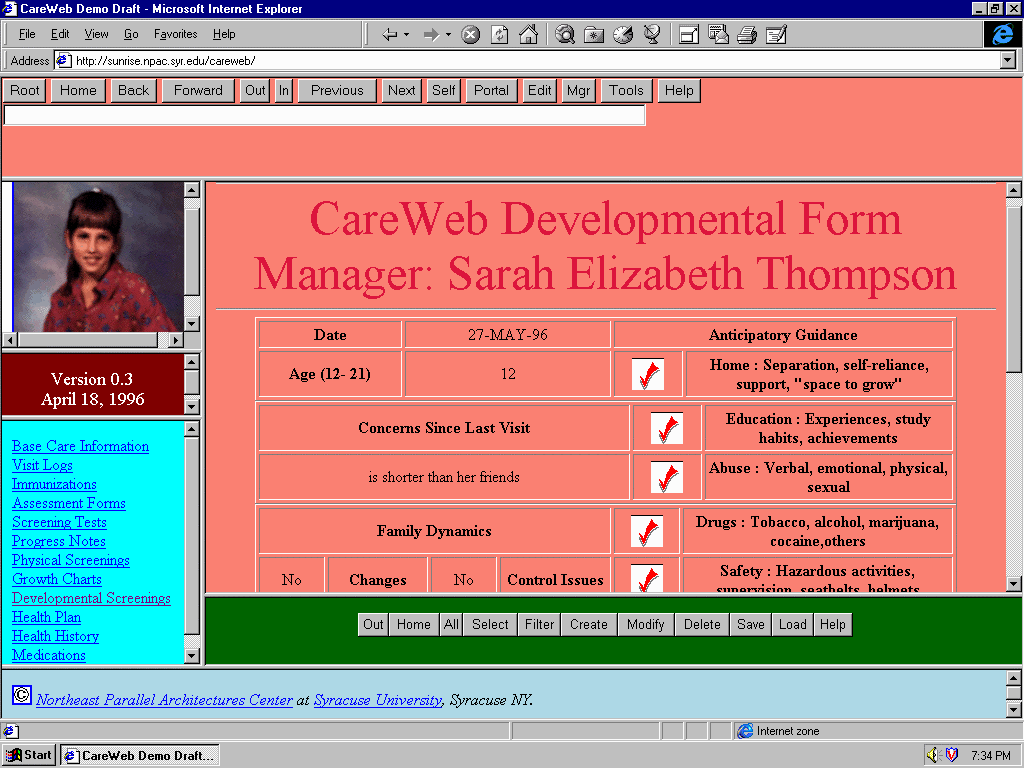
Figure 5.14:
Sample screendump from the early CareWeb prototype at NPAC – Netscape and JavaScript with VIC / VAT collaboratory tools (video, audio, chat, whiteboard) on top of Oracle Database with PL / SQL based HTML generator.
Careweb is a Web based collaborative environment for school nurses with support for: a) student healthcare record database; b) educational materials for nurses and parents; c) collaboration and interactive consultation between nurses, nurse practitioners and pediatricians, including both asynchronous (shared patient records) and synchronous (audio, video, chat, whiteboard) tools.
Early CareWeb prototype (Figure 5.14) was developed at NPAC using Oracle7 database, PL/SQL stored procedures based programming model, and VIC/VAT collaboration tools. We found the Oracle7 model useful but hardly portable to other vendor models, especially after Oracle decided to integrate their Web and Database services.
New production version of CareWeb (Figure 5.15) under development by NPAC spin-off Translet, Inc. is using exclusively Microsoft Web technologies: Internet Explorer, Access/SQL Server databases, ASP/ADO based programming model, and NetMeeting based collaboration tools.
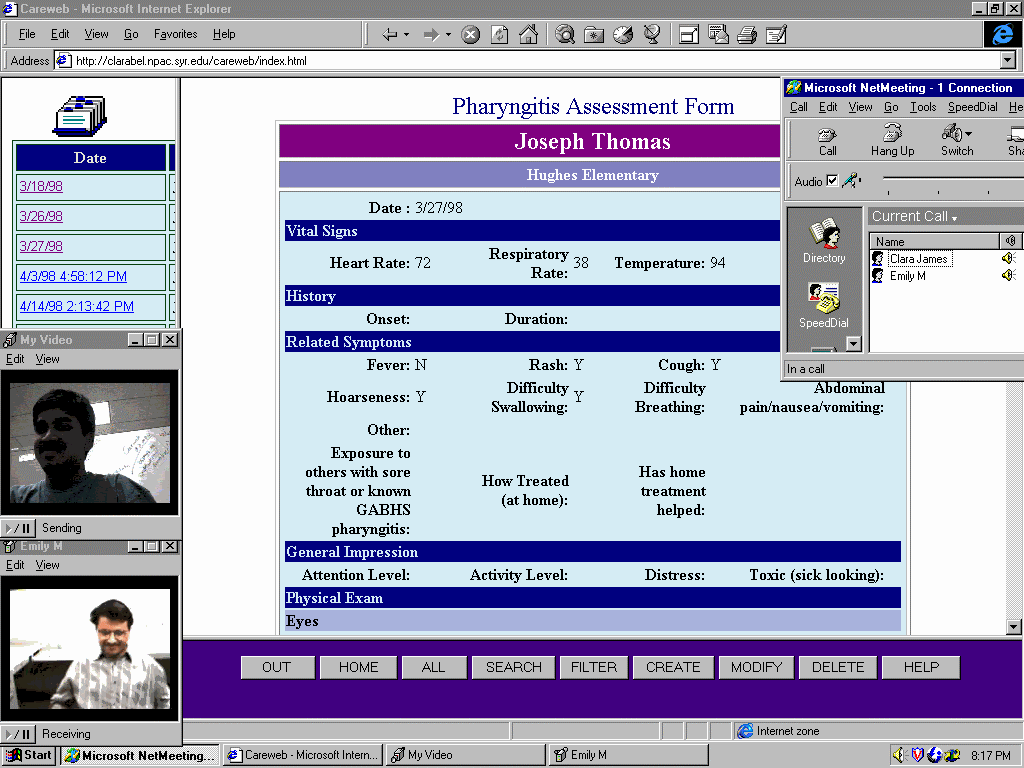
Figure 5.15:
Sample screendump from the production CareWeb system under development by Translet, Inc. – Internet Explorer 4 with NetMeeting collaboratory (video, audio, chat, whiteboard, shared browser) on top of Access or SQL Server database with Active Server Pages based HTML
Language Connect University is another Web/Oracle service constructed by Translet Inc. for the distance education community. Marketed by the Syracuse Language Systems as an Internet extension of their successful CD-ROM based multimedia courses for several foreign languages, LCU offers a spectrum of collaboratory and management tools for students and faculty of a Virtual University. Tools include customized email, student record management, interactive multimedia assignments such as quizzes, tests and final exams, extensive query services, evaluation and grading support, course management, virtual college administration and so on (see Figure 5.17).
We found the Oracle based high end database solution for LCU displayed in Figure 5.16 as appropriate and satisfactory. Possible follow-on projects will likely continue and extend this model towards heterogeneous distributed database environment as shown in Figure 5.18 by adding suitable transparently persistent (e.g. CORBA PSS based) middleware and assuring compatibility with the emergent public standards for distance education such as IMS [78] by Educom.
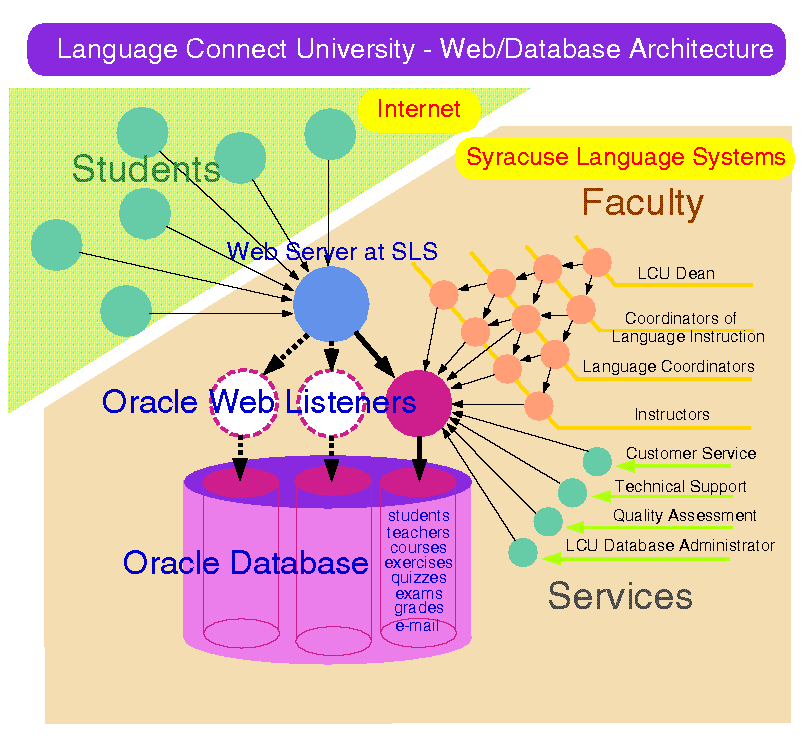
Figure 5.16:
Architecture of the LCU system. Oracle database maintains the course materials nad it provides administrative and content management functions for the Virtual University faculty. Remote students access the database using Internet Explorer Web browser, integrated (as an ActiveX control) with the CD-ROM multimedia application.
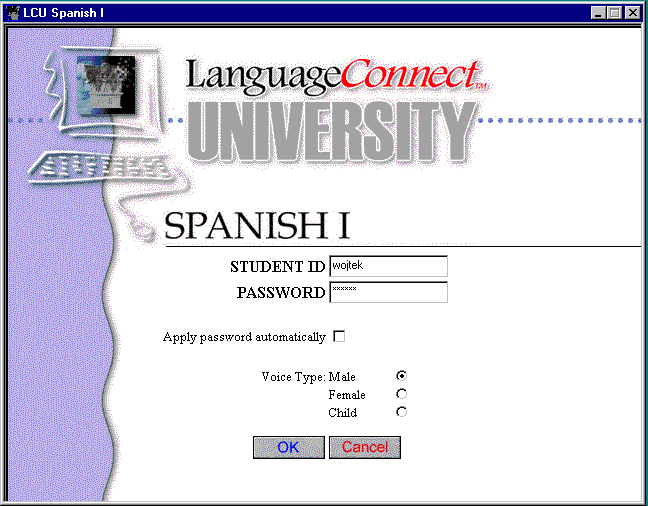

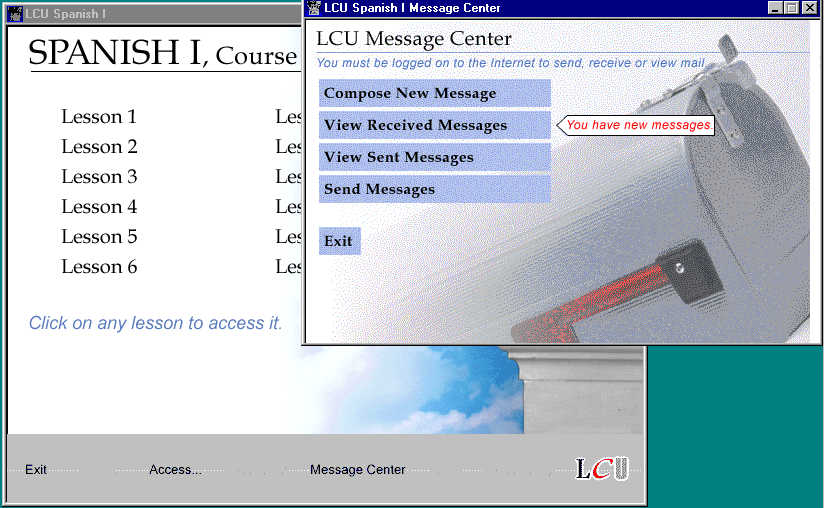
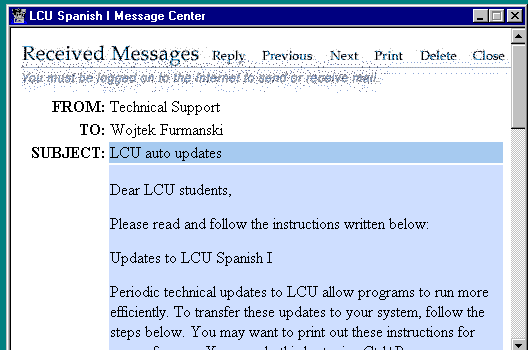
Figure 5.17:
Sample screendumps from the LCU system, illustrating the interplay of the CD-ROM client-side (upper frames) and the Web/Oracle server side (lower frames) processing; the latter includes support for interactive tests, quizzes, exams etc. as well as customized email handling. LCU email is used by students and teachers to communicate about various aspects of the course content, schedule, rules etc.
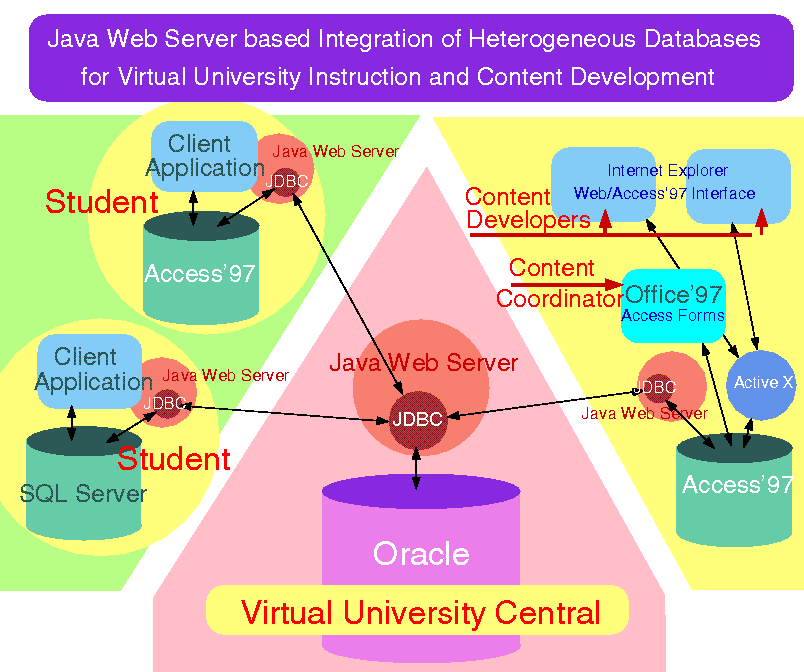
Figure 5.18:
Next step in the LCU evolution, moving towards a POW-like environment with heterogeneous distributed database support. Students download assignments from the central Oracle database to their local Access databases. Content developers use local commodity tools to build new courses and to upload the material to the central database.
FMS Training Space
[37] is an ongoing project at NPAC within the DoD Modernization Program that builds Web based collaboratory training environment for the FMS (Forces Modeling and Simulation) technologies under development by the program. We start with the SPEEDES training which will be gradually extended towards other FMS components such as Parallel CMS, E-ModSAF, HPC RTI, Parallel IMPORT and TEMPO/Thema. FMS Training Space combines lessons learned in our previous Web /Database projects such as CareWeb or LCU with our new WebHLA middleware based on Object Web RTI. The result will be a dynamic interactive multi-user system, with real-time synchronous simulation tools similar to online multi-player gaming systems, and with the asynchronous tools for database navigation in domains such as software documentation, programming examples, virtual programming laboratory etc. Selected screendumps from the preliminary version of the FMS Training Space, including some elements of the HLA, SPEEDES, CMS and ModSAF documentation databases and demonstrated at the DoD UGC 98 Conference [14], are shown in Figure 5.19 and in Section 6.3.1. Object Web RTI based real-time multi-player simulation support is being included in the FMS Training Space with early demos presented during the summer 98 conferences such as the SIW Fall 98 Conference in Orlando [21].
Current version of the FMS Training Space is using Microsoft Web technologies: Internet Information Server, Active Server Pages, Visual Basic Script, Internet Explorer, ActiveX and Java applet plug-ins, Front Page Web Authoring and Access Database. This approach facilitates rapid prototyping in terms of the integrated web/commodity tools from Microsoft and we intend to extend it in the next stage by adding the corresponding support for UNIX, Java, Oracle and Netscape users and technologies.
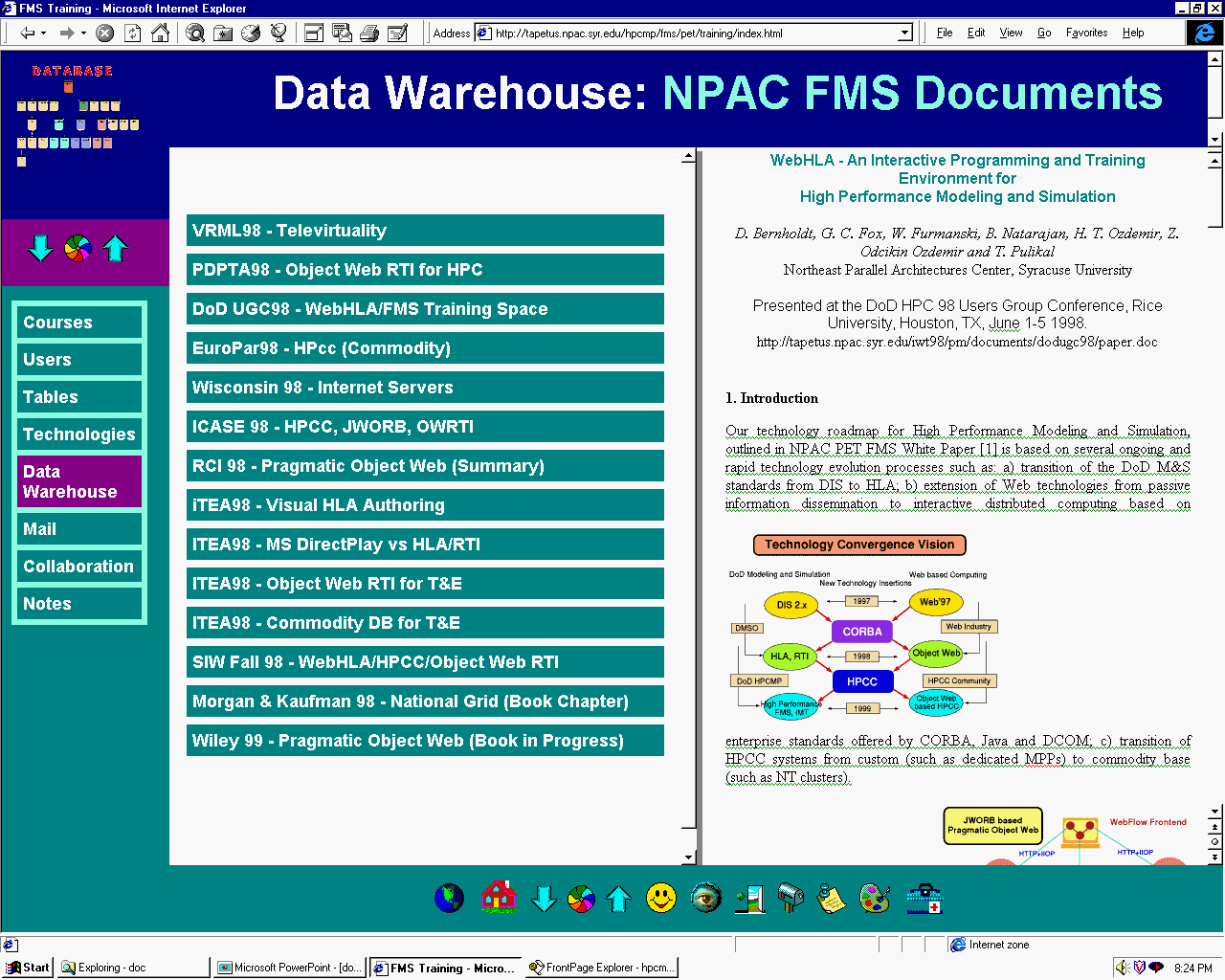
Figure 5.19: Sample screendump from the FMS Training Space: data warehouse component with the database of NPAC FMS ’98 publications
5.5 Universal Persistence Models
In the ideal world, we could think of a universal middleware data representation that would bind in some standardized fashion to the relational or object databases and to the flat file systems in the back-ends, and to the HTML in the front-end. This facilitates cross-vendor, cross-platform support for Web linked data-stores. In the real world, we have four competing middleware technologies: Java, CORBA, COM and WOM, and each of them offers or attempts at a different solution for the universal middleware data representation. Following our POW methodology, we summarize here the ongoing activities within the Java, CORBA, COM and WOM communities in the area of universal persistence frameworks, i.e. abstract data models that would span multiple vendors and various storage media such as relational or object databases and flat file systems.
JDBC and JavaBlend JavaSoft’s Java Database Connectivity (JDBC) is a standard SQL database access interface for accessing a wide range of relational databases from Java programs. It encapsulates the various DBMS vendor proprietary protocols and database operations and enables applications to use a single high level API for homogenous data access. JDBC API defined as a set of classes and interfaces supports multiple connections to different databases simultaneously.
JDBC API mainly consists of classes and interfaces representing database connections, SQL statement’s, result sets, database metadata, driver management etc. The main strength behind the JDBC API is its platform- and database-independence and ease of use, combined with the powerful set of database capabilities to build sophisticated database applications. The new JDBC specification (JDBC 2.0) which was released recently adds more functionality like support for forward and backward scrolling, batch updates and advanced data types like BLOB, and Rowsets which are JavaBeans that could be used in any JavaBean component development, etc. Other important features include support for connection pooling, distributed transaction support and better support for storing Java objects in the database.
Despite of the simplicity of use and the wide acceptability, the JDBC API has its own disadvantages. The API is primarily designed for relational database management systems and thus is not ideal for use with object databases or other non-SQL databases. Also, there are several problems due to various inconsistencies present in the driver implementations currently available.
JavaBlend, a high-level database development tool from JavaSoft that will be released this year, enables enterprises to simplify database application development and offers increased performance, sophisticated caching algorithms and query processing to offload bottlenecked database servers. It is highly scalable because it is multi-threaded and has built-in concurrency control mechanisms. It provides a good object-relational mapping that fits best into the Java object model.
UDA: OLEDB and ADO
Universal Data Access (UDA) is Microsoft's strategy for high performance data access to a variety of information sources ranging from relational to object databases to flat file systems. UDA is based on open industry standards collectively called the Microsoft Data Access Components. OLEDB, which is the core of Universal Data Access strategy, defines a set of COM interfaces for exposing, consuming and processing of data. OLEDB consists of three types of components: data providers that expose or contain data; data consumers that use this data; and service components that processes or transforms this data. The data provider is the storage-specific layer that exposes the data present in various data stores like relational DBMS, ORDBMS, flat files for use by the data consumer via the universal (store-independent) API.
OLEDB consists of several core COM components such as Enumerators, Data Sources, Commands and Rowsets. Apart from these components, OLEDB also exposes interfaces for catalog information or metadata information about the database and supports event notifications by which consumers sharing a rowset could be notified of changes at real time. Other features of OLEDB that will be added in future are interfaces to support authentication, authorization and administration as well as interfaces for distributed and transparent data access across threads, process and machine boundaries.
While OLEDB is Microsoft's system-level programming interface to diverse data sources, ActiveX Data Objects (ADO) offers a popular, high / application-level data consumer interface to diverse data. The main benefits of ADO are the ease of use, high speed, low memory overhead, language independence and other benefits that comes with the client side data caching and manipulation. Since ADO is a high-level programming interface application developers need not be concerned about memory management and other low-level operations. Some of the main objects in ADO Object model are: Connection, Command, Recordset, Property, Field.
CORBA Persistent State Service: The initial CORBA (see Section 4.2) standard that was accepted by OMG in the persistent objects domain was the Persistent Object Services (POS). The main goals for such a service were to support corporate centric data-stores and to provide a data-store independent and open architecture framework that allows new data-store products to be plugged in at any time. POS consisted of four main interfaces namely, the Persistent Object interface (PO) that the clients would implement, Persistent Id interface (PID) for identifying the PO object, Persistent Object Manager interface (POM) that manages the POS objects and the Persistent Data Service interface (PDS) which actually does the communication with the data-store.
Although this specification was adopted more than three years ago, it saw very little implementations because of it's complexity and inconsistencies. The specification also exposed persistence notion to CORBA clients which was not desirable and the integration with other CORBA services were not well defined. Thus OMG issued a new request for proposal for a new specification, Persistent State Service (PSS) that is much simpler to use and to implement and is readily applicable to existing data stores.
The Persistent State Service specification, currently still at the level of an evolving proposal to OMG led by Iona / Orbix, uses the value notation defined in the new Objects by Value specification for representing the state of the mobile objects. The PSS provides a service to object implementers, which is transparent to a client. This specification focuses on how the CORBA objects interact with the data-store through an internal interface not exposed to the client. The persistent-values are implemented by application developers and are specific to a data-store and can make use of the features of the data-store. The specification also defines interfaces for application-independent features like transaction management and association of CORBA objects with persistent-values.
Web Object Model World-Wide Web Consortium (W3C) develops a suite of new Web data representation and/or description standards such as XML (eXtensible Markup Language discussed in Section 4.4), DOM (Document Object Model) or RDF (Resource Description Framework). Each of these technologies has merit in its own but when combined they can be viewed collectively as a new, very dynamic, flexible and powerful Web Object Model (WOM) [33].
XML is a subset of SGML that acts as a metamodel for specialized markup languages i.e. it allows to define new custom / domain specific tags and document templates or DTDs (Document Type Definitions). Such DTDs provide a natural bridge between Web and Object Technologies since XML documents can be now viewed as instances of the associated DTD classes. DOM makes such analogy even more explicit by offering an orthodox object-oriented API (specified as CORBA IDL) to XML documents. Finally, RDF offers a metadata framework that allows association of a set of named properties and their values with a particular Web resource (URL). In the WOM context, RDF is used to bind in a dynamic and transient fashion the Web Object methods located in some programming language files with the Web Object states, specified in XML files.
Summary As seen from the above discussion, the universal data models are just emerging. Even if most major RDBMS vendors are OMG members, the consensus in the CORBA database community is yet to be reached. WOM is a new, ’97 / ’98 concept and several aspects of and relations between the WOM components listed above are still in the design stage. However, given the ongoing explosion of the Web technologies, one can expect the WOM approach to play a critical role in shaping the universal persistence frameworks for the Internet and Intranets. At the moment, the single vendor models such as JDBC by Sun and OLEDB by Microsoft are ahead the consortia frameworks and in fact the Microsoft UDA solution is perhaps the most complete and advanced as of mid ’98.
HPCC does not have a good reputation for the quality and productivity of its programming environments. Indeed one of the difficulties with adoption of parallel systems, is the rapid improvement in performance of workstations and recently PC's with much better development environments.
Parallel machines do have a clear performance advantage but this for many users, this is more than counterbalanced by the greater programming difficulties. We can give two reasons for the lower quality of HPCC software. Firstly parallelism is intrinsically hard to find and express. Secondly the PC and workstation markets are substantially larger than HPCC and so can support a greater investment in attractive software tools such as the well-known PC visual programming environments. The DcciS revolution offers an opportunity for HPCC to produce programming environments that are both more attractive than current systems and further could be much more competitive than previous HPCC programming environments with those being developed by the PC and workstation world. Here we can also give two reasons. Firstly the commodity community must face some difficult issues as they move to a distributed environment, which has challenges where in some cases the HPCC community has substantial expertise. Secondly as already described, we claim that HPCC can leverage the huge software investment of these larger markets.
In Figure 5.20, we sketch the state of object technologies for three levels of system complexity -- sequential, distributed and parallel and three levels of user (programming) interface -- language, components and visual. Industry starts at the top left and moves down and across the first two rows. Much of the current commercial activity is in visual programming for sequential machines (top right box) and distributed components (middle box). Crossware (from Netscape) represents one of the initial entry points towards distributed visual programming. Note that HPCC already has experience in parallel and distributed visual interfaces (CODE and HenCE as well as AVS and Khoros). We suggest that one can merge this experience with Industry's Object Web deployment and develop attractive visual HPCC programming environments as shown in Figure 5.20.
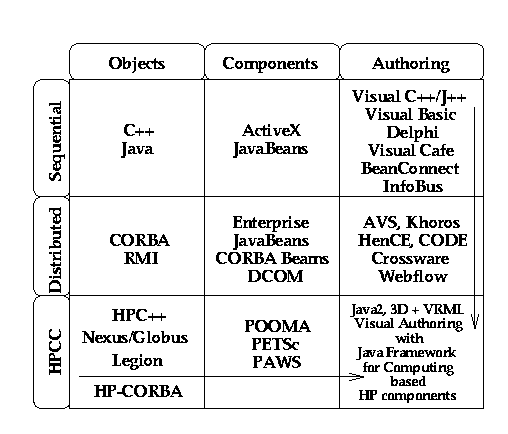
Figure 5.20:
System Complexity ( vertical axis ) versus User Interface ( horizontal axis ) tracking of some technologies
Currently NPAC's WebFlow system [38] uses a Java graph editor to compose systems built out of modules. This could become a prototype HPCC ComponentWare system if it is extended with the modules becoming JavaBeans and the integration with CORBA. Note the linkage of modules would incorporate the generalized communication model of Figure 3.4, using a mesh of JWORB servers to manage a recourse pool of distributedHPcc components. An early version of such JWORB based WebFlow environment is in fact operational at NPAC and we are currently building the Object Web management layer including the Enterprise JavaBeans based encapsulation and communication support discussed in the previous section.
We note that as industry moves to distributed systems, they are implicitly taking the sequential client-side PC environments and using them in the much richer server (middle-tier) environment which traditionally had more closed proprietary systems.
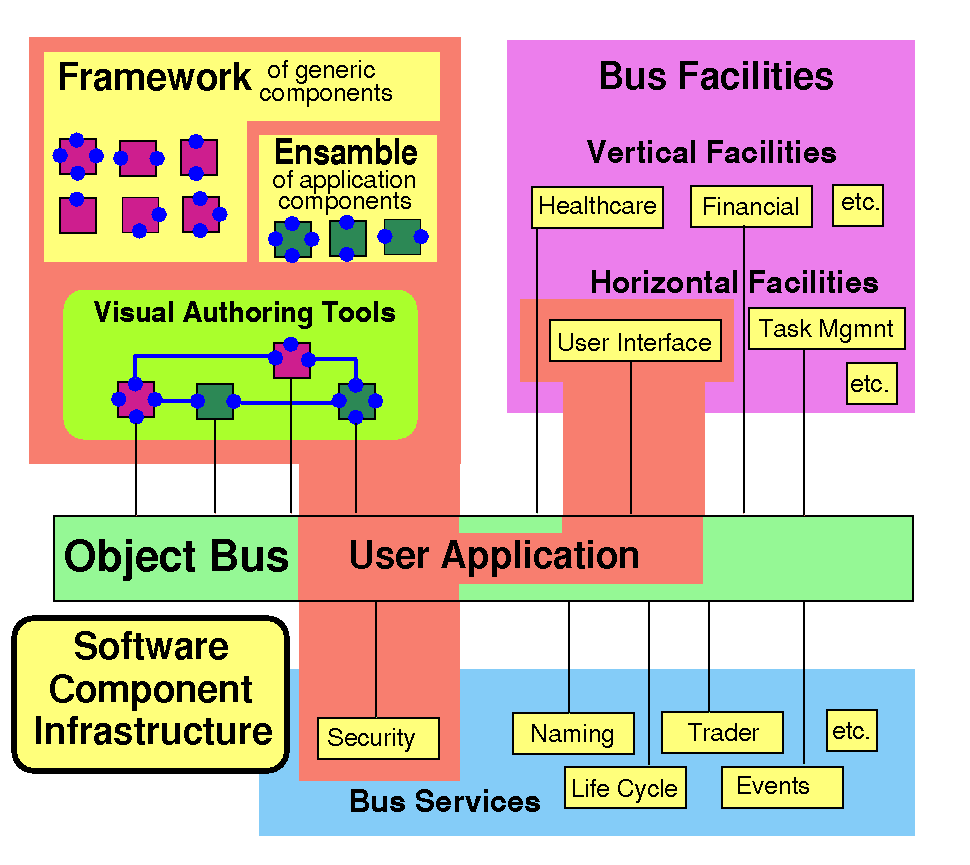
Figure 5.21: Visual Authoring with Software Bus Components
We then generate an environment such as in Figure 5.21 including object broker services, and a set of horizontal (generic) and vertical (specialized application) frameworks. We do not have yet much experience with an environment such as Figure 5.21, but suggest that HPCC could benefit from its early deployment without the usual multi-year lag behind the larger industry efforts for PC's. Further the diagram implies a set of standardization activities (establish frameworks) and new models for services and libraries that could be explored in prototype activities.
5.7 WebFlow – Current Prototype
We describe here a specific high-level programming environment developed by NPAC - WebFlow [1][15][38] and see earlier discussions in Sections 3.2 and 2.4.3 - that addresses the visual componentware programming issues discussed above and offers a user friendly visual graph authoring metaphor for seamless composition of world-wide distributed high performance dataflow applications from reusable computational modules.
Design decisions of the current WebFlow were made and the prototype development was started in `96. Right now, the system is reaching some initial stability and is associated with a suite of demos or trial applications which illustrate the base concepts and allow us to evaluate the whole approach and plan the next steps for the system evolution. New technologies and concepts for Web based distributed computing appeared or got consolidated during the last two years such as CORBA, RMI, DCOM or WOM. In the previous Chapters, we summarized our ongoing work on the integration of these competing new distributed object and componentware technologies towards what we call Pragmatic Object Web [3]. To the end of this Chapter, we present the current WebFlow system, its applications and the lessons learned in this experiment. While the implementation layers of the current (pure Java Web Server based) and the new (JWORB based) WebFlow models are different, several generic features of the
system are already established and will stay intact while the implementation technologies are evolving.
We present here an overview of the system vision and goal’s which exposes these stable generic characteristics of WebFlow.
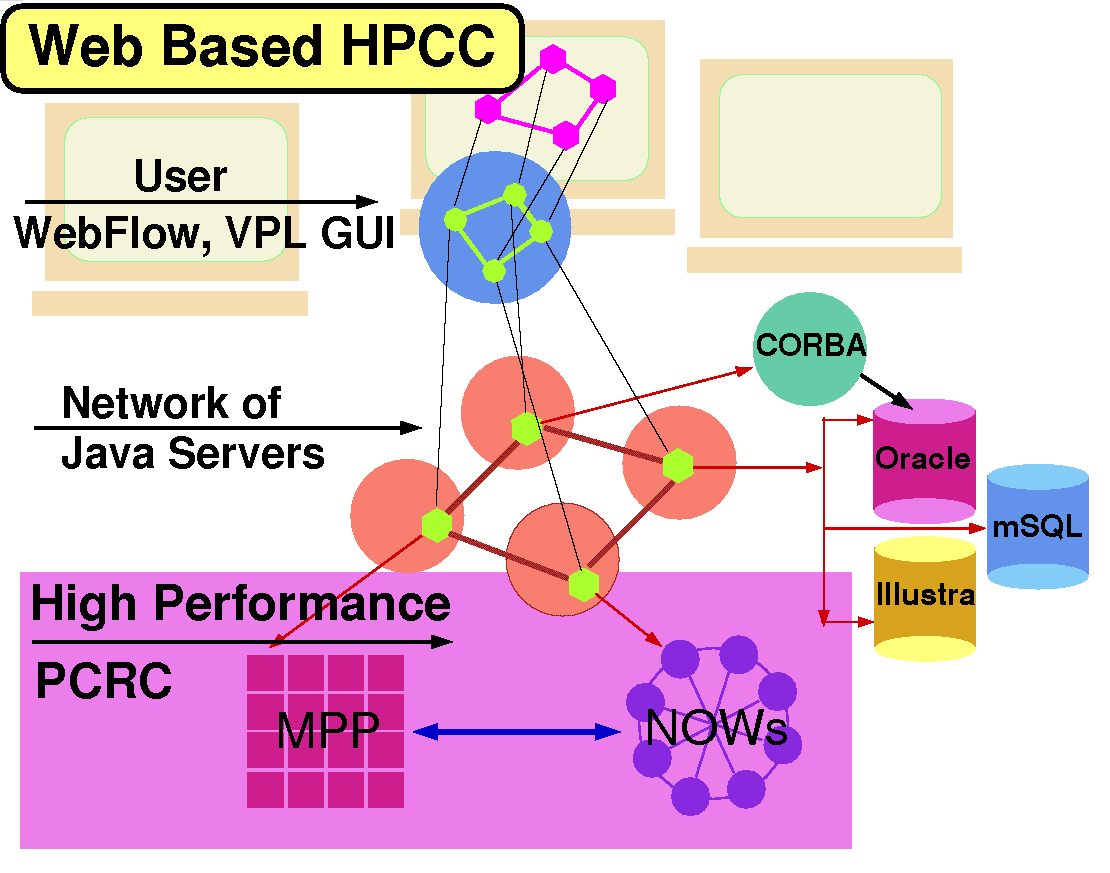
Figure 5.22:
Top view of the WebFlow system: its 3-tier design includes Java applet based visual graph editors in tier 1, a mesh of Java servers in tier 2 and a set of computational (HPC, Database) modules in tier 3.
Our main goal in WebFlow design is to build a seamless framework for publishing and reusing computational modules on the Web so that the end-users, capable of surfing the Web, could also engage in composing distributed applications using WebFlow modules as visual components and WebFlow editors as visual authoring tools. The success and the growing installation base of the current Web seems to suggest that
a suitable computational extension of the Web model might result in such a new promising pervasive framework for the wide-area distributed computing and metacomputing.
In WebFlow, we try to construct such an analogy between the informational and computational aspects of the Web by comparing Web pages to WebFlow modules and hyperlinks that connect Web pages to inter-modular dataflow channels. WebFlow content developers build and publish modules by attaching them to Web servers. Application integrators use visual tools to link outputs of the source modules with inputs of the destination modules, thereby forming distributed computational graphs (or compute-webs) and publishing them as composite WebFlow modules. Finally, the end-users simply activate such compute-webs by clicking suitable hyperlinks, or customize the computation either in terms of available parameters or by employing some high-level commodity tools for visual graph authoring.
New element of WebFlow as compared with the current "vertical" (client-server) instances of the computational Web such as CGI scripts, Java applets or ActiveX controls is the "horizontal" (server-server) inter-modular connectivity (see Figure 5.22). This is specified by the compute-web graph topology and enabling concurrent world-wide data transfers, either transparent to or customizable by the end-users depending on their preferences.
Some examples of WebFlow computational topologies include:
a) ring - post-processing an image by passing it through a sequence of filtering (e.g. beautifying) services located at various Web locations;
b) star - collecting information by querying a set of distributed databases and passing each output through
a custom filter before they are merged and sorted according to the end-user preferences;
c) (regular) grid - a large scale environmental simulation which couples atmosphere, soil and water simulation modules, each of them represented by sub-meshes of simulation modules running on high performance workstation clusters;
d) (irregular) mesh - a wargame simulation with dynamic connectivity patterns between individual combats, vehicles, fighters, forces, environment elements such as terrain, weather etc.
When compared with the current Web and the coming Mobile Agent technologies, WebFlow can be viewed as an intermediate/transitional technology - it supports a single-click automation/aggregation for a collection of tasks/modules forming a compute-web (where the corresponding current Web solution would require a sequence of clicks), but the automation/aggregation patterns are still deterministic, human designed and manually edited (whereas agents are expected to form goal driven and
hence dynamic, adaptable and often stochastic compute-webs).
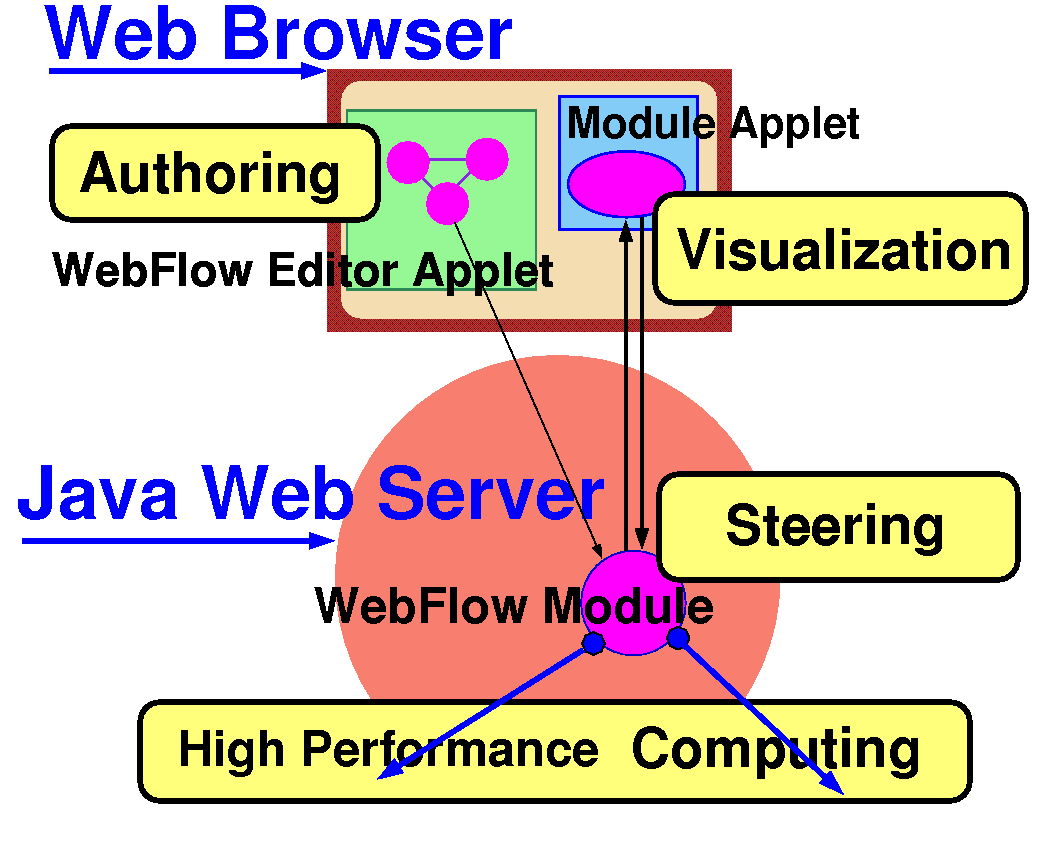
Figure 5.23:
Front-end perspective on the 3-tier architecture of the WebFlow systerm. WebFlow. WebFlow module is instantiated by the WebFlow editor applet, it connects to the HPC backend and it optionally spawns a module specific front-end applet used for the visualization or runtime steering purposes.
Current WebFlow is based on a coarse grain dataflow paradigm (similar to AVS or Khoros models) and it offers visual interactive Web browser based interface for composing distributed computing (multi-server) or collaboratory (multi-client) applications as networks (or compute-webs) of Internet modules.
WebFlow front-end editor applet offers intuitive click-and-drag metaphor for instantiating middleware or backend modules, representing them as visual icons in the active editor area, and interconnecting them visually in the form of computational graphs, familiar for AVS or Khoros users.
WebFlow middleware is given by a mesh of Java Web Servers, custom extended with servlet based support for the WebFlow Session, Module and Connection Management. WebFlow modules are specified as Java interfaces to computational Java classes in the middleware or wrappers (module proxies) to backend services (Figure 5.24).
To start a WebFlow session over a mesh of the WebFlow enabled Java Web Server nodes, user specifies URL of the Session Manager servlet, residing in one of the server nodes (Figure 5.24).
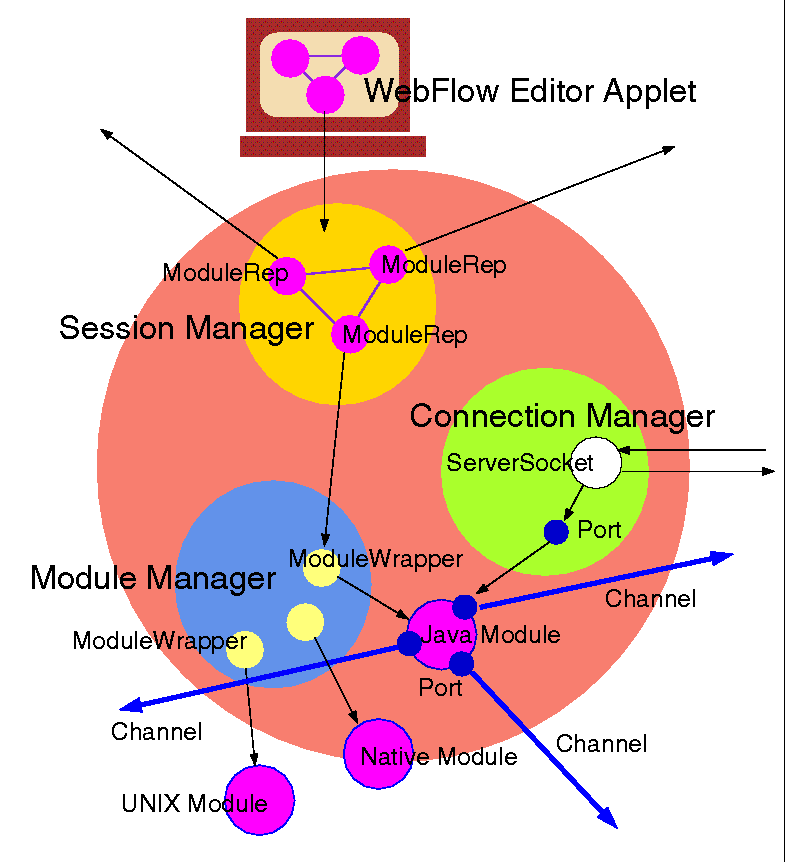
Figure 5.24:
Architecture of the WebFlow server: includes Java servlet based Session, Module and Connection Managers responsible for interacting with front-end users, backend modules and other WebFlow servers in the middleware.
The server returns the WebFlow editor applet to the browser and registers the new session. After a connection is established between the Editor and the Session Manager, the user can initiate the compute-web editing work. WebFlow GUI includes the following visual actions:
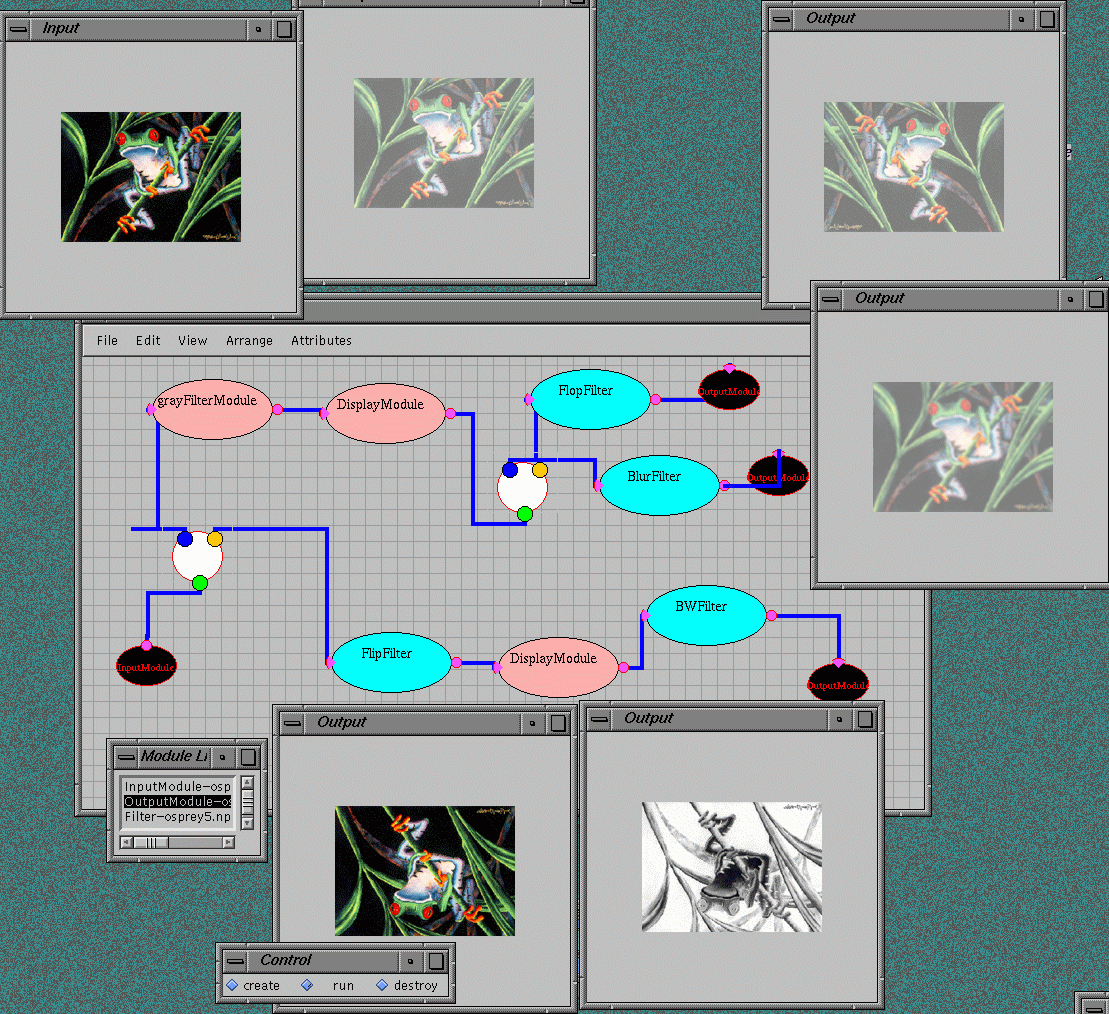
Figure 5.25:
A sample WebFlow application in the imaging domain: an input image stream is forked via multiplexing modules (white blobs) and sent to a set of imaging filters and then to the output modules, displaying the processed images in their visualization applets.
WebFlow Module is a Java Object which implements webflow.Module interface with three methods: init(), run() destroy(). The init() method returns the list of input and output ports used to establish inter-modular
connectivity, and the run() and destroy() methods are called in response to the corresponding GUi actions
described above.
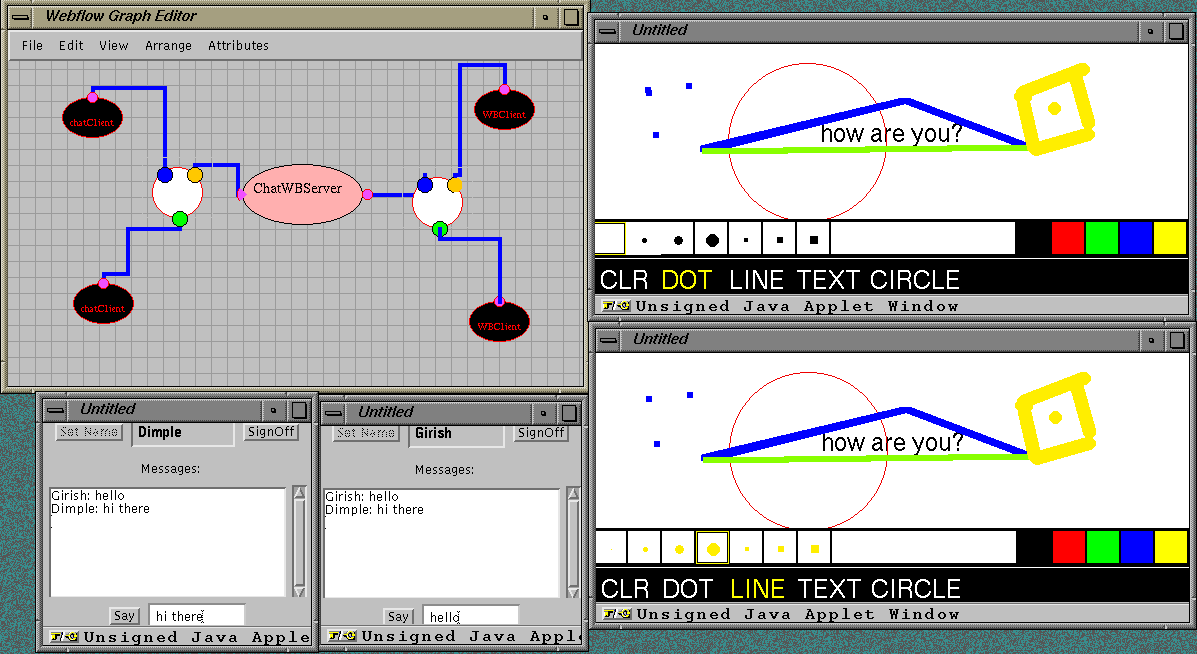
Figure 5.26:
A sample WebFlow application for visual composition of a collaboratory session. Collaboratory server (based on JSDA technology from Sun Microsystems) and a set of standard collaboratory tools (chat, whiteboard) are mapped on WebFlow modules. WebFlow dataflow editor is used to select required tools, participants and to establish required connectivities for a particular collaboratory session and channels.
5.8 WebFlow meets CORBA and Beans
We are now extending the 100% pure Java WebFlow model described above by including support for CORBA modules and the associated bindings for other programming languages. In this section, we summarize the current status of this ongoing work.
In the standards based approach to WebFlow, we employ CORBA in the implementation of the back-end. One of the primary goals of WebFlow is to provide a language independent interaction between module (units of computation). This translates into the ability of the run-time system to cascade computational units implemented in different languages and perform invocations transparently. CORBA can be viewed as an environment to support the development of a complete new system or an environment for integrating legacy systems and sub-systems. An implementation of the standard defines a language and platform-independent object bus called an ORB (Object Request Broker), which lets objects transparently make requests to, and receive responses from, other objects located locally or remotely. Each implementation of the CORBA standard is able to communicate with any other implementation of the standard, regardless of the language used to implement the standard. This stated, it should be easy to visualize the situation where some modules could published to a C++ ORB, some to a Java ORB and the utilization of these modules in some computation. Next, we employ the CORBA Naming service to create a remote information base of the various modules available for computation.
The CORBA Naming Service The Naming Service provides the ability to bind a name to an object relative to a naming context. A naming context is an object that contains a set of name bindings in which each name is unique. To resolve a name is to determine the object associated with the name in a given context. Through the use of a very general model and dealing with names in their structural form, naming service implementations can be application specific or be based on a variety of naming systems currently available on system platforms.

Figure 5.27:
Sample screendump from the WebFlow demo presented at Supercomputing ’97: a set of real-time visualization modules is attached to the HPC simulation module (Binary Black Holes) using WebFlow visual dataflow editor (upper left frame).
WebFlow Widgets A Connection Object represents each visually composed computational graph. The Resource Description Format (RDF[39]) is used for capturing metadata about the graph. The validity of the inter-connections within the computational graph is check by the Connection Manager. An exception hierarchy is in place to respond to failure methods in invocation or location of the distributed modules. A module is a nugget of computation implementing the Module interface. We have an interface inheritance mechanism whereby specific application domains could extend the Module interface to facilitate initializations and retrieval of results. Thus in the Imaging Domain, one would have a method for setting and getting pixels, while employing the run() method in the Module Interface to effect the filtering operation. The Session Manager provides information about the namespace and aids in the process of information mining and execution of connection graphs within the name space. Besides this WebFlow also has the notion of Composite Modules, which could be published to the Naming Service and thus, be available for future reference. It should be noted that since the composite module inheritance tree includes the Module interface, the run() method could be invoked as if it were a module.
All modules conform to the Java Beans naming conventions and provide additional component information through the BeanInfo class. Intuitively, it follows therefore that, using the Java core reflection and Beans introspection, the properties, methods and other attributes could be discovered at run-time and connections can be made across module methods. To put it briefly WebFlow extends the Visual Programming paradigm to the distributed object world, and provides the end user with the tools and means to build sophisticated distributed applications without writing a single line of code.
5.9 WebFlow – Next Steps Towards Visual POW
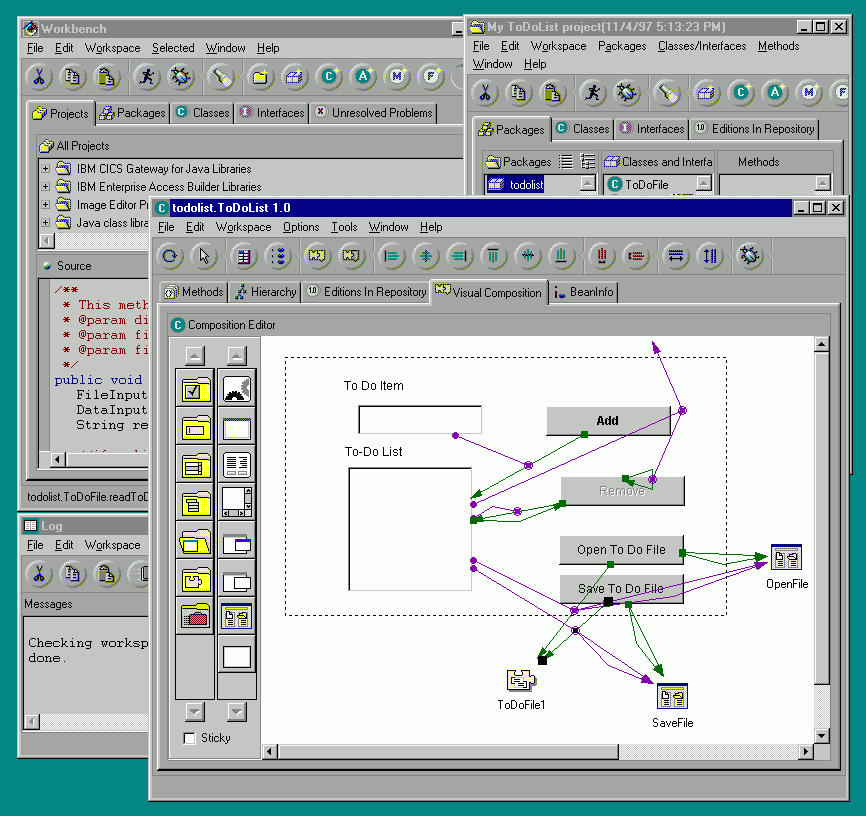
Figure 5.28:
Sample screendump from the VisualAge for Java – a visual authoring tool for Java applications, applets and beans from IBM. The editor panel illustrates GUI applet under construction with nodes representing visual controls and with connection lines representing user or system events.
Our current visual metaphor in WebFlow is reflecting today's industry standards and best practice solutions, developed and tested by systems such as AVS and Khoros. Thus it is based on visual interactive graph editing with graph nodes representing modules/operations and graph links representing connections and dataflow channels. However, the new generations of client technologies such as JavaBeans or ActiveX admit several more elaborate and dynamic visual paradigms in which module icons are replaced by full-blown applets, OLE controls or other dynamic GUI widgets. Further, fixed type data channels are replaced by dynamic event/listeners or consumer/producer or publisher/subscriber associations.
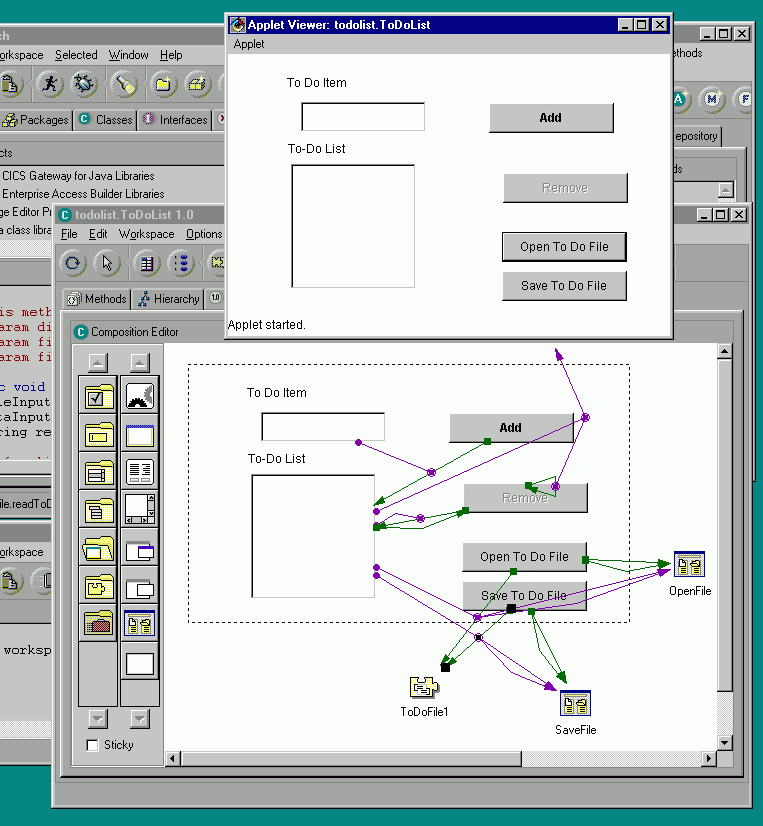
Figure 5.29:
Sample screendump from the VisualAge for Java – a visual authoring tool for Java applications, applets and beans from IBM. The editor (lower) panel is described in Fig. 41; the popup window (upper panel) represents the actual GUI control constructed in the visual mode and wired as specified on the editor panel.
As part of a study of new visual programming standards, we have analyzed recently a suite of new tools appearing on the rapidly growing visual authoring market, including VisualStudio from JavaSoft, VisualAge from IBM, VisualCafe from Symantec, Rational Rose from Rational and VisualModeler from Microsoft. It appears that the visual componentware authoring products are still based on early custom models but there is already a promising stable standard initiative in the area of visual object-oriented design, represented by Uniform Modeling Language (UML).
UML is developed by an industry consortium led by Rational and supported by Microsoft, and was recently adopted as CORBA standard by OMG (together with the associated Meta Object Facility). Hence, we are witnessing here one distinctive example of a truly universal emerging standard candidate agreed upon by all major players. UML offers a broad spectrum of visual authoring graph topologies, adequate for various stages of the software process and representing diverse views of the modeling system such as use-case view, logical view, component view, concurrency view or deployment view.
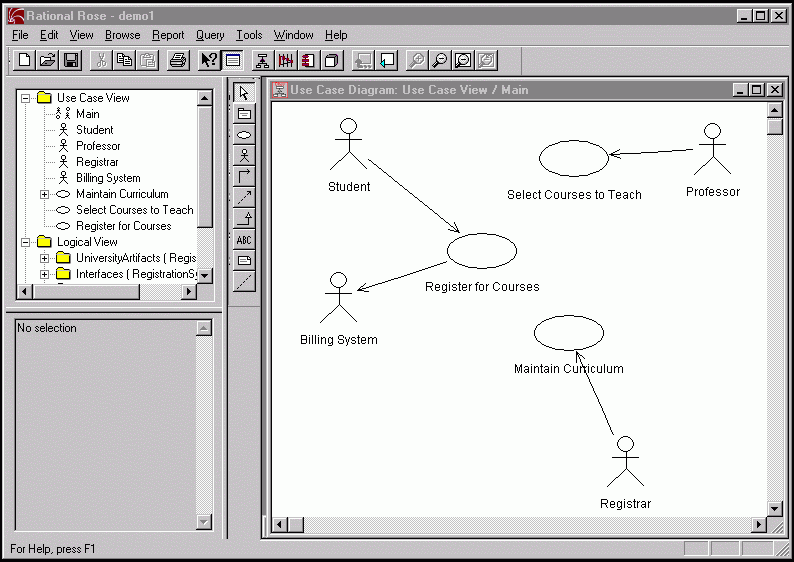
Figure 5.30:
A sample Use Case UML diagram. Typical visual icons here include actors (i.e. user types e.g. student, professor) and their typical actions (e.,g. select course, register etc.). Use case diagrams are helpful in the early design stage to grasp the customer requirements and to provide input for a more formal OOA&D process that follows and other UML diagams topologies described and illustrated below.
The rich collection of UML graph topologies includes: use-case diagrams (for sketching initial customer requirements), class diagrams (with inter-class relationships such as inheritance or aggregation), object diagrams (with object methods and attributed), state diagrams (visualizing stateful objects are final state machines), sequence diagrams (exposing temporal aspects of object interactions), collaboration diagrams (exposing the spatial/topological aspects of object interactions), activity diagrams (representing the workflow and concurrency relations between object methods), component diagrams (with the actual software entities as nodes), deployment diagrams (with the physical hardware platforms as nodes).
UML is a formally specified open extensible standard. The model is being rapidly adopted by the industry and is already triggering the first generation commodity tools for advanced visual authoring such as Rational Rose from Rational or VisualModeler from Microsoft. These tools are currently focused on fine grain object level visual software development and they offer 'round-trip engineering' support. Visual models can be converted into language specific code stubs/skeletons, and the full codes (both pre-existing and visually developed) can be reverse-engineered to expose their internal structure and to enable further editing in terms of UML graph topologies discussed above.
To our knowledge, current UML tools do not address yet the runtime visual authoring via coarse grain module composition as offered by WebFlow, but such dynamic extensions are natural in UML. We therefore propose to adopt UML as WebFlow tier 1 visual standard and to extend the language using its intrinsic mechanisms so that both the modeling/development time and simulation/runtime visual frameworks are supported within a uniform and consistent standard paradigm. In fact, current WebFlow model can be viewed as a runtime specialization of the UML activity diagrams - hence the dataflow model of WebFlow as derived from AVS/Khoros embeds naturally in UML and it gets reinforced by several other views and complementary graph topologies discussed above.
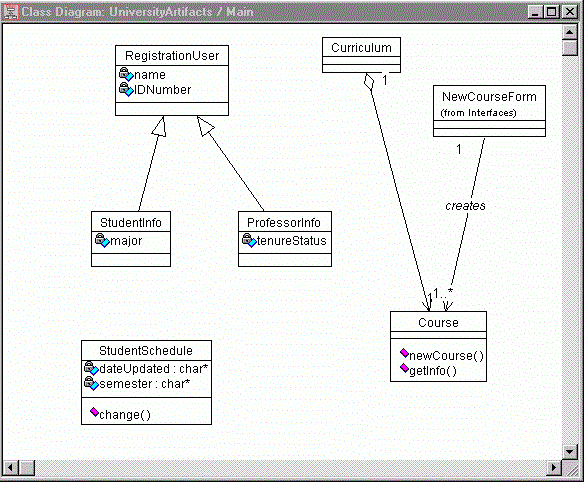
Figure 5.31:
A sample UML Class diagram. Boxes represent classes and include attribute lists, connection lines represent inheritance (super, sub) or aggregation / containment (parent, child) relations.
UML activity diagrams represent also the first step towards visual standards for parallel programming. The dataflow model itself is based on the OR-gate synchronization (a module responds to data changes on any of its input channels). UML also adds AND-gate synchronization and some other visual parallel constructs (such as implicit iterator that implies concurrent replicas of a marked branch of the graph).
The current early visual parallel processing support in UML is clearly driven by the SMP architectures. Some other previous efforts within the HPCC community such as HeNCE or CODE or more recently Cumulvs are addressing visual concurrency for shared memory massively parallel and distributed processing architectures. We believe that there are interesting research issues in reexamining these approaches from the UML standard perspective in search of new universal visual extension patterns that would allow one to express platform-independent concurrency in terms of suitable visual controls.
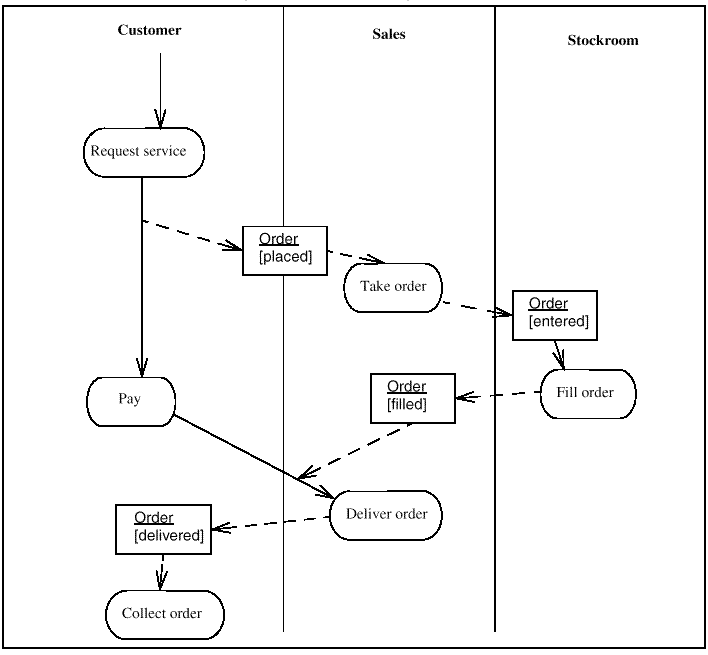
Figure 5.32:
Sample UML Activity Diagram. Columns (verical strips) are mapped on the individual objects, nodes represent methods and connectio n lines represent events, dataflow or argument passing associated with method invocation.
The complex process of building HPDC software involves several natural hierarchy levels, starting from individual functions/methods, grouped into sequential and parallel objects, then packaged as single- or multi-server modules, and finally composed as local or distributed components to form metacomputing applications. Previous visual approaches addressed selected aspects of but none has succeeded yet in capturing the totality of this complex process.
The unique position of UML is its proposed 'complete solution', realized in terms of a comprehensive set of views, diagrammatic techniques and graph topologies. In the context of WebFlow, it offers a promising common visual platform for (parallel) module developers and (distributed) module integrators. Each of these groups will adopt the most adequate techniques from the UML arsenal, while maintaining the interaction via overlapping topologies such as activity diagrams (that allow one to mix object-oriented, functional and concurrent processing perspectives).
Parallel module developers will be likely using class and object diagrams on a regular basis. They may also find useful the collaboratory diagrams which, can be used. to visualize spatial collaboration of classes implementing a complex PDE stencil. The sequence or state diagrams could perhaps be useful to detect a deadlock via rigorous temporal or/and state analysis. Expression template programmers might also find useful the UML template notation and provide us with the specific extension requirements in this area to visually represent complex expression trees or to visualize/optimize the intermediate steps of the compiler parse tree.
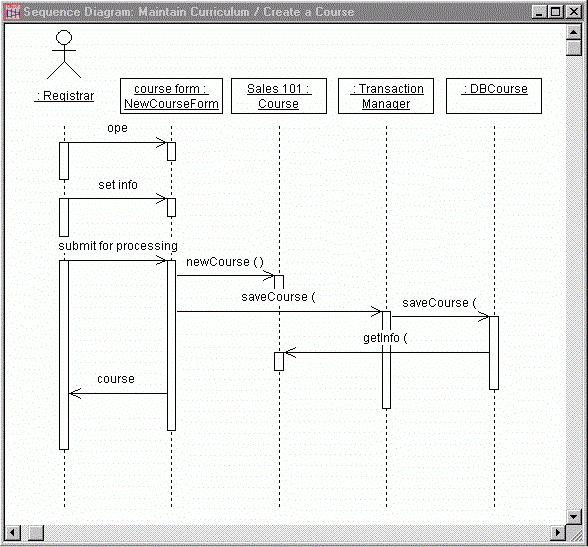
Figure 5.33:
Sample UML Sequence Diagram. Columns (vertical lines) represent objects as in Activity Diagram in Figure 5.32, horizontal lines represent method calls, vertical boxes represent transient / persistent states and the computation time is manifest, flowing vertically down.
Moving further down in the software hierarchy towards finer elements such as individual methods or the actual lines of the source code, we will provide direct customizable links from visual code icons to developer's favored code editors and debuggers. These could include vanilla public domain tools such as vi or emacs; commodity tools of growing popularity such as MS Visual Studio or Rational Rose; and specialized tools for high performance software prototyping such as our DARP package, so far tested in the HPF programming environment.
More generally, we will be working with various groups of WebFlow users to collect their comments, suggestions and requirements for the UML support in the WebFlow front-end. Based on this information, we will provide core UML support for parallel languages such as C++, HPC++, and HPF as well as for parallel objects in frameworks such as POOMA[42]. The WebFlow/UML frontend will be packaged as a Java/CORBA facility that can be used in a standalone mode as a visual parallel authoring toolkit for full-cycle and round-trip software engineering. It can also be offered as a parallel processing extension to commercial authoring tools such as Rational Rose, Visual Modeler and others to come over the next two years. These delivery possibilities will be refined in our discussions with users of our system.
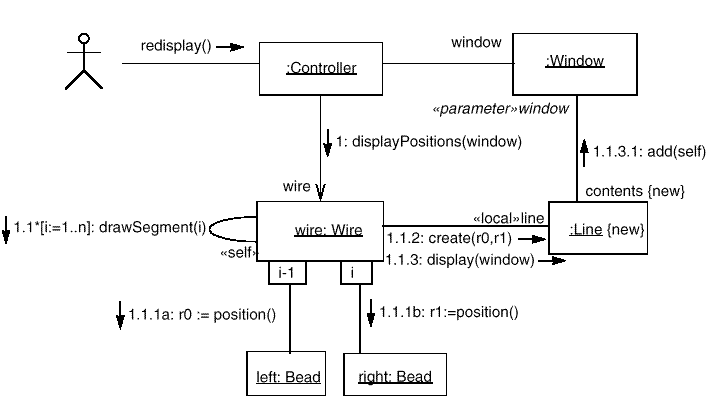
Figure 5.34:
Sample UML Collaboratory Diagram. Nodes represent objects and lines represent method calls as in the Sequence Diagram in Figure 5.33 but time is less explicit here (with time order marked only by integer labels). This technique is used to explose collaboration topologies involving sets of objects (such as a feedback loop in the diagram above).
Finally, we note that the 'round-trip engineering' requires language compiler front-ends and we intend to provide and use here our suite of parallel compiler front-ends developed by the PCRC[41] led by NPAC.
6. Example of POW Application Domain - WebHLA
The technology roadmap for High Performance Modeling and Simulation (Figure 6.1) which underlies our FMS PET program within the DoD HPC Modernization Program explores synergies between ongoing and rapid technology evolution processes such as: a) transition of the DoD M&S standards from DIS to HLA; b) extension of Web technologies from passive information dissemination to interactive distributed object computing offered by CORBA, Java, COM and W3C WOM; and c) transition of HPCC systems from custom (such as dedicated MPPs) to commodity base (such as NT clusters).
One common aspect of all these trends is the enforcement of reusability and shareability of products or components based on new technology standards. DMSO HLA makes the first major step in this direction by offering the interoperability framework between a broad spectrum of simulation paradigms, including both real-time and logical time models.
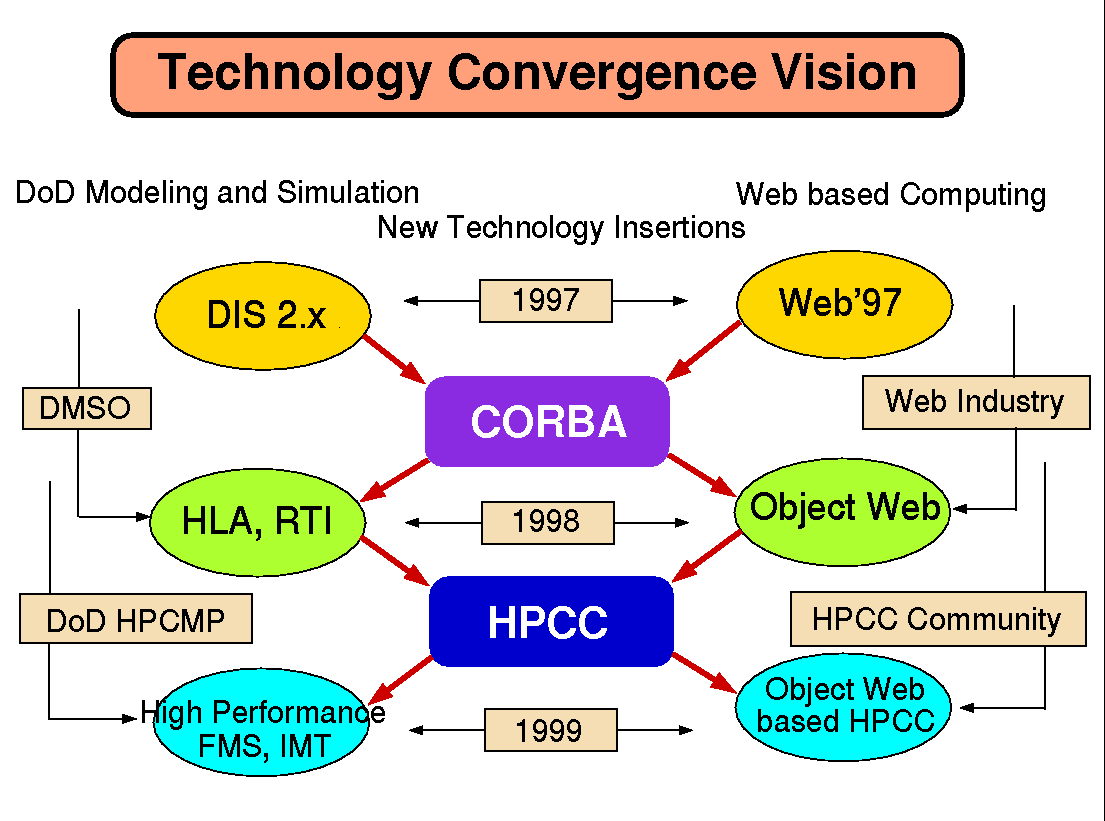
Figure 6.1: Web/Commodity and DoD M&S Technology Evolution Roadmap which underlies our WebHLA, approach: both domains are switching now to distributed object technologies (CORBA insertion) and will soon acquire High Performance Commodity Computing capabilities, e.g. via NT clusters.
However, HLA standard specification leaves several implementation decisions open and to be made by the application developers - this enables reusability and integrability of existing codes but often leaves developers of new simulations without enough guidance. In WebHLA, we fill this gap by using the emergent standards of Web based distributed computing – we call it Pragmatic Object Web [3][2] - that integrate Java, CORBA, COM and W3C WOM models for distributed componentware.
Traditional HPCC, dominated by data parallel MPP didn’t make significant inroads into the DoD M&S where the focus is on task parallel heterogeneous distributed computing. Recent trends towards commodity based HPCC systems such as NT clusters offer a new promising framework for new generation high performance high fidelity M&S environments such as addressed by JSIMS, JWARS, JMASS or Wargame2000 programs.
We therefore believe that WebHLA, defined as the convergence point of the standardization processes outlined above will offer a powerful modeling and simulation framework, capable to address the new challenges of DoD computing in the areas of Simulation Based Design, Testing, Evaluation and Acquisition.
We are addressing WebHLA design and prototype development in a set of PET FMS tasks at ARL and CEWES, including: JWORB based Object Web RTI (Section 6.2.1), WebFlow based Visual Authoring Tools (Section 6.2.2), Data Mining (Section 6.2.4) and HPC Simulation back-ends (Section 6.2.3), and DirectX based multi-player gaming front-ends (Section 6.2.5).
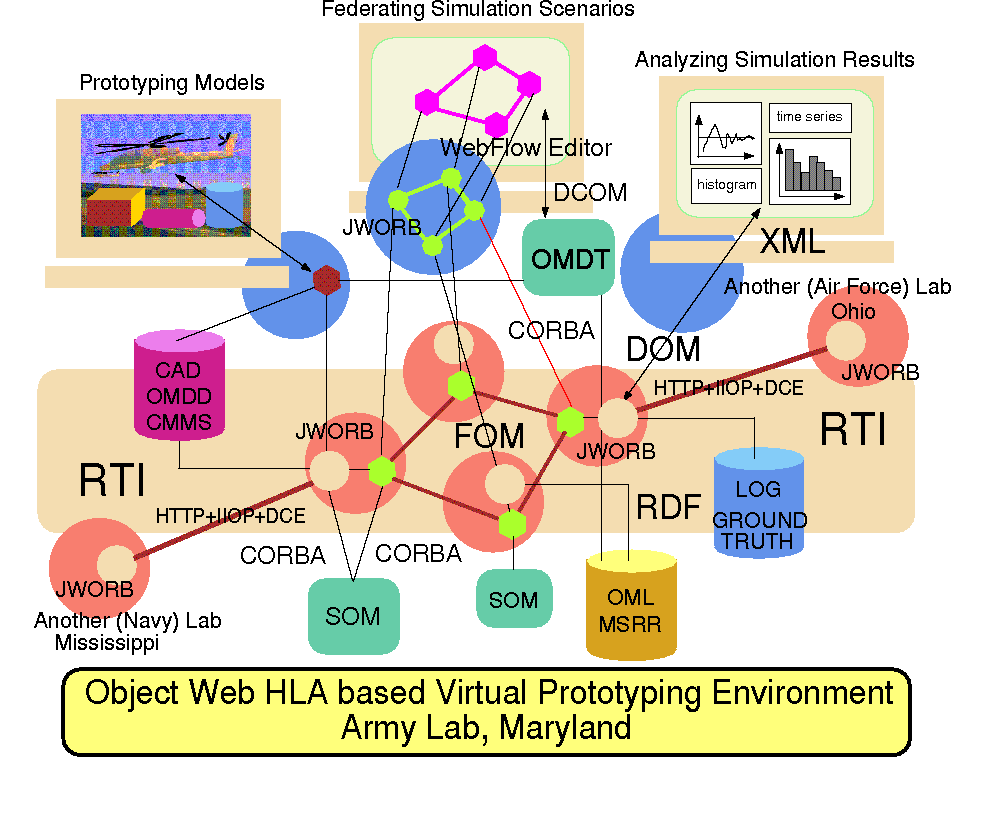
Figure 6.2:
The overall architecture of our WebHLA prototype follows the 3-tier architecture of our Pragmatic Object Web [3] (see Fig. 2) with the RTI-over-JWORB based middleware, backend simulation modules (given by CMS, ModSAF etc. libraries, wrapped via CORBA/COM as FOM or SOM objects) and with the WebFlow/DirectX based visual authoring / runtime front-ends.
In the following, we describe in more detail in Section 6.2 the WebHLA components listed above, followed by a brief overview in Section 6.3 of the emergent WebHLA application domains such as: Distance Training, Resource Management for Metacomputing and/or Commodity Clusters, and Simulation Based Acquisition
Current HLA is a custom distributed object model but DMSO’s longer-range plan includes transferring HLA to industry as CORBA Facility for Modeling and Simulation.
Anticipating these developments, we have recently developed in one of our HPCMP FMS PET projects at NPAC an Object Web based RTI [6][8] prototype, which builds on top of our new JWORB (Java Web Object Request Broker) middleware integration technology.

Figure 6.3:
Illustration of the communication protocol integration within our JWORB based Pragmatic Object Web. JWORB uses Java to integrate HTTP with IIOP and then it connects with NT clusters via COM/CORBA bridge.
JWORB (Figure 6.3) is a multi-protocol Java network server, currently integrating HTTP (Web) and IIOP (CORBA) and hence acting both as a Web server and a CORBA broker. Such server architecture enforces software economy and allows us to efficiently prototype new interactive Web standards such as XML, DOM or RDF in terms of an elegant programming model of Java, while being able to wrap and integrate multi-language legacy software within the solid software-engineering framework of CORBA.
We are now testing this concept and extending JWORB functionality by building Java CORBA based RTI implementation structured as a JWORB service and referred to as Object Web RTI (Figure 6.4). Our implementation includes two base user-level distributed objects: RTI Ambassador and Federate Ambassador, built on top of a set of system-level objects such as RTI Kernel, Federation Execution or Event Queues (including both time-stamp- and receive-order models). RTI Ambassador is further decomposed into a set of management objects, maintained by the Federation Execution object, and including: Object Management, Declaration Management, Ownership Management, Time Management and Data Distribution Management.
RTI is given by some 150 communication and/or utility calls, packaged as 6 main managment services: Federation Management, Object Management, Declaration Managmeent, Ownership Management, Time Management, Data Distribution Management, and one general purpose utility service. Our design shown in fig. 13 is based on 9 CORBA interfaces, including 6 Managers, 2 Ambassadors and RTIKernel. Since each Manager is mapped to an independent CORBA object, we can easily provide support for distributed management by simply placing individual managers on different hosts.
The communication between simulation objects and the RTI bus is done through the RTIambassador interface. The communication between RTI bus and the simulation objects is done by their FederateAmbassador interfaces. Simulation developer writes / extends FederateAmbassador objects and uses RTIambassador object obtained from the RTI bus.
RTIKernel object knows handles of all manager objects and it creates RTIambassador object upon the federate request. Simulation obtains the RTIambassador object from the RTIKernel and from now on all interactions with the RTI bus are handled through the RTIambassador object. RTI bus calls back (asynchronously) the FederateAmbassador object provided by the simulation and the federate receives this way the interactions/attribute updates coming from the RTI bus.
Federation Manager object is responsible for the life cycle of the Federation Execution. Each execution creates a different FederationExecutive and this object keeps track of all federates that joined this Federation.
Object Manager is responsible for creating and registering objects/interactions related to simulation.
Federates register the simulated object instances with the Object Manager. Whenever a new registration/destroy occurs, the corresponding event is broadcast to all federates in this federation execution.
Declaration Manager is responsible for the subscribe/publish services for each object and its attributes. For each object class, a special object class record is defined which keeps track of all the instances of this class created by federates in this federation execution. This object also keeps a seperate broadcasting queue for each attribute of the target object so that each federate can selectively subscribe, publish and update suitable subsets of the object attributes.
Each attribute is currently owned by only one federate who is authorized for updating this attribute value. All such value changes are reflected via RTI in all other federates. Ownership Management offers services for transfering,maintaining and querying the attribute ownership information.
Individual federates can follow different time management frameworks ranging from time-stepped/real-time to event-driven / logical time models. Time Management service offers mechanisms for the federation-wide synchronization of the local clocks, advanced and managed by the individual federates.
Data Distribution Management offers advanced publish / subscribe based communication services via
routing spaces or multi-dimensional hypercube regions in the attribute value space.
In parallel with the first pass prototoype implementation, we are also addressing the issues of more organized software engineering in terms of Common CORBA Services. For example, we intend to use the CORBA Naming Service to provide uniform mapping between the HLA object names and
handles, and we plan to use CORBA Event and Notification Services to support all RTI broadcast/multicast mechanisms. This approach will assure quality of service, scalability and fault-tolerance in the RTI domain by simply inheriting and
re-using these features, already present in the CORBA model.
To be able to run C++ RTI demo examples, we developed a C++ library which: a) provides HLA RTI v1.3 C++ programming interface; and b) it is packaged as a CORBA C++ service and, as such, it can easily cross the language boundaries to access Java CORBA objects that comprise our Java RTI. Our C++ DMSO/CORBA glue library uses public domain OmniORB2.5 as a C++ Object Request Broker to connect RTI Kernel object running in Java based ORB and runs on Windows NT and Sun Solaris 2.5 environments. Through library, user defines the RTIambassador object as usual but in the implementation it actually accesses the OWRTI CORBA service and executes each call on this service. Similarly, user supplied federate ambassador object is managed by a CORBA Object which leaves in the client side and forwards all the call it received from RTI to the user's federate ambassador object.
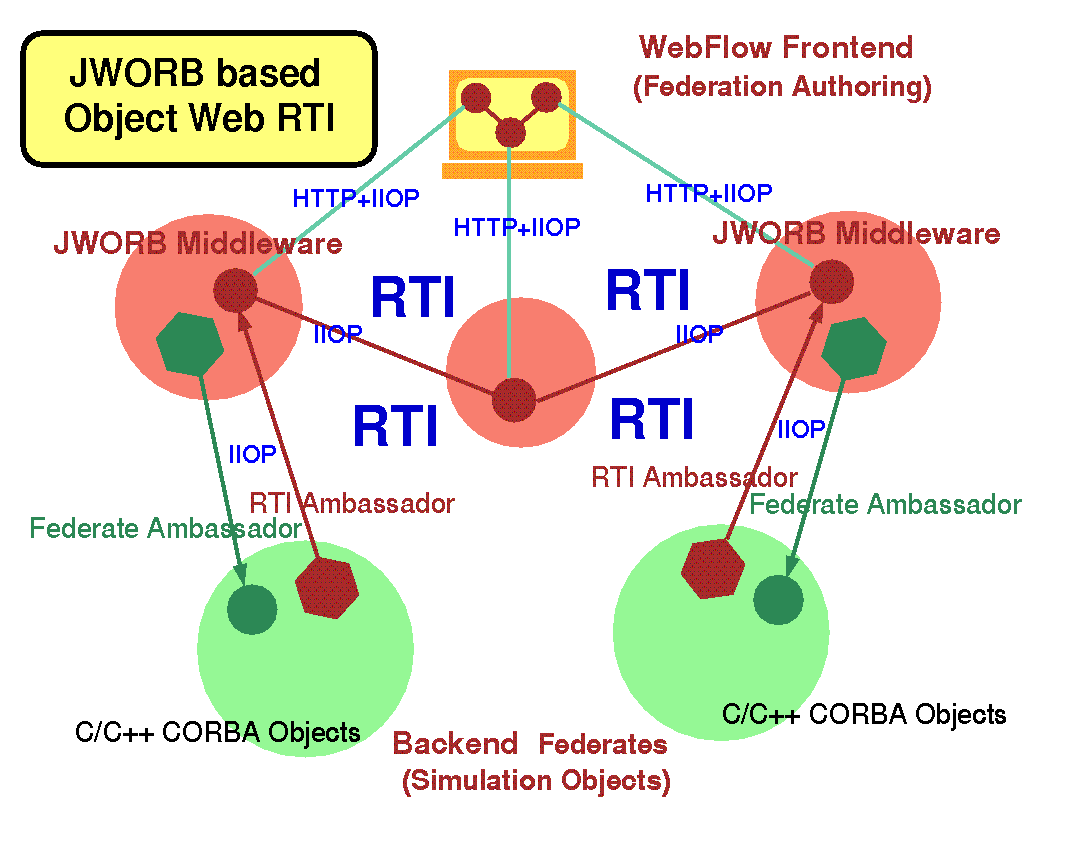
Figure 6.4:
Top view representation of Object Web RTI: RTI Ambassador is Java CORBA object maintained by JWORB middleware; Federate Ambassador is (typically C++) CORBA object maintained by the backend federate; WebFlow front-ends tools are available for visual authoring of federation configuration.
6.2.2 Visual Authoring Tools for HLA Simulations
DMSO has emphasized the need to develop automated tools with open architectures for creating, executing and maintaining HLA simulations and federations. The associated Federation Development Process (FEDEP) guidelines enforce interoperability in the tool space by standardizing a set of Data Interchange Formats (DIF) that are mandatory as input or output streams for the individual HLA tools (Figure 6.5). In consequence, one can envision a high-level user friendly e.g. visual dataflow authoring environment in which specialized tools can be easily assembled interactively in terms of computational graphs with atomic tool components as graph nodes and DIF-compliant communication channels as graph links (Figure 6.6)
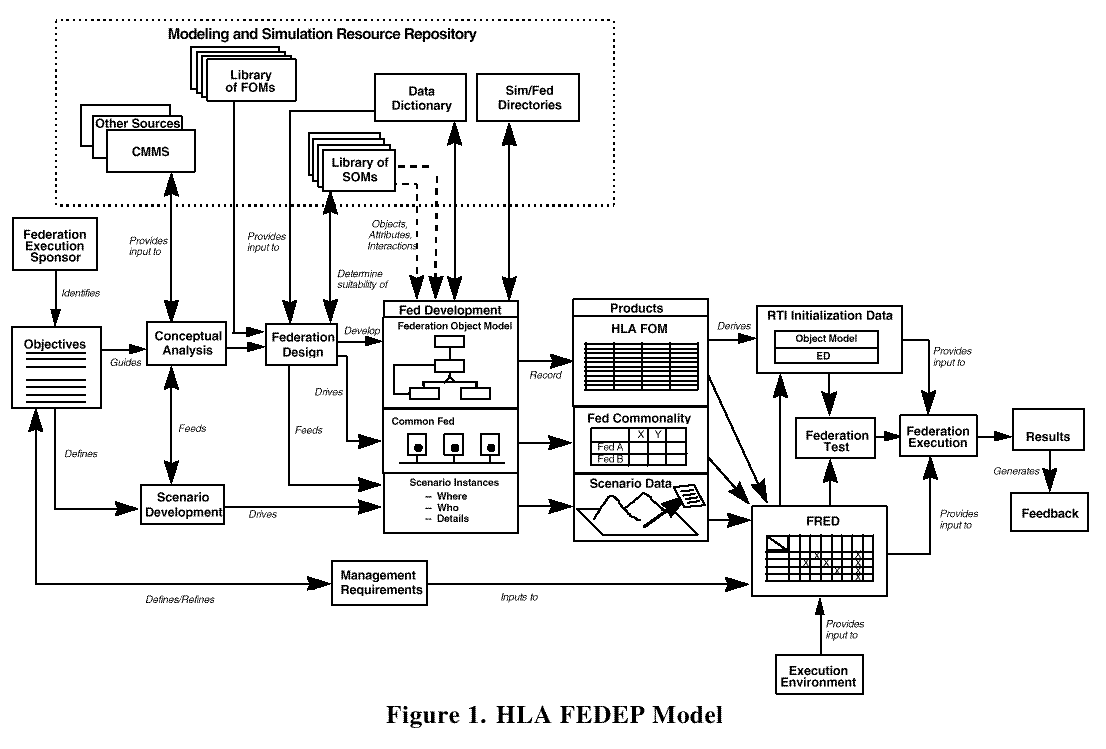
Figure 6.5:
DMSO FEDEP Process including databases, authoring, configuration management, runtime and analysis modules.
To provide a natural linkage between DMSO DIF and the emergent Web data interchange format standards to be formulated within the XML framework, we are constructing a trial mapping between FED and XML which, is used in our current generation tools.
In particular, we defined a trial version of HLAML for Federation configuration file definition. We developed two converter programs which read HLAML and produce DIF or HTML file. HLAML is defined via XML DTD (included below) so that we were able to use free XML parsers. Current OWRTI, uses this file format for federation definition files. Our OMBuilder tool discussed in the following also supports the same file formats so that we can develop federations using this tool and import them easily into our HLA RTI framework.